
ICELAND IN MARCH 2024
In this post I'll show you why I love March in Iceland!
Below, I'll answer all your questions on:
- What to expect when visiting Iceland in March - How, when & where to see the magical Northern Lights - Average weather and temperature in March - Best tour, things to do and activities
This is the Ultimate Local Guide to plan your AMAZING March 2023 holiday in Iceland.
Let's get started!

ICELAND IN MARCH QUICK FACTS:
March in Iceland is packed full of events for visitors to experience.
It's the time of year when improving weather conditions make exploring the country an incredible experience and is technically still in low season – meaning you might have better luck with finding cheap(er) accommodation, flights and tour bookings.
- Average temperature: 32 Fahrenheit
- Sunrise 07:42am / Sunset 19:28pm
- Less crowded / touristy: More availability on tours, hotels etc.
- Good time for northern lights: Yes! (Great time actually)
- Best things to do: View our recommendations for local activities below!
WEATHER / Average temperature IN MARCH
March can definitely be seen as a turning point in the weather in and around Reykjavik. Althouth the average temperature is similar to January and February, the number of hours of sunlight per day begins to increase dramatically!
The average temperature in March in Iceland is 32 Fahrenheit (0°c)

Just because the temperature is rising though doesn’t mean you should leave all the warm clothes at home!
You should definitely make sure to have a waterproof coat, sturdy walking shoes as well as a warm hat, scarf and gloves!
CAN YOU SEE THE NORTHERN LIGHTS IN ICELAND IN MARCH?

Absolutely! March is a fantastic time to see the northern lights.
The beautiful Northern Lights (or Aurora Borealis) can be seen right from down town Reykjavik.
… but it’s unlikely due to the light pollution of the city.
So if you’re looking to maximize your changes of seeing the magical northern lights, you might want to look into joining a small group Northern Lights tour.
The best time to see the Northern Lights in Iceland is anywhere between mid-August to mid-April.
This is usually called the high season for northern lights.
The northern lights are actually always up there, running, dancing and lighting up the sky, all year round but the conditions have to be “perfect” for them to be visible to us - looking up from our planet Earth. These conditions that affect the visibility are electro magnetic activity, light conditions (how dark it is, the darker the better) and how cloudy ut us.
March is still a relatively dark month and weather tends to be even better than the months before – so it's considered a brilliant time to visit Iceland if you want to experience the northern lights in all their glory.
A little Northern Lights motivation before reading any further…
BEST TOURS IN ICELAND IN MARCH
You’re visiting Iceland at a fantastic time of the year - why not add some unforgettable memories to your trip?
Here you’ll find my list of of best tours and activities to do in Iceland during March.
*Keep in mind, all of these tours are really fun (a must try in my opinion), great value for money and they either take place or depart from the central Reykjavik area.
1. THE REYKJAVIK FOOD WALK
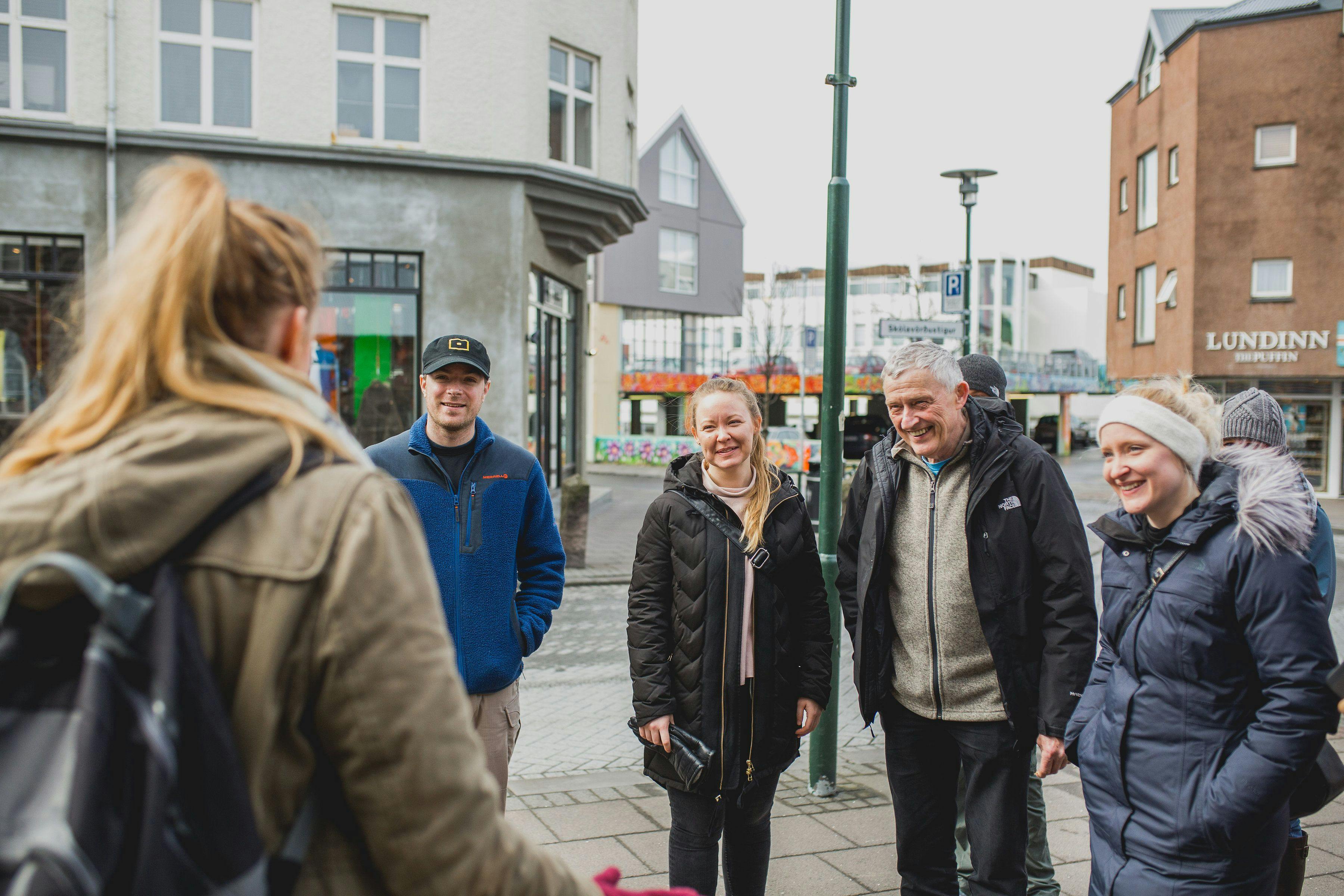
There is no better way to enjoy and really get to know Reykjavik than by joining the Reykjavik Food Walk tour.
You’ll meet awesome locals, see the highlights of Reykjavik and eat some of the best food you can find in Iceland.
The Reykjavik food tour offers all this and more. Spend some time learning to eat like a local while also learning about life in Reykjavik from a real Icelander.
Here are some of my personal highlights from my experience:
- Explore & learn fun facts and stories about Reykjavik
- Enjoying traditional Icelandic meat soup
- Eating freshly caught Arctic Char
- Visiting the famous Icelandic hot dog stand
- Home made Ice cream
All this and much more awaits you!
The Reykjavik Food Walk is currently rated as the #1 Food&Drink experience in Reykjavik on Trip Advisor, with over 4,000+ 5 star reviews.
You can secure your spot on the Reykjavik Food Walk tour here or read the reviews here .

2. ONE OF A KIND NORTHERN LIGHTS ADVENTURE
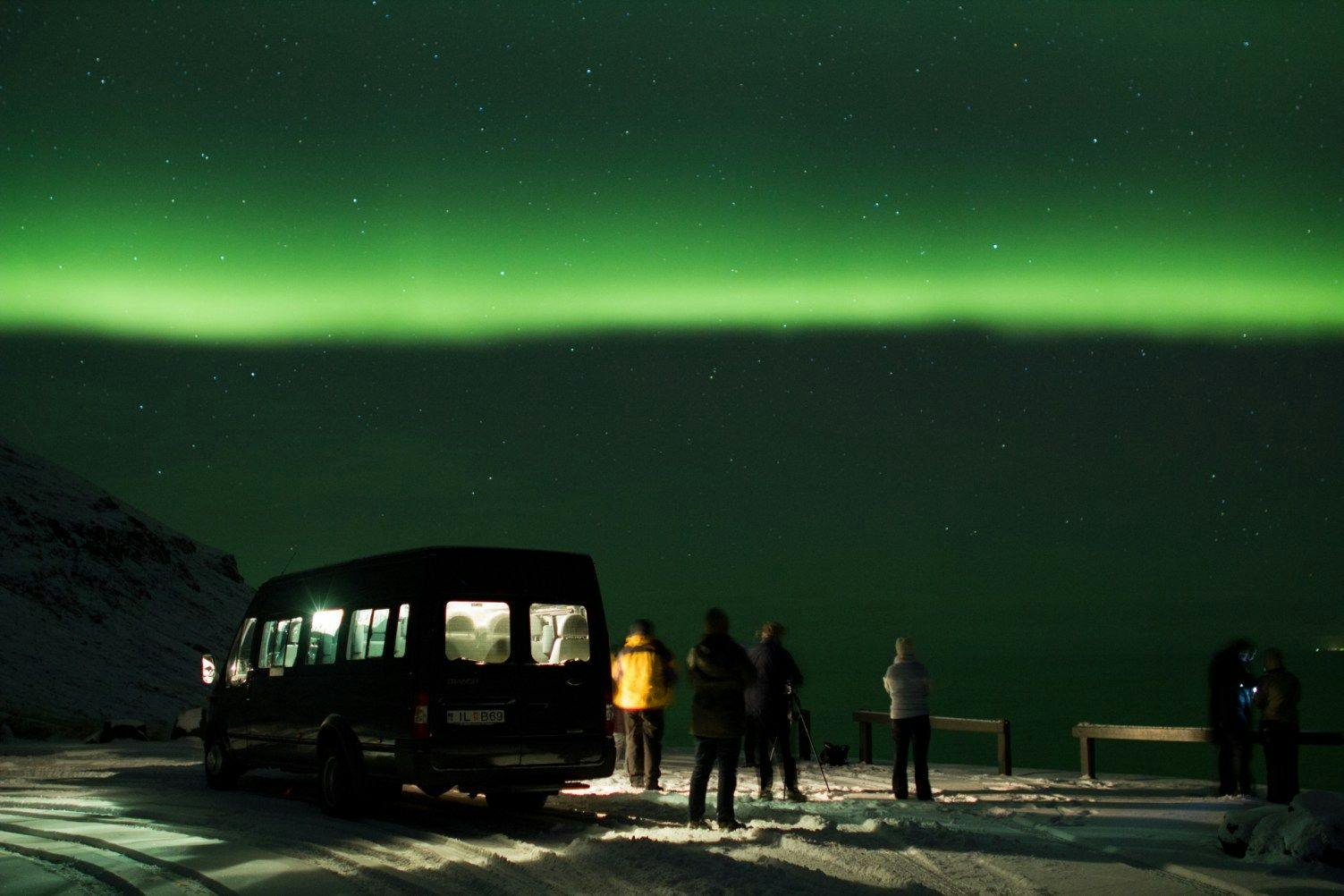
Iceland is one of the best places in the world to see the northern lights!
If you’re lucky enough to be in Iceland during the winter season – I think you’d be crazy not to experience this one of a kind natural phenomenon.
The reasons why I personally recommend you to book a northern lights tour are countless. But here are a few:
You’ll need to drive outside of the downtown Reykjavik area to really see the lights . You can see green glimpses of lights in the city – but that’s very dull and to be honest, nothing special. With the northern lights tour, you’ll be picked up at your accommodation. So there will be no need to rent a car – or drive yourself on the sometimes icy and slippery roads. It’s best to leave that to the professionals.
This particular tour that I recommend (my favorite one) is operated by absolute experts when it comes to the northern lights. They have a team of weather experts that monitor the forecast – and will take the tour to the particular spot each night that has the highest chances of seeing the best lights.
If you don’t see any northern lights – you’ll be able to reschedule the tour or get a full refund. I could go on – but you get the idea!
You can find more information and secure your spot on the northern lights tour that I recommend to all my friends on their way to Iceland right here.
3. GOLDEN CIRCLE TOUR
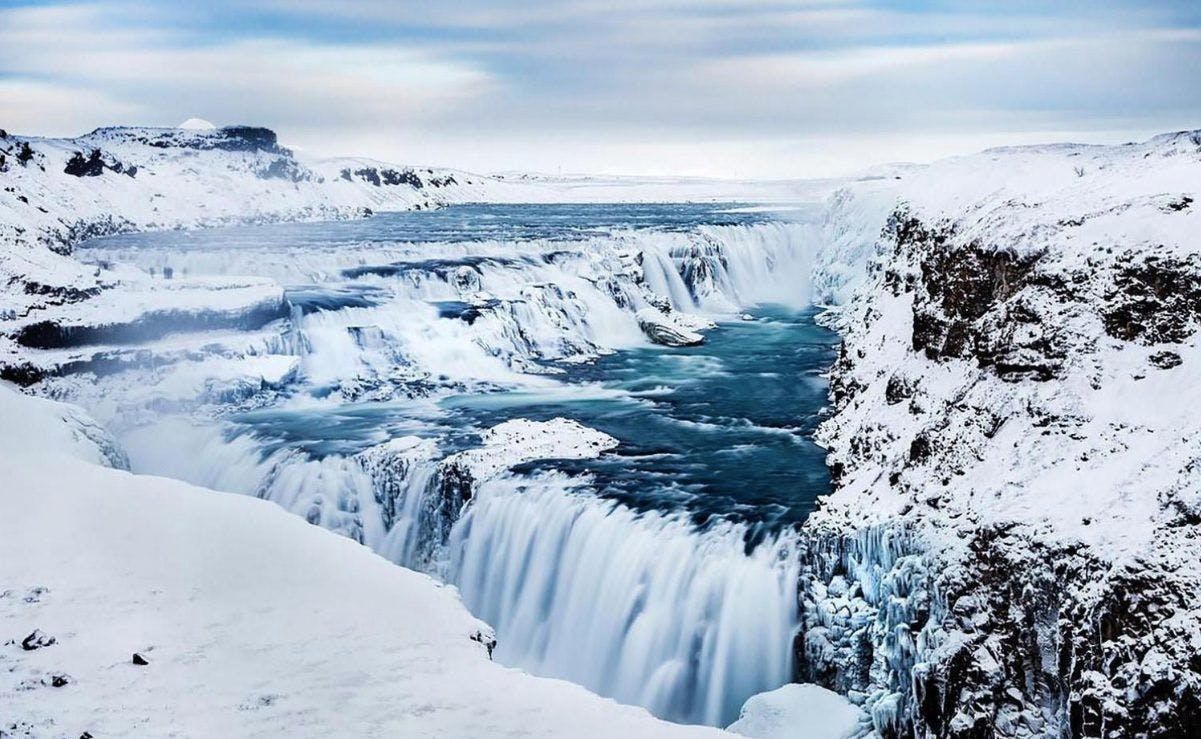
Gullfoss (The Gold Waterfall)
The Golden Circle is a very special tour – for many reasons.
This day tour combines stunning nature with a tremendously rich history. It will all come alive in front of you as you journey from location to location.
The Golden Circle takes you to three ultra-special locations in the south part of Iceland.
- Þingvellir: (Thingvellir) national park, where the world’s first parliament was formed.
- Geysir : the exploding hot spring which gives us the English word Geyser.
- Gullfoss : the golden waterfall that originates from the nearby Langjokull glacier.
For those who want to experience the Golden Circle then I will highly recommend this Golden Circle tour here.
I highly enjoyed it plus it is the no.1 rated Golden Circle tour on Trip Advisor and it’s a small-group tour.
4. SOUTH COAST TOUR
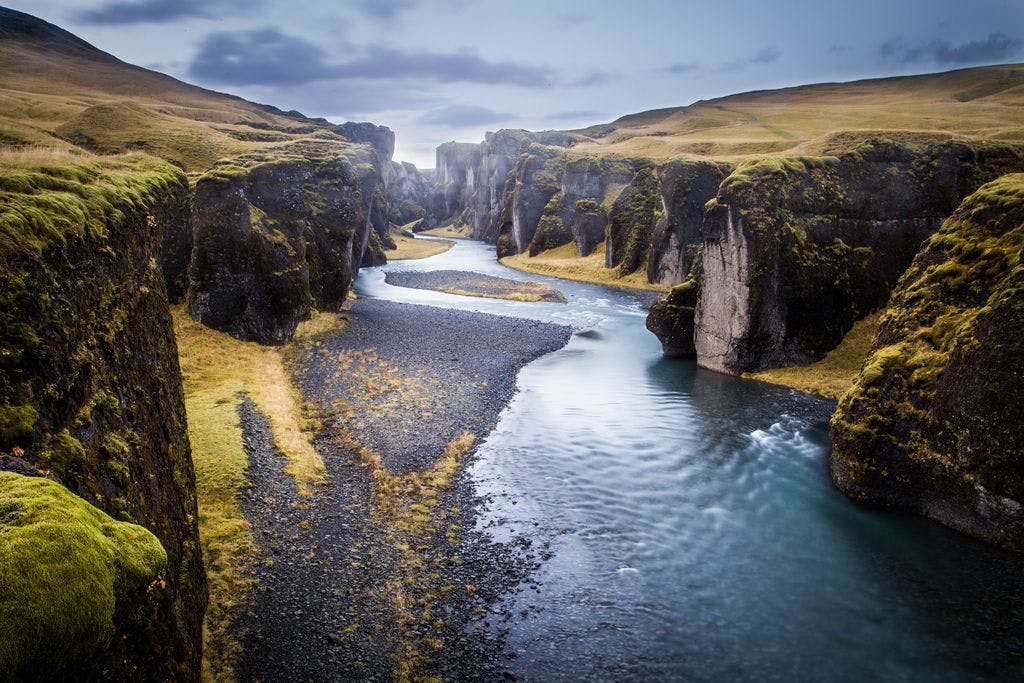
This tour is so fantastic that I have this to say about it:
If you have only one day in Iceland - do THIS! The South Coast small group tour combines the most exciting and stunning sightseeing spots in Iceland, all in one, fun-packed day of adventure.
Powerful waterfalls, glaciers, black sand beach & so much more! Book this tour, get your camera ready & get excited for the unforgettable day ahead!
5. GOLDEN CIRCLE & NATURAL HOT SPRING COMBO TOUR
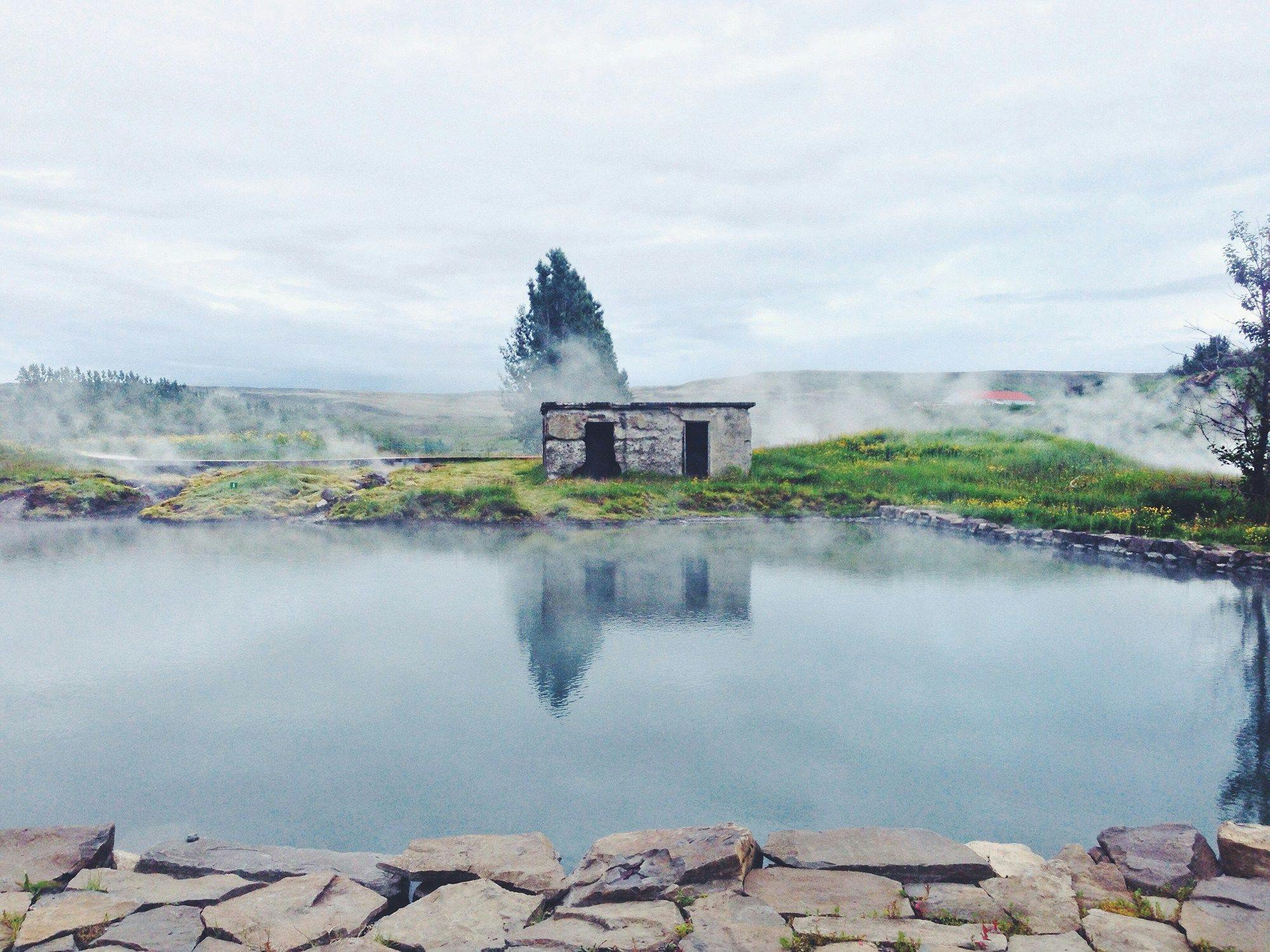
The Secret Lagoon, Iceland
I mentioned the Golden Circle earlier.
Simply because it’s awesome and includes some truly incredible & unique sights to see.
If you’re interested in experiencing the Golden Circle with a twist – then I highly recommend taking a look at the combo tour that includes a visit to the Secret Lagoon, natural hot spring.
It includes all the amazing sights of the Golden Circle but also a stop at Secret Lagoon. Where you’ll bath and relax in a natural hot spring.
This is the perfect way to combine incredible sightseeing with relaxation in a hidden natural hot spring.
You can read more and secure tickets to this awesome experience here .
6. GLACIER SNOWMOBILING & ICE CAVE TOUR
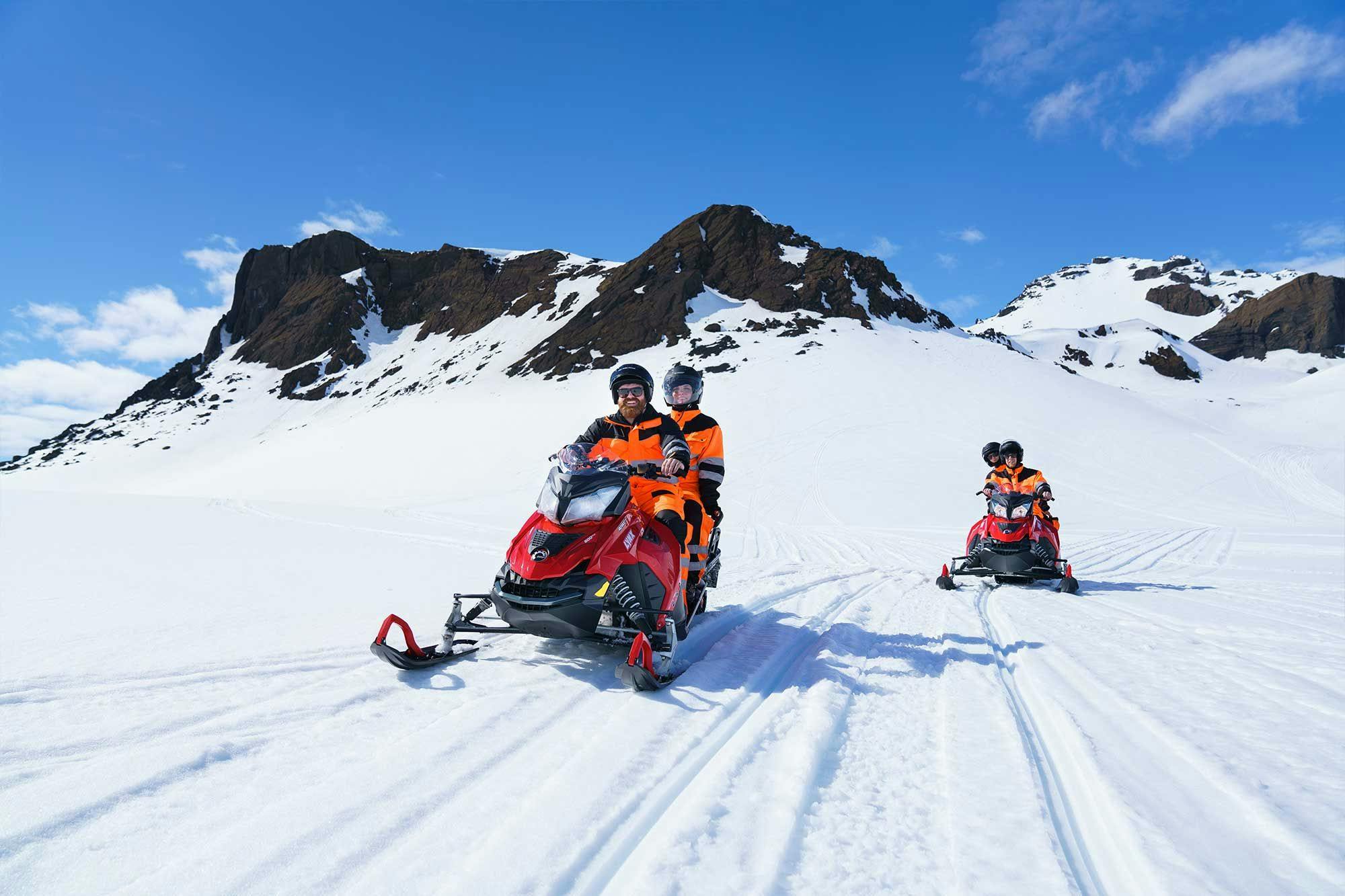
This activity is has been a favorite of mine throughout the years for a few reasons:
- Driving a powerful snowmobile is incredibly fun
- The sights and scenery on the Glacier are breathtaking
- I always bring my GoPro (the helmets have mounts) to capture some incredible footage and memories on film.
- I recently did this with my entire family – and it was a blast.
- As you already know – the nature here in Iceland is incredible as well so the sights and scenery on your way to the glacier are quite spectacular as well.
My mother was a bit hesitant at first (she had never driven a snowmobile before) but at the end of it – I think she had the most fun out of us all.
You can find more info and secure your spots for the snowmobile tour here .
Also! It’s possible to combine this tour with the Golden Circle for a full day PACKED with awesome sightseeing and adventure – you can find that here .
IN CONCLUSION
March is a fantastic time to visit Reykjavik.
You are guaranteed to be absolutely blown away by the sheer amount of things to do. We may have covered quite a lot already but believe me, this is just the tip of the iceberg!
I hope to see you soon!
- Klapparstígur 25, 101 Reykjavík
- [email protected]
- +354 45 40 222
- Our Awesome Blog
- Privacy Policy
Most popular
- Reykjavík Food Tour
- Northern Lights Tour
- South Coast Adventure Tour
- Golden Circle and Hot Springs
- Golden Circle and Snowmobiling Tour
We're socially active
March in Iceland | The Best Way To Do Iceland In March
March is a gorgeous month to visit Iceland . Not only has the weather usually calmed a bit down but the Northern Lights are still at their A game. Another positive point is that the time of daylight is growing rapidly throughout the month, so much so that you are able to see the difference from day to day. In March the environment starts showing definite signs of spring and the locals spend more time outside.
The month of March is the time of delicious food traditions such as the Food and Fun Festival. It is also when many Icelanders like to take time to go skiing. Akureyri , Siglufjordur and Dalvik in the North are popular destinations for ski holidays but they are also known for their excellent Whale Watching tours.
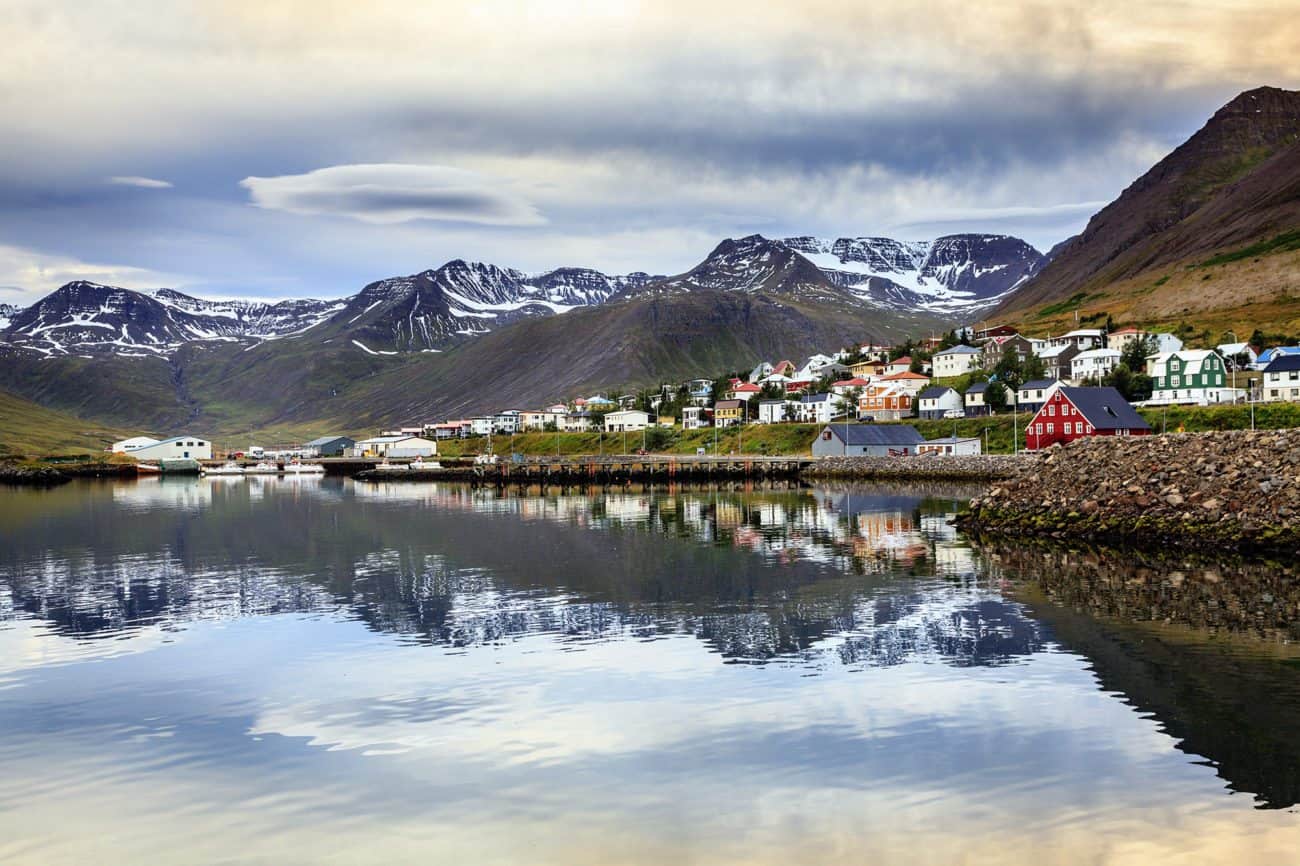
One other important thing to mention about March is the Icelandic Design March . It is an annual festival held in Reykjavik , where exhibitions and shows created by artists and designers are scattered all around the city for you to enjoy. Most of them are completely free and a great way to get to know the design scene of Iceland . Who knows maybe you will even take home a unique souvenir.
Weather in March in Iceland
The weather in Iceland in March is most commonly somewhere around 0°c. The average low being -2.2 degrees Celsius (28 F) and the average high 3.3 degrees Celsius (38 F). March can be a bit rainy so prepare by bringing a waterproof jacket. The farther North you go the rain might switch out for snow. Keep it in mind when packing!

Daylight in March in Iceland
There is a remarkable change between the 1st of March and the 31st of March in daylight but each day is adding about 10 minutes of light. In the beginning, you have about 10 hours of light but by the end of the month, you can expect about 13!
Northern lights in March in Iceland
March is an excellent month to witness the Northern Lights dancing in multicolored waves in the dark night sky. It is often said that the auroras are stronger at the beginning of the season and the end, which March would definitely qualify for. The only real difference is that to see them you might need to stay up a bit longer as the daylight has gotten longer and they can’t really be seen until it gets completely dark.

Check out Northern Lights tours for the perfect March in Iceland Experience and l earn how to take the perfect Northern Lights photo .
What to pack for March in Iceland
Even though the weather is usually a bit warmer in March you will still need to pack all the Iceland essentials. This means wool underwear, a hat, warm socks, and hiking boots. To cover everything you might need to bring we have simply made a ‘Packing for Iceland in March Checklist!’
- Base Layer: Wool Underwear/Thermals
- Thick Socks (more than usual)
- Mid Layer: Thick Sweater
- Thick Pants
- Hiking Boots
- Waterproof Jacket
- Bathing Suit
- Reusable Water Bottle
What to do in March in Iceland
Go road tripping.
March is a great time to visit Iceland , it is somewhat of an offseason so the most popular attractions, for example along the South coast, aren’t as crowded as they are in let’s say mid-summer. Use this to your advantage and take a road trip along the Ring Road or maybe if you have the time do the whole Ring Road and enjoy having the open land to yourself.
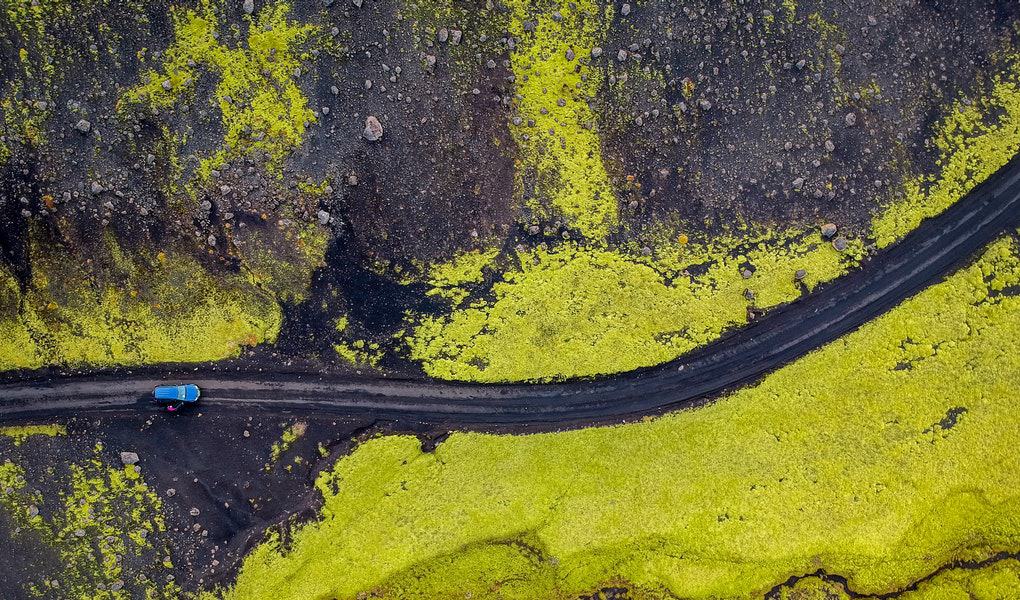
March is a very popular month to go skiing in Iceland and many like to travel up into the Northern part of Iceland to find even better slopes and great powdery snow. Akureyri is famous for being a skiing town and its hills of Hlidarfjall are excellent. It is the perfect city escape!
Walk around Reykjavik
Reykjavik is known as a hipster paradise, with endless quirky places and streets, colorful Instagram-friendly scenes and the most amazing shops and stores. The main street is Laugavegur parallel to Hverfisgata and runs in a cross with Skolavordustigur. All of those should be on your list along with Harpa Concert Hall , Hallgrimskirkja church and Solfarid, the Sunvoyager Sculpture!
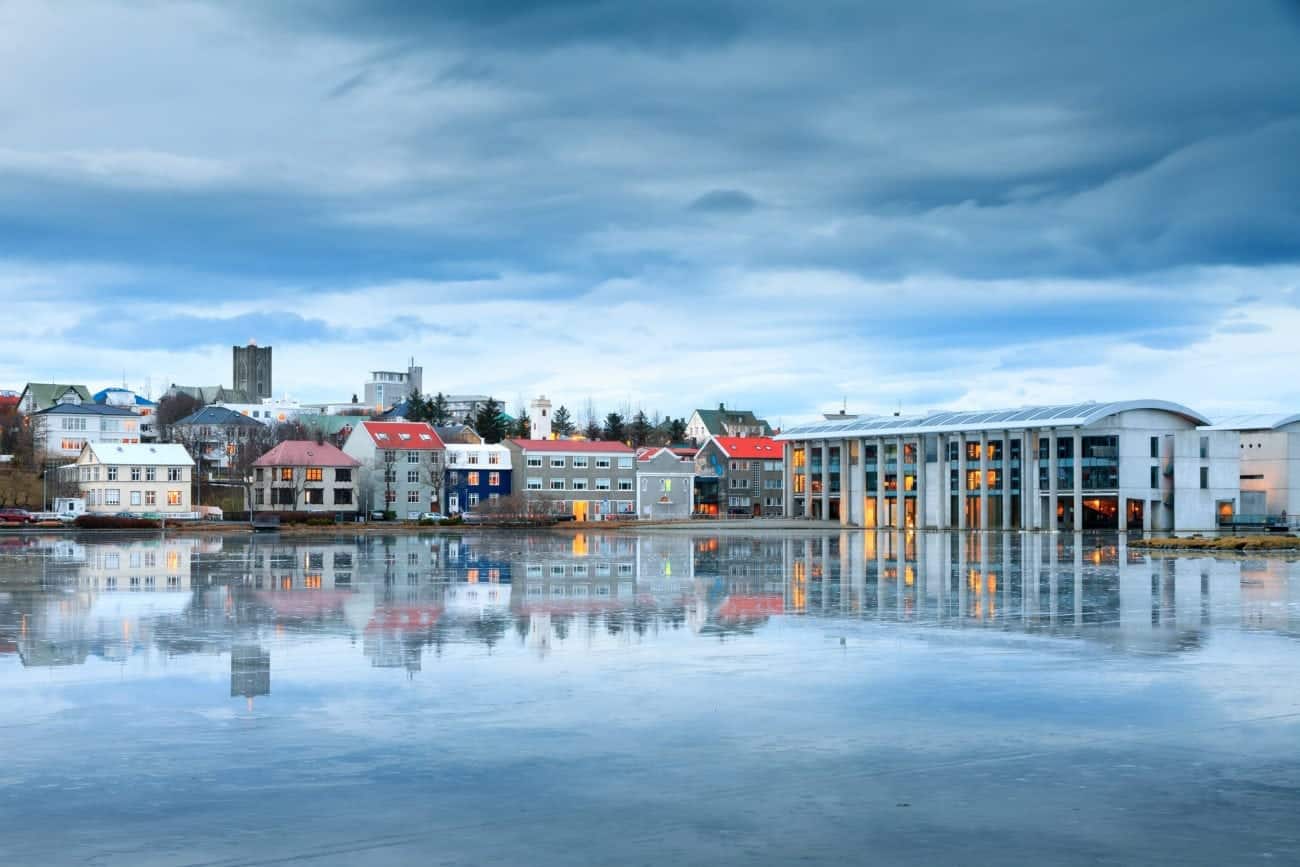
See the Northern Lights
March is a fantastic month to experience the natural phenomenon that the Northern Lights truly are. Make sure to follow the forecast and dress according to the weather. This is going to be a night to remember!
Iceland is known for being one of the countries where the Northern Lights appear in more colors, often red, pink and purple. This is genuinely something you are going to want to be on the lookout for, it’s magical!
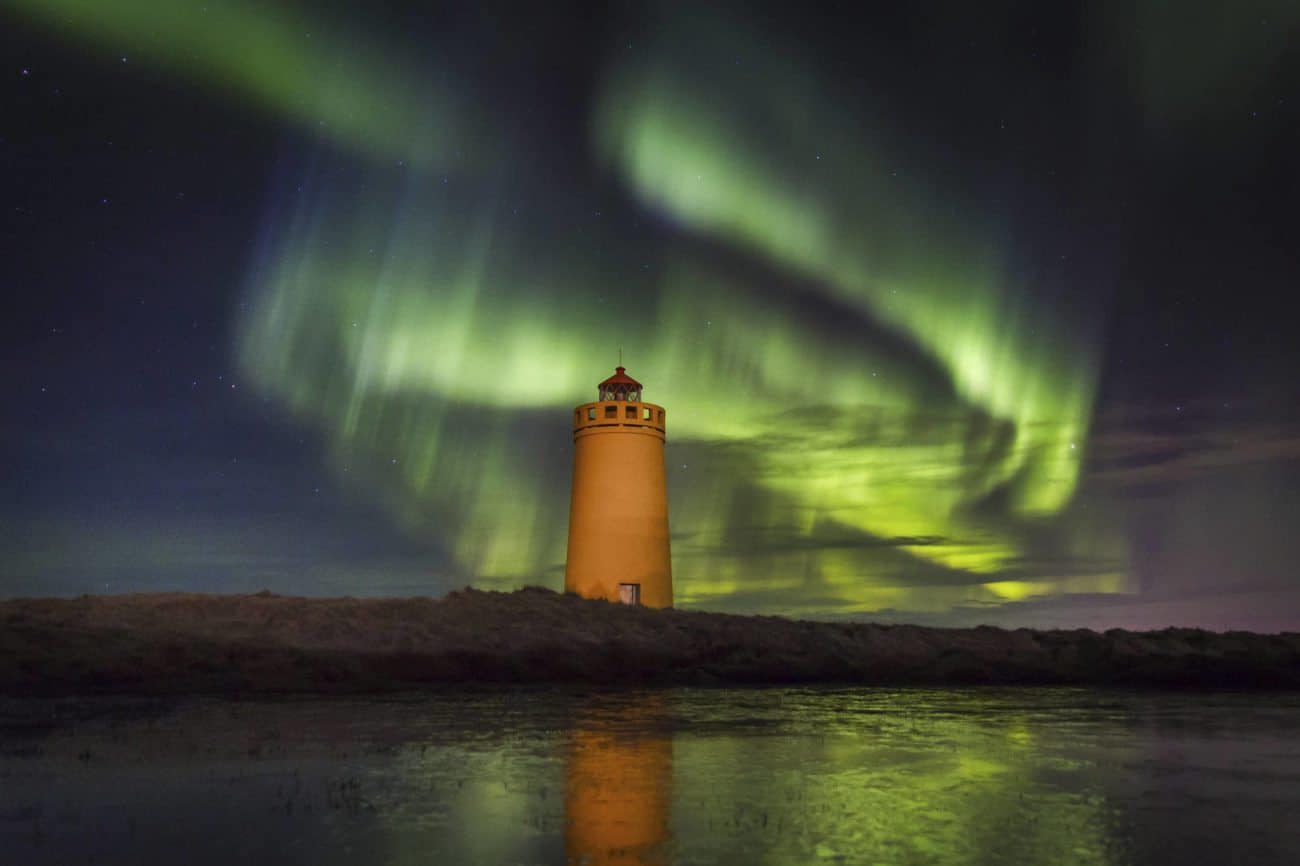
Go Horseback Riding
The Icelandic horse has been a pure breed for over 1000 years which has resulted in its unique gait tolt . The famous tolt is a much softer gait than gallop or trot known more widely. This makes the horse riding experience in Iceland a much more enjoyable one. The Icelandic horse is also very comfortable in size, which makes it easy for you to get on and off. But, the last thing, and really what makes horseback riding in March so great is its fur coat. In wintertime the Icelandic horse grows its coat extra thick, so they literally look like complete furballs. It is impossibly cute! You should definitely think about t aking a horse riding tour or simply visit a farm where you can pet them. The Icelandic horse is famous for its friendliness.
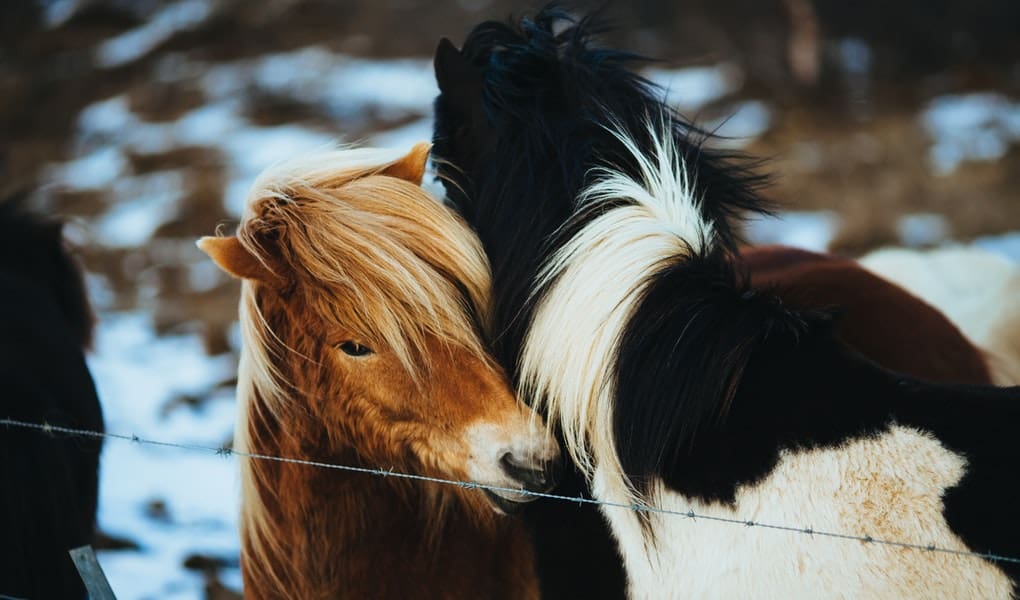
Take a Whale Watching tour
In March the whale herds that leave during the coldest months return to the Icelandic seas. Which means that your chances of seeing multiple breeds are up by substantially. To enjoy this growth you can take a whale watching tour out from the Reykjavik harbor downtown and in only 45 minutes you are far enough to see them. Minke Whales and Humpback whales are the common breeds seen near Reykjavik but the farther North you travel the better your chances are of seeing even variety. Eyjafjordur fjord where the towns Akureyri , Dalvik , and Húsavik are located is famous for being the best when it comes to Whale Watching. From Dalvik they have even seen nine different breeds in one tour!
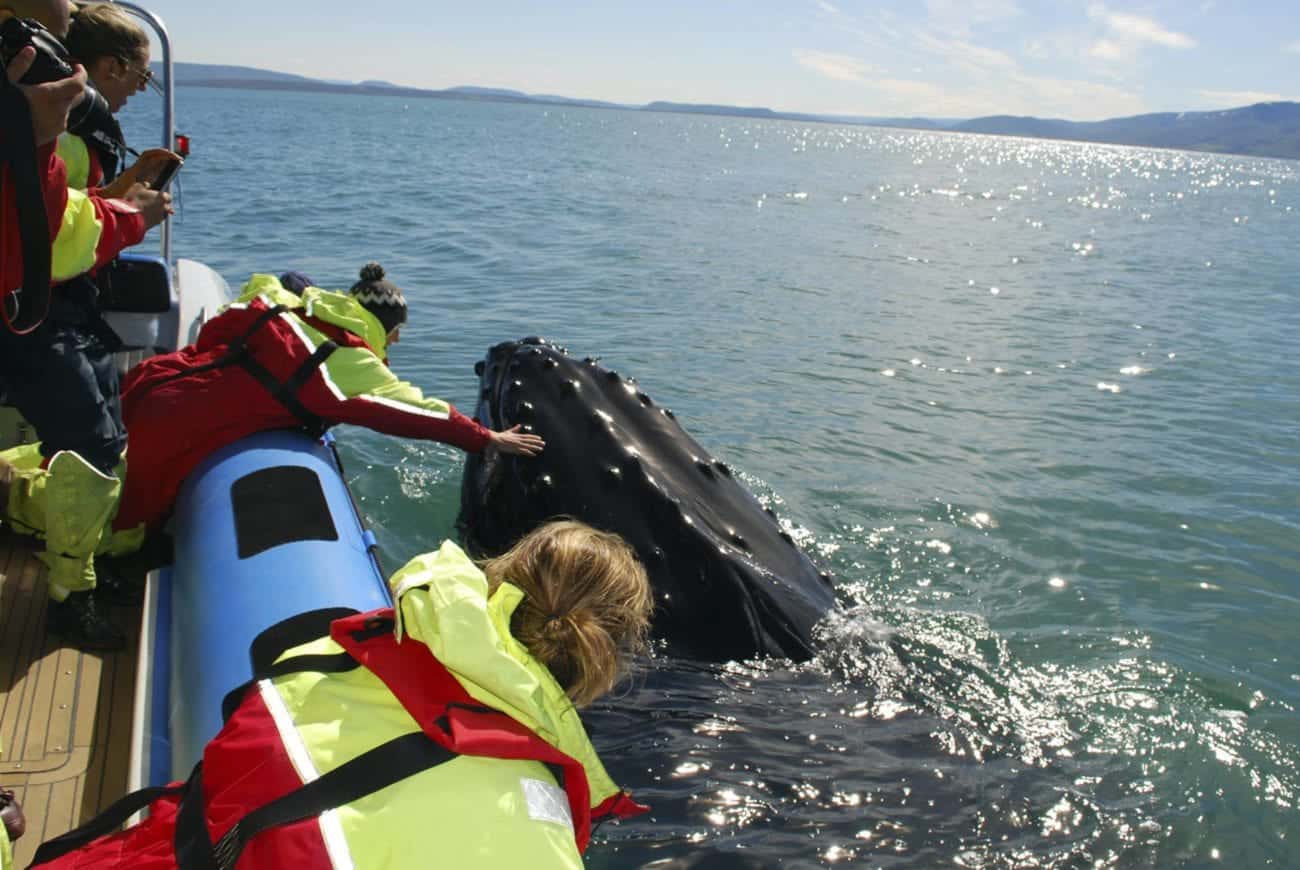
Go Inside an Ice Cave and visit a Glacier
The ice of the glaciers is especially blue during the fall and spring so with March being at the beginning of spring in Iceland you are at the perfect time to experience the meeting of the snowy period and the turquoise blue ice period!
Join a glacier hiking tour, an ice cave tour or possibly even a combo but if you aren’t much into hiking or walking a visit to the Jokulsarlon Glacier lagoon is perfect for you!
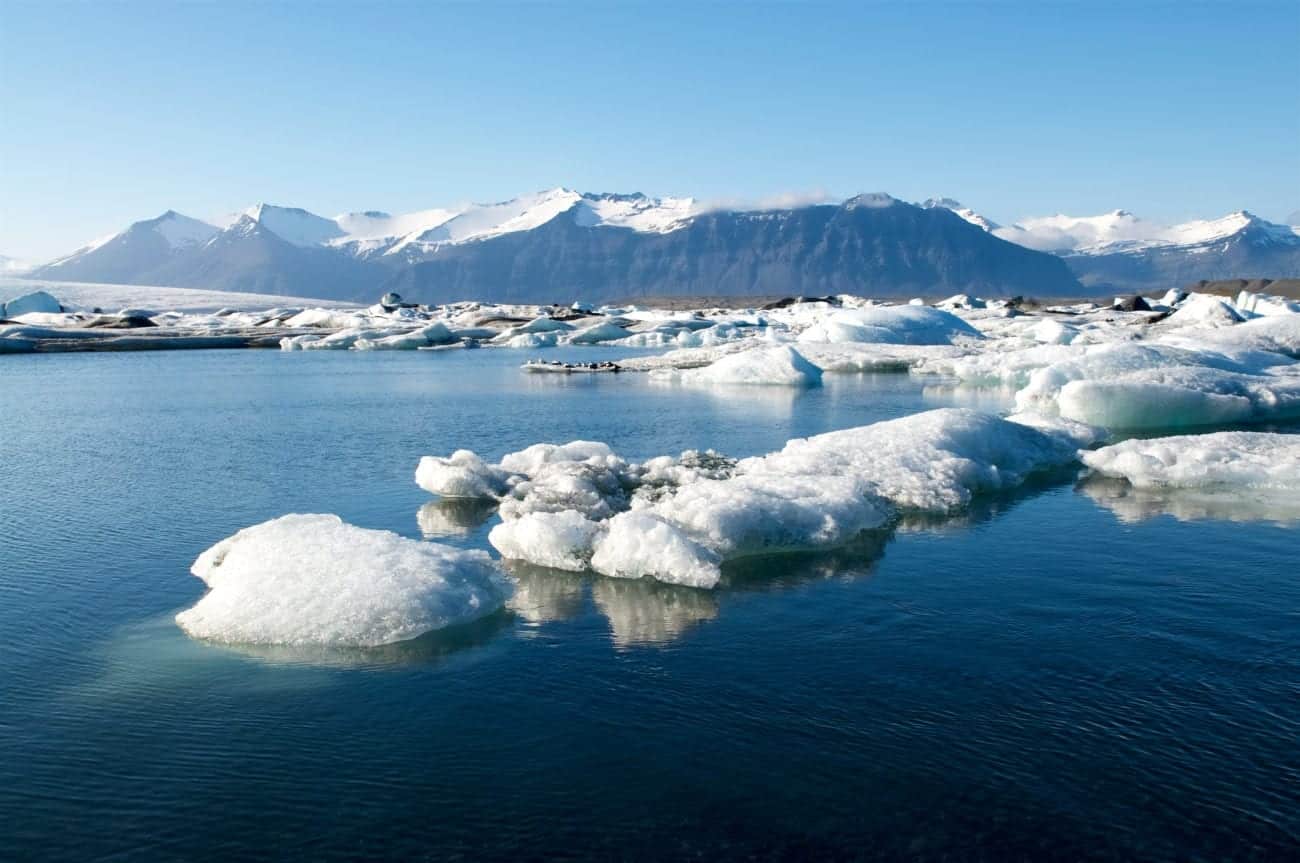
Take part in the National Festivals (see below)
There are so many exciting festivals and Icelandic traditions to take part in Iceland in March that we made a special section to make sure you don’t miss out!
Events and Festivals in March in Iceland
1st of march iceland’s national beer day.
On the 1st of March 1989 beer was officially legal in Iceland again. A beer ban had been in the country for decades so the celebration was understandably ongoing for days. Today we celebrate the dissolution of the beer ban annually on the same day Icelanders were allowed to enjoy ale again. Go downtown for a beer at a much lower price and SKAL with the locals!
Read more about Icelandic Beer

Food and Fun
This is one for the Foodie travelers. The Food and Fun Festival is an annual event where all the best restaurants in Reykjavik get guest chefs to play with their fresh quality ingredients and great a special menu just for the occasion. If there ever was a time to splurge on food, this is it!
Bolludagur – Sprengidagur – Oskudagur
The Food Coma Festival Trifecta. Bolludagur, Sprengidagur and Oskudagur change dates each year and can be at the end of February or at the beginning of March. Either way, you should be able to taste a bolla at the beginning of March as they are available in shops and bakeries.

First comes Bolludagur (always on a Monday) where you are supposed to eat everything in the shape of a ball: meatballs, fishballs and last but not least the very Icelandic Vatnsdeigsbollur, buns which are filled with jam and whipped cream. The tradition is that children prepare these special rods with pom poms at the end called bolluvondur . On the morning of Bolludagur the kids wake up their parents by spanking them with their bolluvondur . They receive in return as many cream-filled bollur as the spanks they manage to do. You can purchase these special cream-filled buns at any local bakery.
Sprengidagur is then held on Tuesday the day after Bolludagur and the word Sprengi means to explode and this is exactly what you are supposed to do, simply eat until you feel like you are going to explode. The menu for Sprengidagur is simple, salted meat and bean soup!
Oskudagur is the thirds day in the trifecta and is Iceland ’s version of Halloween. Children dress up in costumes and walk in groups to shops, companies, and favorites to sing for candy. After having had everything in the shape of a ball on Monday and salty on Tuesday you close the 3-day festival with as much sugar as you can.
Driving around Iceland in March
March is still that time of the year when you need to be alert that the weather might change abruptly and roads close. This is especially important if you are traveling far North or in the Westfjords . But, fear not, just be sure to check the road conditions and weather forecast at least twice a day. The winter season can be quite stubborn and reluctant to leave. This means that there might still be some ice on the roads, especially those less driven.
Ideal tours to do in March in Iceland
Horseback Riding Lava Tour
Golden Circle and Hot Spring Tour
Whale Watching From Reykjavík
Northern Lights Tour from Reykjavík
Glacier Hiking on Sólheimajökull Glacier
- Search Please fill out this field.
- Manage Your Subscription
- Give a Gift Subscription
- Sweepstakes
- Travel Tips
These Are the Best Times to Visit Iceland
Here are the best times to visit Iceland for ideal weather, fewer crowds, and more.
:max_bytes(150000):strip_icc():format(webp)/Brandon-Presser-97a4675f1bb3487b88f06e5e2234eac6.jpeg)
Elizabeth Rhodes is a special projects editor at Travel + Leisure , covering everything from luxury hotels to theme parks to must-pack travel products. Originally from South Carolina, Elizabeth moved to New York City from London, where she started her career as a travel blogger and writer.
:max_bytes(150000):strip_icc():format(webp)/elizabeth-rhodes-25083778bc654f69b30ce8417affc82c.jpg)
Over the last decade, Iceland has become one of Europe's "it" destinations thanks to its ethereal — and highly photogenic — landscapes featuring ancient glaciers and rugged fjords.
Before you book your flight to this popular island nation, you'll want to think about everything you want to see and do on your trip because the time of year can determine what's available. Some attractions, like Iceland's famous hot springs , are open all year, while natural phenomena like the northern lights and midnight sun are best viewed during specific months. Here's a breakdown of the tourist seasons in Iceland:
- High Seasons: June to August and late December
- Shoulder Seasons: September to October and May
- Low Season: November to April, excluding holidays
Read on to learn about the best time to visit Iceland for whale watching, northern lights spotting, and more.
Irjaliina Paavonpera/Travel + Leisure
Best Times to Visit Iceland for Smaller Crowds
The busiest months in Iceland are June, July, and August, when most natural attractions are open and easily accessible. Iceland can stay relatively warm through the first week of October, so planning a September visit can be ideal since most crowds have thinned as children return to school. May, too, provides ample daylight for sightseeing, warmer temperatures, and fewer crowds.
The off-season between November and April is ideal for those looking to escape the hordes of tourists, as long as you don't mind the dark (by mid-winter, expect only five or six hours of daylight). Though some roads are closed, it's a glorious time to enjoy hot springs, backcountry skiing, and tours by snowmobile or jeep. You'll also have a better chance of spotting the northern lights. Tourism tends to pick up again during the holiday season, so avoid December if you're looking for a crowd-free vacation.
Courtesy of Visit Iceland
Best Times to Visit Iceland for Good Weather
During the summer months — July and August — the temperature in Iceland hovers around 50 to 55 degrees Fahrenheit, making it a popular time to visit. And June, with its 24 hours of daylight, sees just about as many tourists as the peak of summer. But even during this season, rain and intense wind are not uncommon. The island's fickle climate often means you can experience all four seasons in a single day.
The weather remains pleasant in September, with temperatures between 43 and 52 degrees Fahrenheit. May is similar, but if you're keen on exploring some of the more remote hills and fjords, it might not be the best time to visit, as some roads remain closed while they thaw from winter's snowy cover. For serious hikers, the best time to visit Iceland is during the summer, when all the mountain roads and famous trails are open and accessible.
Best Times to Visit Iceland for Lower Prices
Getting to Iceland can be relatively affordable, especially compared to other European destinations. Travelers from the United States and Europe frequently find flight deals — keep an eye out for sales on Icelandair and low-cost airline Play to save even more on your journey.
Accommodations, tours, attractions, and meals can be pretty pricey throughout the year, but you might be able to save money by visiting during the off-season, which is typically late fall through early spring, excluding December. Summer is usually the most crowded and expensive time to visit.
Best Time to Visit Iceland for the Northern Lights
You'll need three essential factors to see the aurora borealis: darkness, clear conditions, and a surge in solar activity. The northern lights are often elusive and can easily be marred by transient clouds. To avoid disappointment, travelers should never plan their trip to Iceland solely for the northern lights because the island's weather is too capricious (statistically, there are more clear nights in Yellowknife, Canada , for example.) The best way to optimize your chances of seeing the northern lights in Iceland is by visiting from mid-October through March, when you have extended hours of darkness, and by getting out into the countryside to reduce ambient light pollution.
Best Time to Visit Iceland for Whale Watching
According to Icelandic marine biologist Edda Elísabet Magnúsdóttir, the peak months to go whale watching in Iceland are June and July. During the summer, Reykjavík sees higher numbers of minke whales and dolphins, while orcas congregate in West Iceland along the Snaefellsnes peninsula during the first half of the year.
In northern Iceland, you'll have a wider window to enjoy visits from humpbacks, minkes, and dolphins, which ply the Atlantic from May to August; a few humpbacks even stick around until the end of the year. Blue whales pass through in the summer, too. For best results, head to the charming small town of Húsavík , where you can spot more than 20 species of whales on boat tours that leave from the harbor.
Best Time to Visit Iceland's Hot Springs
Hot springs are intrinsic to Icelandic culture for social as well as wellness benefits. Reykjavík's public pools are open year-round (and are especially invigorating during the dead of winter), but Iceland also has hundreds of hidden "hot pots" that tap directly into the geothermal activity under its lava-ridden surface.
Expert Icelandic mountaineer and cofounder of Midgard Adventure , Sigurdur Bjarni Sveinsson, offers the following advice for hot water hunters: "Check them out during September or, even better, the first half of October, when they're all still accessible by mountain road, but the crowds of tourists have significantly died down."
For travelers who want to visit the Blue Lagoon , the most famous geothermal spa, the best time to visit is during the off and shoulder seasons, when crowds are thinner.
Worst Time to Visit Iceland
Thanks to Iceland's stunning landscapes and seasonal natural phenomena, there's really no bad time to visit. Northern lights seekers flock to the country during the darker winter months, while visitors chasing more daylight opt for summer. Of course, those traveling in the spring and fall can take advantage of more moderate weather and daylight, so the best time to visit Iceland depends on what you want to see and do during your trip.
That said, the warmest months of the year are easily the worst time to visit if you're hoping to avoid the onslaught of tourists. July and August see the highest number of travelers, with big-ticket attractions like the Blue Lagoon, Golden Circle, South Coast, and Jökulsárlón being particularly overrun. If you're planning to visit during that time, consider exploring more remote corners of the island like the Westfjords or East Iceland, which have their own cache of fjords, vistas, and waterfalls that are just as impressive as the natural attractions surrounding the capital — if not more.
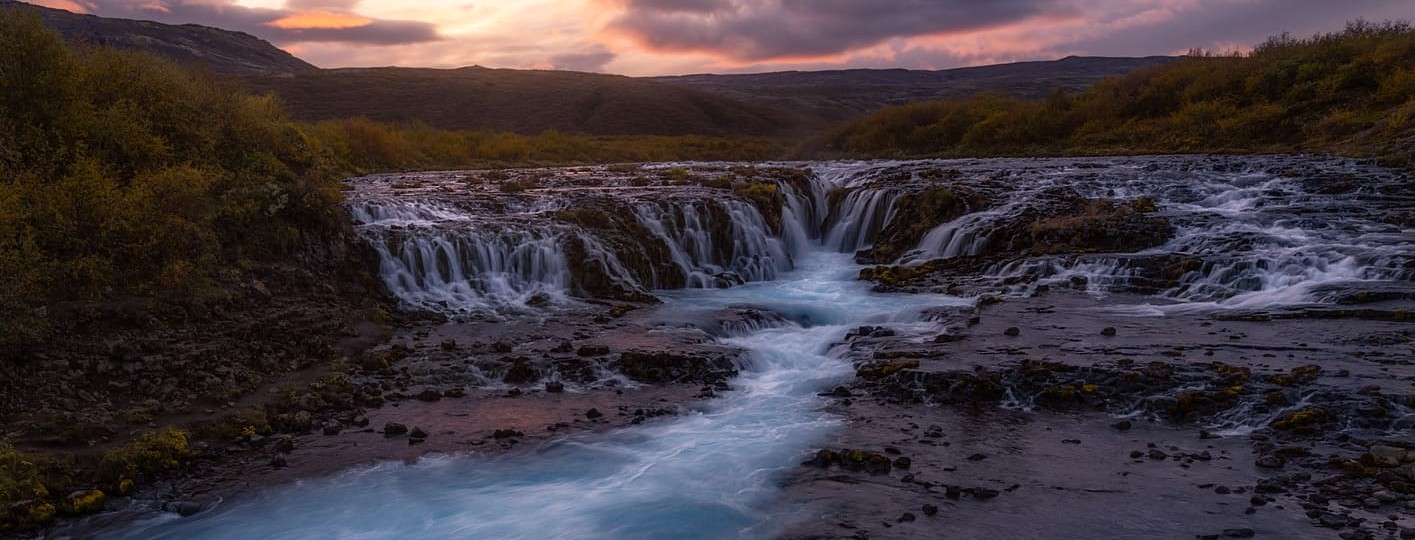
Best Time to Visit Iceland – Weather in Iceland by Month
Home | Travel | Europe | Iceland | Best Time to Visit Iceland – Weather in Iceland by Month
When traveling abroad, get a policy from one of the best travel insurance companies . Y ou can get a 5% discount on Heymondo , the only insurance that pays medical bills upfront for you, HERE!
When you consider all the important factors, the best time to visit Iceland is in September. This month’s average temperature, while unpredictable, isn’t as cold as the winter weather in Iceland . Plus, you can see the first northern lights of the season if you visit in September!
Moreover, Iceland boasts beautiful autumn landscapes full of mesmerizing colors, which is why we run Iceland photo tours during this month.
That said, the weather in Iceland in June , July, and August is best for enjoying the hiking trails. This is also the best time to see whales in Iceland and the friendly puffins that nest on the island.

The winter weather in Iceland is also a special sight to see, thanks to the spectacular white landscapes, which are tinted green at nightfall. This season is also the best time to see the northern lights in Iceland . If you visit in spring, don’t worry because you’ll see dreamy landscapes dotted with wildflowers.
As you can see, deciding on the best time to go to Iceland isn’t easy, but I promise that by the time you finish reading this guide, you’ll know when to travel to Iceland as well as when to return since this country is worth more than one trip.
It’s no wonder why there are Iceland vacation packages available year-round!
When is the best time to visit Iceland?
To help you decide on the best time to travel to Iceland , this guide will cover:
- What is Iceland’s climate like?
Spring weather in Iceland
Summer weather in Iceland
Autumn weather in Iceland
Winter weather in Iceland
At the end of the article, you’ll also find a section where we recommend when to go to Iceland based on your interests (northern lights, midnight sun, whale-watching, puffins, hiking, etc .)
What is Iceland’s climate like? – Weather in Iceland
Unlike other countries at the same latitude, Iceland’s climate isn’t extreme. This is due to the currents from the Gulf of Mexico, which sweep the southern and western coasts, resulting in mild winter and summer temperatures. There are also climate differences within the island; temperatures in Reykjavik are generally higher than in the Highlands.
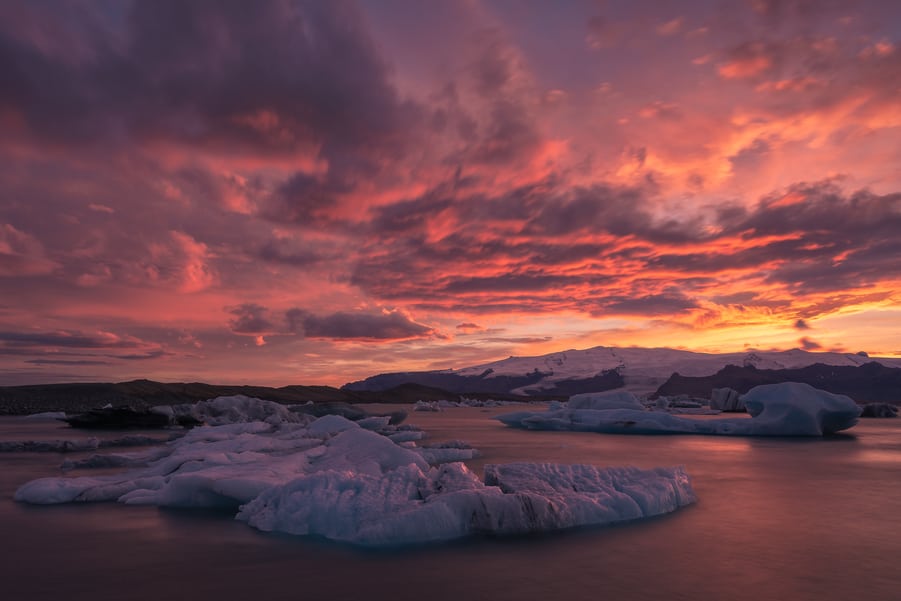
In general, the winter and summer seasons are mild compared to other semi-arctic regions, giving the island a more oceanic climate. However, the weather in Iceland is quite variable throughout the day. This reflects the Icelandic proverb, “If you don’t like the weather, wait 5 minutes!”
Regardless of when you travel to Iceland , I recommend always packing waterproof winter clothes as well as lightweight clothing in case the temperatures rise. You can even bring your swimsuit if you plan on visiting the beautiful hot springs in Iceland .
Average temperature in Iceland
Temperatures in Iceland can vary depending on the region. In Reykjavik, the average winter temperature is 34 or 35 °F, while the median summer temp is 54 °F.
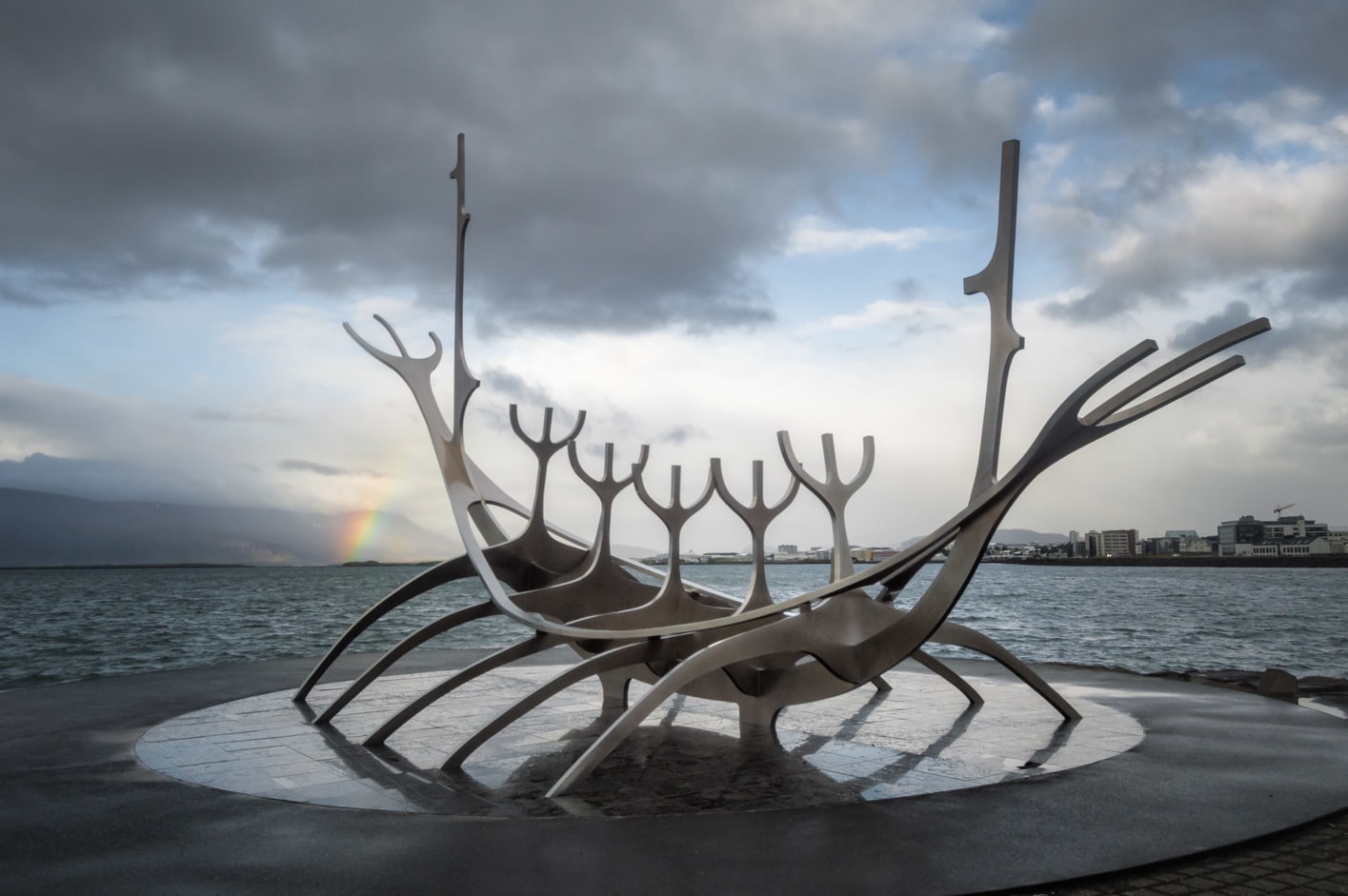
That said, the unpredictable weather in Iceland means that temperatures could drop to 14 °F or reach 77 °F, depending on the time of year. This applies to the entire southern area since, as the distance to the northern shortens, the winters get colder, with more snowfall. There can even be a difference of 5-20 degrees between one region of the island and another.
Average precipitation in Iceland
Precipitation is quite common in Iceland, although most of the rain and snowfall occurs in spring and autumn. The winter weather in Iceland includes rain, snow, and wind gusts, so be prepared.
Rain is especially frequent in Reykjavik, which can see up to 150 days of precipitation per year. In the north, specifically in Akureyri, the average number of rainy days per year is just over 100.
However, as I mentioned, Iceland’s climate is extremely variable, so on any given day, you could run into rain, snow, wind, and sun .
Sring weather in Iceland
Despite the rain, spring is the best time to visit Iceland . The spring season begins in April when the snow starts to melt and the landscape changes over to grass and wildflowers.

The weather in Iceland in April , May, and June ranges from 32° to 50° F, so it’s a colder spring season compared to what you would experience in other European countries. Moreover, the weather is quite variable and can quickly change from rain and wind to sun .
Weather in Iceland in April
Iceland’s spring season begins in April, which is when the winter thaw occurs. While the island’s spring temperatures are considered warm compared to other countries at the same latitude, they’re quite cool compared to other European cities. Temperatures in Iceland in April rarely reach 50° F.
April is also one of the rainiest months of the year, and since it’s a transitional month, it’s not uncommon for it to snow in some areas.
This is the best time to go to Iceland if you want to travel along Iceland’s Ring Road or drive the Golden Circle . Despite the frequent precipitation, April brings forth some lovely spring colors, and the temperatures are pleasant for sightseeing.
- Hours of daylight : 14
- Hours of sunshine: 5
- Average low temperature : 32° F
- Average temperature : 37° F
- Average high temperature : 41° F
- Average rainy days : 18
- Average precipitation : 20mm
- Northern Lights : Maybe
- Whales : Maybe
- Puffins : No
- Highlands open : No
Weather in Iceland in May
By May, spring has arrived in Iceland, so you can enjoy the lovely colors and blossoming flowers.
The weather in Iceland in May is quite pleasant, although it rains frequently. Also, the access roads to the Highlands will most likely be closed if you visit during this month. That said, it’s the best time to travel to Iceland if you’re planning a Ring Road itinerary or you want to drive the Golden Circle . Also, May is when the first puffins start to nest, and more whales begin to appear.
- Hours of daylight : 18-20
- Hours of sunshine : 6
- Average low temperature : 37 °F
- Average temperature : 43 °F
- Average high temperature : 48 °F
- Rainy days : 21
- Average precipitation : 40mm
- Northern Lights : No
- Whales : Yes
- Puffins : Yes
Summertime in Iceland is the perfect time to enjoy outdoor activities since the temperatures are warm, but not uncomfortable.
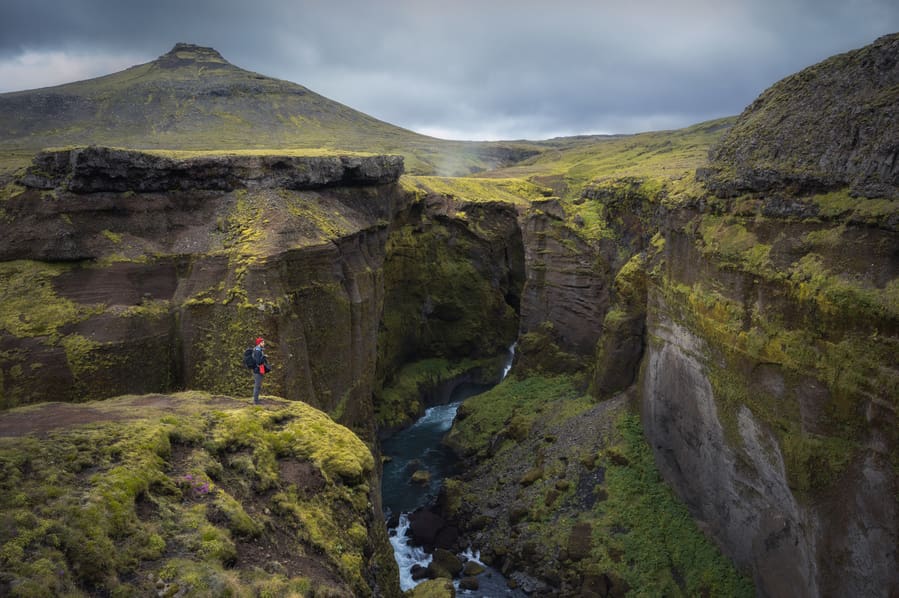
The peak of Iceland’s summer season is in June when the midnight sun shines 24 hours a day. July is one of the warmest months of the year, although you won’t get the suffocating heat and humidity of other European cities. During the summer months, there is less precipitation and wind .
Weather in Iceland in June
In June, you can see the midnight sun, a peculiar phenomenon in which the sun shines 24 hours a day. This makes June one of the best times to go to Iceland . In addition to seeing this natural phenomenon, you can travel throughout the island without any issues since the access roads to the Highlands are finally open. This means that most of the things to do in Iceland are accessible during this month.
Occasionally there may be a colder day, but temperatures tend to be warm.
- Hours of daylight : 20-22
- Average low temperature : 45 °F
- Average temperature : 48 °F
- Average high temperature : 52 °F
- Highlands open : Yes
Weather in Iceland in July
The weather in Iceland in July is warm enough for the lupines to bloom, sweeping the landscapes with purple flowers. Without a doubt, this is one of the best months to visit Iceland if you want to enjoy this country’s natural beauty, including its flora and fauna. There is also lots of daylight in July, and the temperatures are good for walking around outside.
- Hours of daylight : 20
- Average low temperature : 48 °F
- Average temperature : 52 °F
- Average high temperature : 55 °F
Weather in Iceland in August
In August, the island is crowded with tourists, but it’s also one of the best months to visit Iceland if you want to go trekking in the Highlands.
The weather in Iceland in August is warmer than June and July, and there is less precipitation. There are also several festivals and events, as well as a variety of outdoor activities you can do.
- Hours of daylight : 15-16
- Hours of sunshine : 5
- Average low temperature : 46 °F
- Average high temperature : 56 °F
- Rainy days : 23
- Average precipitation : 30mm
Autumn is also a beautiful time to visit Iceland since the landscape is tinged with gorgeous fall foliage. Moreover, Iceland’s temperatures are still pleasant in autumn, even if they drop a few degrees and there are some rainy or windy days. Just be aware that in some areas, it can snow during this season.
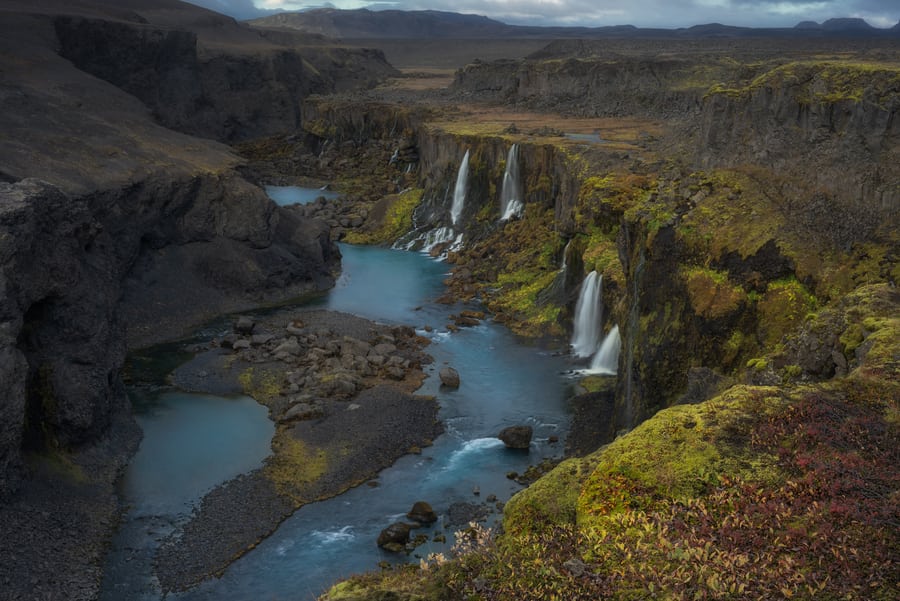
Along with the pretty reds, oranges, and yellows, you can also see the green shades of the aurora borealis since September is the best time to visit Iceland to see the start of the Northern Lights .
Weather in Iceland in September
Iceland is full of incredible fall landscapes in September, and this is when the first Northern Lights appear in the sky. This is the best time of year to visit Iceland if you like landscape photography since you can capture amazing shots of the green moss sprinkled into the red and orange autumn hues.
- Hours of daylight : 12-13
- Hours of sunshine : 4
- Average low temperature : 41 °F
- Average temperature : 45 °F
- Northern Lights : Yes
Weather in Iceland in October
October brings the first snowfall of the season, so the access roads to the Highlands begin to close. During this month, there aren’t too many tourists, so it’s the best time of year to visit Iceland if you’re looking for some peace.
While visiting Iceland in October, the temperatures don’t get too low, so it’s still possible to travel around the island without being sidetracked by snow. It’s also an ideal month if you’re looking for the best time to see the Northern Lights in Iceland . In short, October is a good time to enjoy a bit of everything Iceland has to offer.
- Hours of daylight : 9
- Hours of sunshine : 2
- Average low temperature : 36 °F
- Average temperature : 39 °F
- Average high temperature : 43 °F
Iceland’s climate in winter isn’t too harsh, although some regions can see temperatures as low as -4° F. In addition to snowfall, strong winds are quite frequent, but again, the weather in Iceland is variable year-round. So, it’s important to keep a close eye on the forecast and road conditions, especially in the winter months.
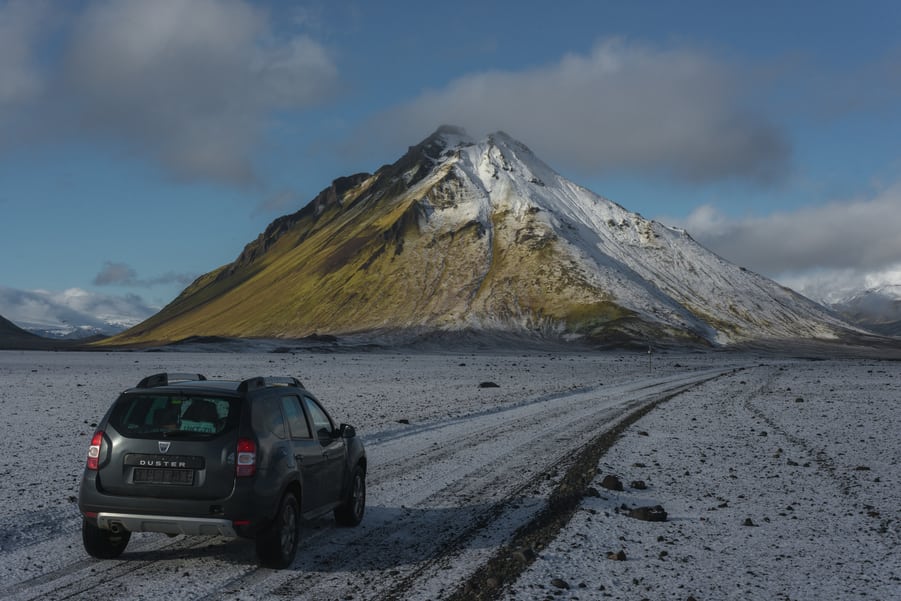
This time of year is also very pretty, as the landscape turns white and green at night when the Northern Lights appear.
If you’re going to travel during the winter season, I recommend checking our guide to driving in Iceland .
Weather in Iceland in November
November is the best time to visit Iceland and spot killer whales around the Snæfellsnes Peninsula and along the south coast. Trust me when I say that whale-watching in Iceland is one of the best things you’ll experience during your trip.
It’s also one of the best months to visit Iceland if you want to see the Northern Lights, although you’ll need the weather to cooperate and give you cloudless skies.
- Hours of daylight : 5-6
- Average low temperature : 32 °F
- Average temperature : 37 °F
- Average high temperature : 41 °F
- Rainy days : 20
Weather in Iceland in December
Celebrating Christmas in Iceland can be a magical experience thanks to the snow-covered landscapes. December marks the start of winter, so it’s when the temperatures are at their lowest. However, this is also one of the best times to visit Iceland’s hot springs , especially Blue Lagoon . Soaking in an outdoor thermal bath while you’re surrounded by wintry scenery is a spectacular thing to do in Iceland.
- Hours of daylight : 4
- Hours of sunshine : 0
- Average low temperature : 30 °F
- Average temperature : 36 °F
- Average high temperature : 39 °F
- Rainy days : 19
Weather in Iceland in January
January is the least touristy month of the year, so it’s also the cheapest time to travel to Iceland . Not only that, but the snowy landscapes are beautiful and there are tons of outdoor activities to enjoy. Again, this is a good month to visit Blue Lagoon and other hot springs around the island.
- Hours of daylight : 5
- Hours of sunshine : 1
- Average low temperature : 27 °F
- Average temperature : 32 °F
- Average high temperature : 37 °F
- Average precipitation : 50mm
Weather in Iceland in February
In February, the Icelandic landscapes are still snowy, so it’s a beautiful time of year to visit. During this month, you can also see some frozen waterfalls. While there are several gorgeous waterfalls in Iceland , seeing them frozen in the winter months is a unique experience.
- Average low temperature : 28 °F
- Average high temperature : 36 °F
- Rainy days : 16
Weather in Iceland in March
By March, the first signs of spring are appearing, so the climate in Iceland begins to improve. Moreover, there are usually fewer clouds and high KP rates coinciding with the spring equinox, making March one of the best times to see the Northern Lights in Iceland .
That said, there is still snow, but the temperatures in Iceland will be more pleasant even if it’s cold. Plus, there are more hours of daylight so you can take advantage of your trip.
- Hours of daylight : 11
- Rainy days : 18
What is the best time to go to Iceland?
I can’t say which is the best month to visit Iceland since each one has its distinct appeal. Therefore, any time of year is a good time to visit this country, although I recommend choosing a month that coincides with your interests.
To make it easier for you to decide, I’ll share the best time to do the most popular activities in Iceland.
Best time to visit Iceland for the Northern Lights
Best time to go hiking in Iceland
Best time to see whales in Iceland
Best time to see puffins in Iceland
Best time to see the midnight sun in Iceland
Best time to visit ice caves in Iceland
Cheapest time to travel to Iceland
If you’re wondering about the best time to visit Iceland for the Northern Lights , I suggest reading our guide on where and when to see the Northern Lights in Iceland . Winter is the best season, especially in March when there are fewer clouds and high KP rates that coincide with the spring equinox. However, mid-September to mid-April is also a good time to see auroras.
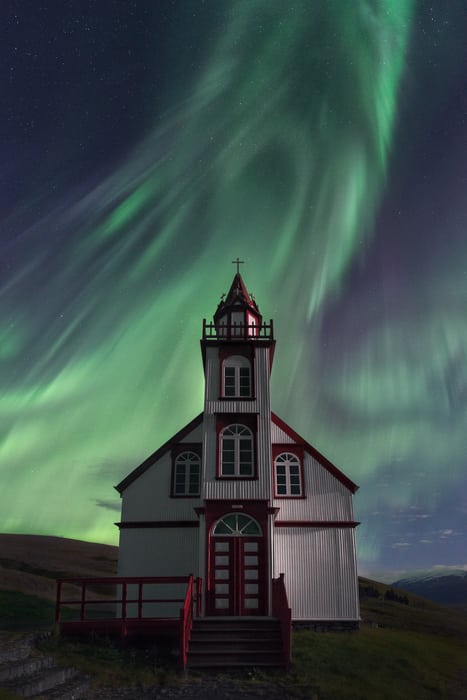
I recommend taking a Northern Lights tour from Reykjavik for those who aren’t sure how to spot the aurora borealis or those who have never seen them. During the tour, expert guides will take you to the best places where the sky conditions favor the Northern Lights. I recommend this tour in particular because you can repeat it free of charge if you don’t see any auroras your first time.
Also, if you can, be sure to stay at one of the best Northern Lights hotels in Iceland .
The summertime is the best time to go to Iceland if you want to go hiking. During the summer months, the climate is quite pleasant, and you can get to the Highlands of Iceland without any issues. Also, it’s when the best campsites in Iceland are open.
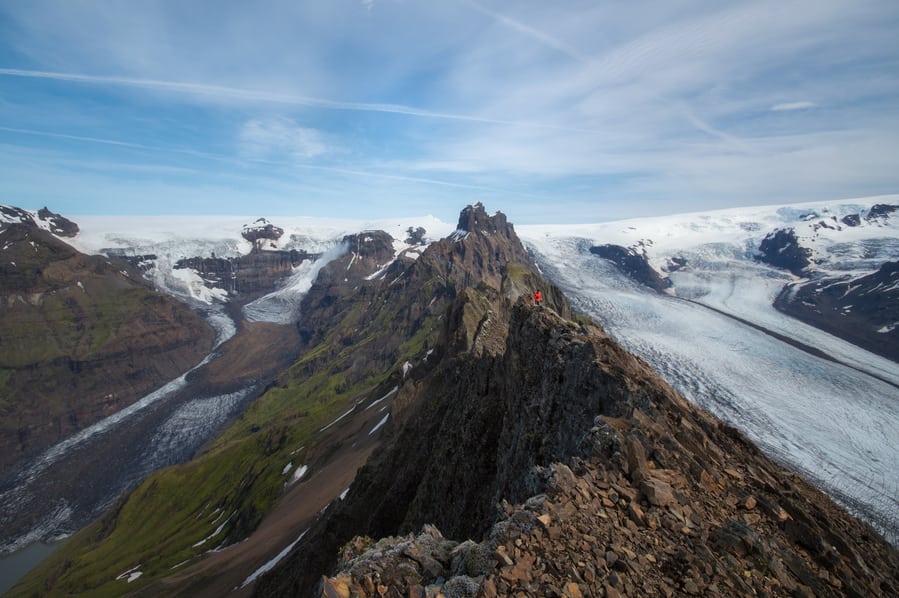
It is precisely in the Highlands that you’ll find the best hiking routes. So, if your goal is to take some beautiful treks, then June, July, August, and September are the best months to visit Iceland . July, in particular, is the most ideal month since the temperatures are very nice and the days are longer .
The best time to visit Iceland for whale watching is from June to August, although you can spot cetaceans year-round, especially from Reykjavik.
If you’re longing to see whales in Iceland, I suggest visiting the country during the summer months because it can be hard to spot them in the winter. That said, if you travel in the winter months and book a tour in Reykjavik, you’ll have a higher chance of seeing whales. Plus, they’ll let you repeat the tour for free if you don’t see any cetaceans the first time.
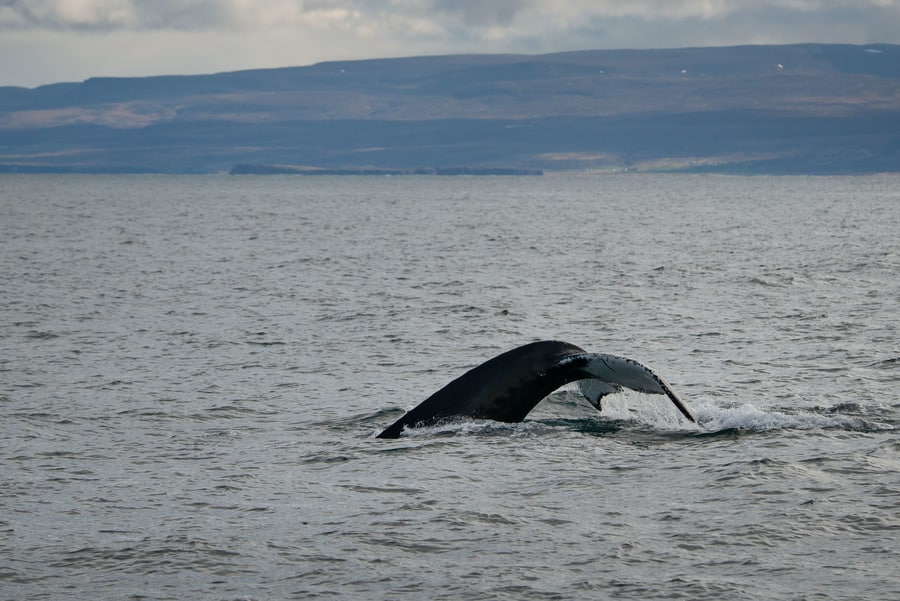
For summer tourists, the best tours depart from Húsavik and Akureyri. We loved this excursion , but you can also check our guide to the best whale-watching tours in Iceland .
The best time to see puffins in Iceland is from April to August. These small birds come to the island every spring to mate, so it’s easy to spot them on the cliffs in southern Iceland. If you want to see these cute creatures, I recommend visiting the basalt cliffs in Vik or Dyrhóaley.
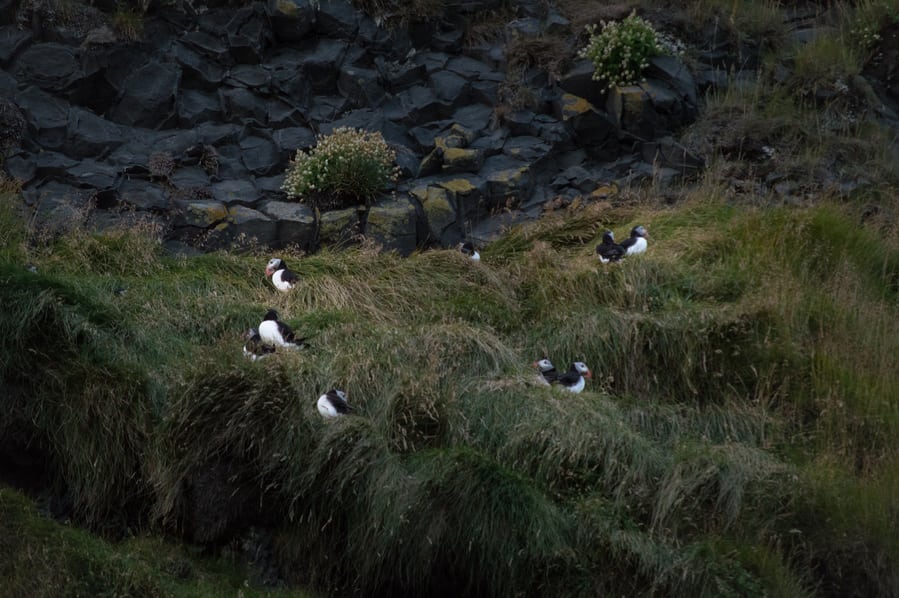
You can also book a tour to see puffins, and I recommend this excursion that departs from Reykjavik .
Along with the Northern Lights, the midnight sun is one of Iceland’s most popular phenomena. While we haven’t had the opportunity to see it yet, we plan on doing so during one of our upcoming trips to Iceland.

The best time of year to visit Iceland if you want to see the midnight sun is during the summer solstice, which occurs around June 21st. During this time, the sun shines for 24 hours a day in the Icelandic region above the Arctic Circle. So, to fully experience the midnight sun, you’ll have to travel to the north of the country .
The best time to visit ice caves in Iceland is in the winter since the caves require low temperatures to form large masses of ice. The summer temperatures in Iceland are too warm to sustain the caves, so if you want to see these unique formations, plan your trip between mid-November and mid-March.
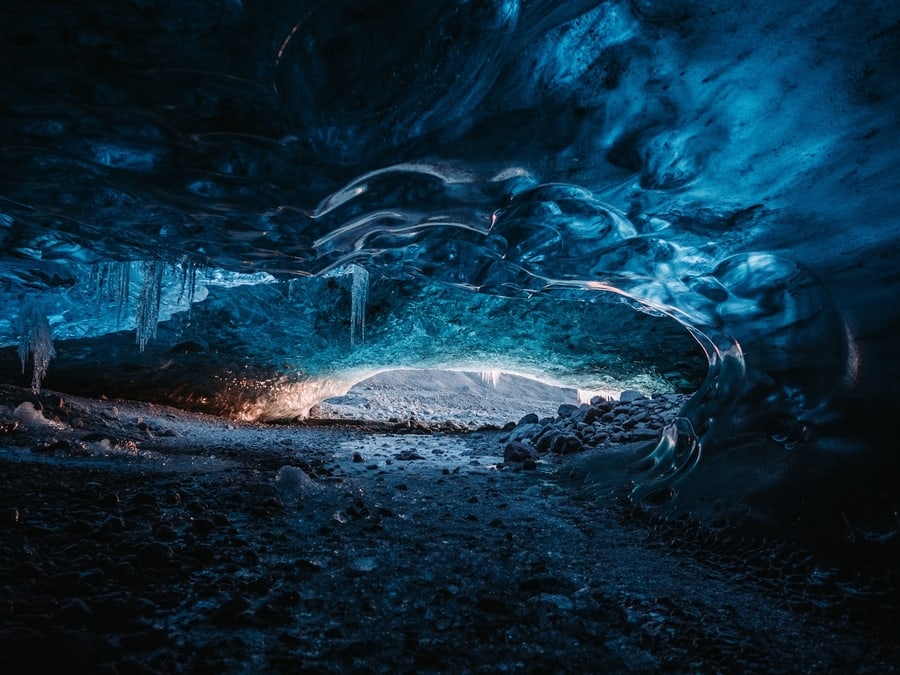
February is the best month to visit Iceland if you want to see the ice caves, particularly the deep blue caverns in the Vatnajökull glacier. I recommend booking this tour to see the full splendor of this beautiful cave.
The best thing about these caves is that they’re different every year. That is, the shapes and sizes vary depending on how the ice masses formed, so no matter how many times you visit, it’ll be a one-of-a-kind experience .
If you’re looking for the cheapest time to visit Iceland , come here during the winter months. Between January and May, the tourism industry slows down, so you can find great prices on flights and accommodations. Prices are especially low in January!
That said, some hotels close during this time, so be sure to do your research before booking your trip. Fortunately, you won’t have any trouble deciding where to stay in Iceland because plenty of hotels are open year-round.

From June to December, prices go up for Iceland’s peak tourism season. If you’re going to visit during these months, I suggest booking your accommodation in advance since lots of tourists will be traveling here, especially in August.
Iceland may seem an expensive country so check our guide on how to travel on a budget for some tips and tricks!
Best month to visit Iceland
As you may have already discovered, there is no best month to visit Iceland because each season has something special to offer. If you decide to travel during the winter months, you can enjoy lovely snow-covered landscapes as well as ice caves, frozen waterfalls, and the Northern Lights.
If you visit during the spring, you’ll have the chance to see the winter thaw and drive along the Ring Road or the Golden Circle, two popular road trips that take you to some of the best spots in Iceland.
Summer is the best time to see puffins in Iceland , as well as whales and the midnight sun, while autumn in Iceland is a magical season full of gorgeous colors and foliage.
To summarize, here is what you can do based on the weather in Iceland by month :
I hope that now you feel more confident about deciding when to travel to Iceland so you can enjoy the activities that interest you most. I can assure you that you’ll fall in love with this country regardless of when you visit. Finally, remember to check what the weather will be like tomorrow by going to the official Icelandic weather website, Vedur.is .
If you have any questions about the best time to go to Iceland , leave me a comment below and I’ll try to help you as much as I can. I hope you enjoy this lovely country as much as we do! Safe travels!
Don't miss a 5% discount on your HeyMondo travel insurance
and the only one that pays all your medical bills upfront for you!
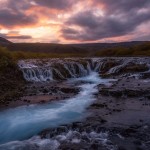
Ascen Aynat

Leave a Reply Cancel reply
Your email address will not be published. Required fields are marked *
This site is protected by reCAPTCHA and the Google Privacy Policy and Terms of Service apply.

- Meet the Team
- Work with Us
- Czech Republic
- Netherlands
- Switzerland
- Scandinavia
- Philippines
- South Korea
- New Zealand
- South Africa
- Budget Travel
- Work & Travel
- The Broke Backpacker Manifesto
- Travel Resources
- How to Travel on $10/day
Home » Europe » Best Time to Visit Iceland – MUST READ • 2024 Guide
Best Time to Visit Iceland – MUST READ • 2024 Guide
Iceland, the Land of Fire and Ice, is a land of extremes. From the midnight sun to the Northern Lights, and from striking volcanic landscapes to incredible wildlife, this far-flung island is a feast for the eyes.
Because the seasons vary so dramatically this far north, choosing the best time to visit Iceland is really going to depend on what you’re heading there to experience. But no season should be discounted as there’s plenty to see at any time of year.
While a visit to Iceland is off the well-worn tourist path, certain experiences and seasons attract a large number of tourists and should be booked well in advance.
Winters in Iceland are brutal, but if you’re well prepared with the right gear it can be a very rewarding time to visit, not only to see the Northern Lights. Hiking and whale-watching are best done in the summer when there are also loads of festivals to check out.
If you need help deciding on the best time to visit Iceland to get the experience you’re been dreaming of, read on. We’ve gathered all the details to help you choose that perfect time that balances cost, climate, and crowds.
Best Time To Visit Iceland – May-August
Best Time To Go To Reykjavik – September–October
Best Time To See the Northern Lights – October-November
Best Time To Do the Golden Circle – Spring (May–June), autumn (September–October)
Best Time For Sightseeing – May–mid-June, September
Cheapest Time To Visit Iceland – Spring (May–June), autumn (September–October)
When is the Best Time to Go to Iceland?
When to visit iceland – a month by month breakdown, faq about the best time to visit iceland, final thoughts on the best time to visit iceland.
The best time to go to Iceland for great weather is during the summer, between May and August. The days are at their longest, so you can cram plenty more sightseeing in, and the temperatures are pleasant and mild.
This is also the peak tourist season for backpacking Iceland , so prepare for large crowds of tourists at sightseeing spots and attractions, not to mention the increase in prices for hotel rooms and flights. Of course Iceland is never cheap even in low season.
Late spring and early autumn offer a great compromise – all the benefits of mild weather without the peak season crowds and inflated costs. April to May and September to October offer this perfect balance – ideal for sightseeing. Yes, the days are slightly shorter and it may be a little cooler, but your reward will be a far more relaxed and budget-friendly experience.
For me, it’s the perfect place to explore in October !
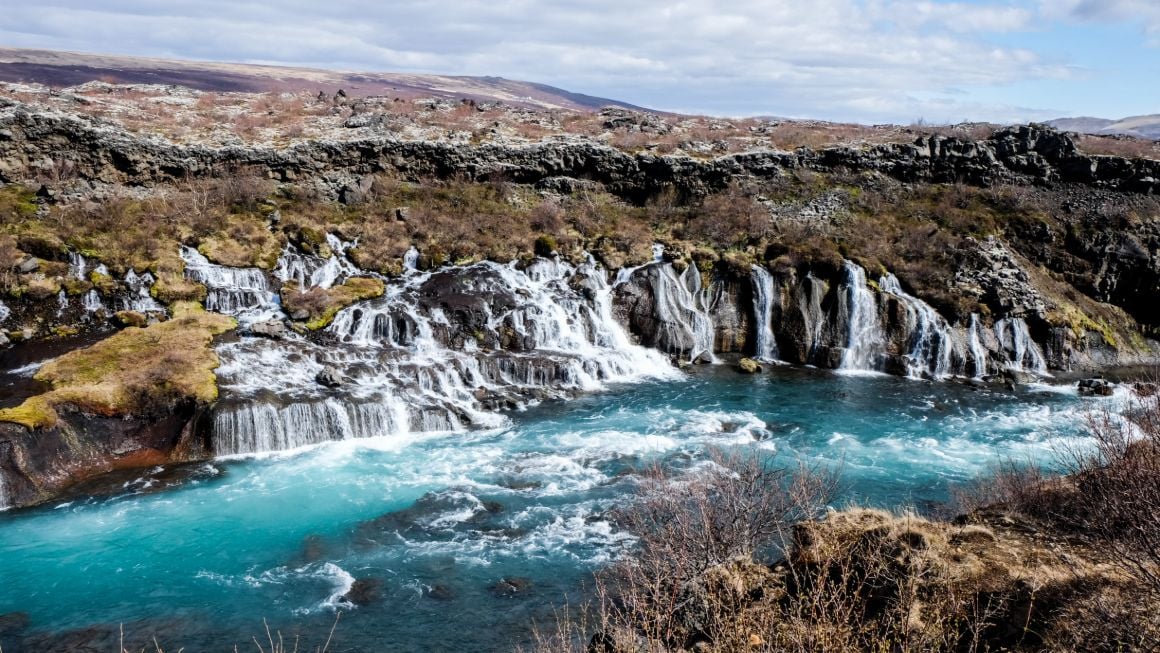
Whale-watching is best enjoyed between April and October – this is the peak season for travel, so make sure to plan and book well in advance. It is still possible to see whales outside of the summer season in certain regions, providing there aren’t any storm conditions. You’ll likely be given a thermal suit to protect you from the icy temperatures.
The northern lights are a popular reason for travel to Iceland. Usually, you can see these from around late September until March when the nights are darkest. Precipitation and cloud cover are not ideal for seeing the northern lights, so months where there’s less chance of cloud cover are ideal – October and November tend to be best.
The cheapest time to travel is during the winter months, outside of the Christmas and New Year period. Rates on Icelandic accommodation and flights are the cheapest at this time. However, if you want to balance costs with better weather for sightseeing, then aim for the shoulder seasons of spring and autumn.
Best Time to Go to Reykjavik
Reykjavik, Iceland’s vibrant capital city, is great to visit at any time of year. In the summer, the city gets around 21 hours of daylight and experiences the best weather. Maximum daytime highs reach into the high teens with precipitation at its lowest.
While summer offers great weather, it comes at a price. Accommodation in Reykjavik will be significantly more expensive at this time, tourist numbers are at their highest, and you can’t see the northern lights at this time of year. On the upside, there are plenty of festivals and celebrations during the summer months, and it’s a great time for whale-watching.
Autumn (September and October) is slightly cooler and the days start to get much shorter. However, prices on flights and hotels are much lower and the hordes of summer tourists have left. There’s a small chance you could see the aurora borealis on clear days, but if this is your primary reason for visiting, rather plan for a winter trip.
Rain and snow characterize the winter months. It’s dark and cold and perfect for seeing the Northern Lights. Winter in Reykjavik can be fun too! And you’ll easily be able to pick up a good deal on accommodation and flights, However, certain experiences might be unavailable due to poor weather conditions and the impact of this on the roads.
Spring is a mixed bag when it comes to weather, but it’s still much cheaper than peak season. The days are getting longer and warmer, which is great for sightseeing but not for seeing the Northern Lights .
Best Time to See the Northern Lights
The magical aurora borealis, or Northern lights, are a popular reason for travel to Iceland. The distances between cities here make it easier to avoid light pollution, and the winter months are dark, making it easier to see this incredible phenomenon.
Like most natural occurrences, predicting the visibility of the Northern Lights is not an exact science, so there is always a small chance you could miss it. Of course, there’s not much you can do to encourage a solar flare or solar wind to increase your chances of seeing the aurora, but you can plan your trip for a time when it’s more likely that you’ll see them.
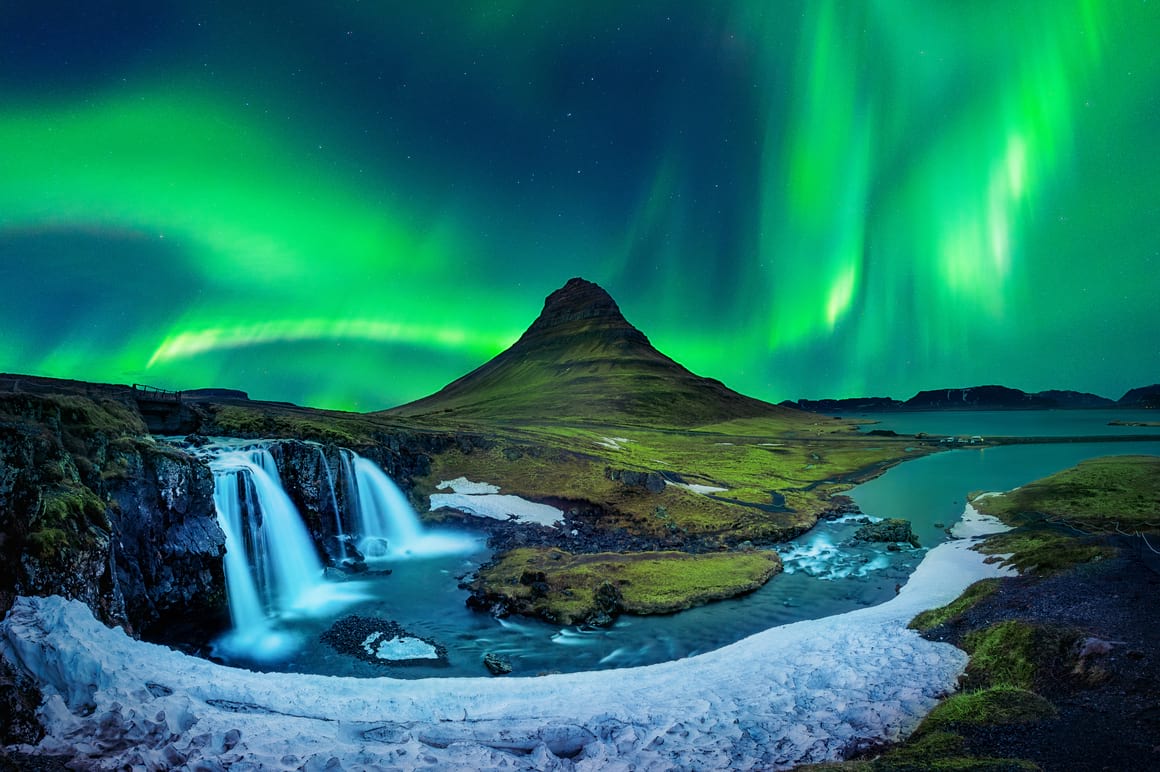
September to late March is commonly the time when it’s dark enough for the Northern Lights to be seen. Months where there’s less or no precipitation are preferable as cloud cover is the last thing you want. October and November offer dark nights and low chances for cloud cover, increasing your odds of seeing the Northern Lights.
February and March also offer good conditions for seeing the Northern Lights, but with a slightly increased chance of cloud cover.
Best Time to Do the Golden Circle
The Golden Circle is (as the name would suggest) a circular route that starts in Reykjavik and takes in some of Iceland’s most beautiful landscapes. It is a cornerstone for most Iceland tours . The route takes you to three of the country’s top attractions: Þingvellir National Park , Geysir geothermal area, and Gullfoss waterfall, and a whole host of extra little gems along the way.
The route can be done in one day, or you could take your time to explore some of the smaller, but no less fascinating locations in between. Scheduled group tours can have you back at your hotel before a full workday has passed, but a self-drive adventure at your own pace can be very rewarding.
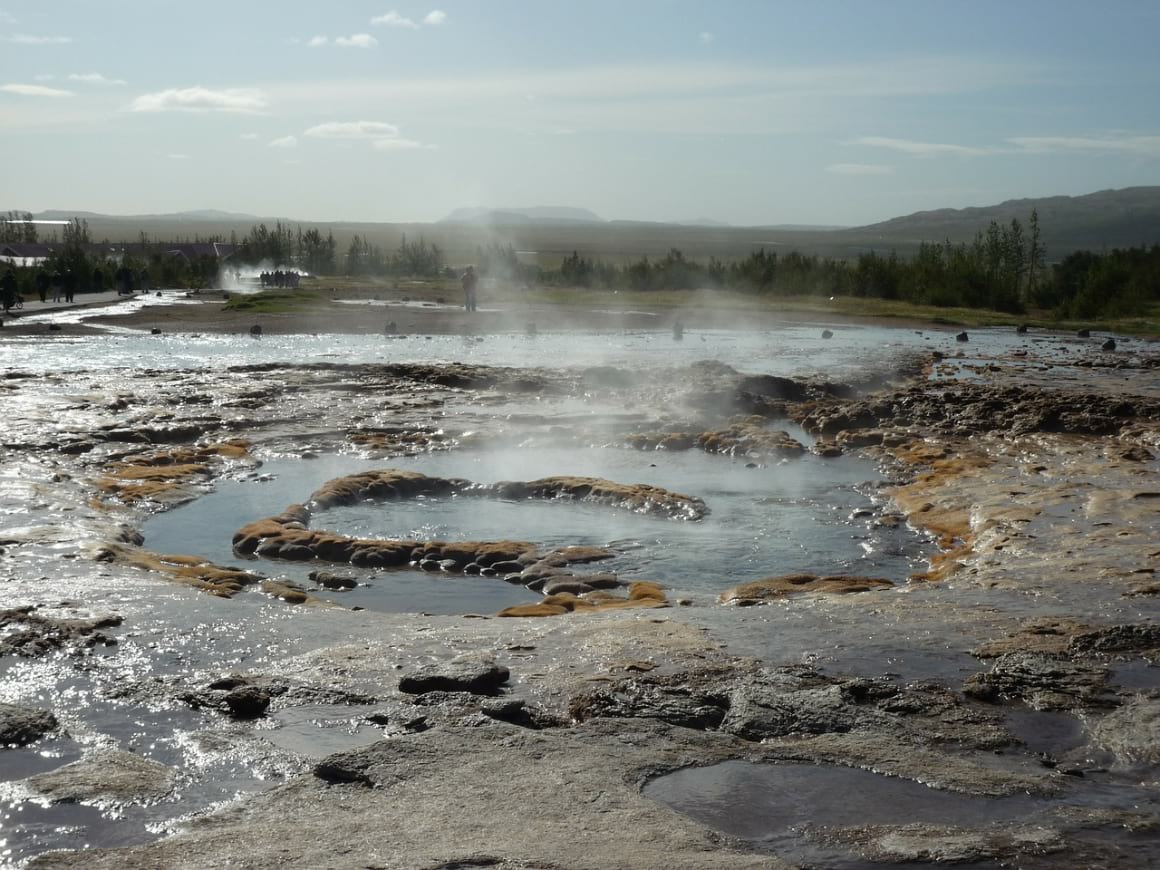
While the summer months offer the long days and mild weather ideal for sightseeing, it does come with the pitfalls of coach-loads of other tourists. If you’re doing a self-drive, accommodation along the way can get pricey at this time of year.
Of course, doing the Golden Circle in winter will offer a completely different perspective on the landscape. It will be cold, but it does mean you could be rewarded with sights of the Northern Lights as well. Gullfoss waterfall will be frozen and hauntingly beautiful at this time.
Best Time for Sightseeing in Iceland
The long daylight hours and mild weather of summer make it a great time to enjoy sightseeing. So great, that that’s when everyone does it. This means you’ll likely have to endure long waits at major attractions, straining to see past big crowds and the typical elevated pricing of high season.
Traveling in May or September, the months immediately before and after high season, offer the best weather for heading out to the many sights, while simultaneously avoiding the crowds and costs of peak season. While the days are shorter than in high summer, there’s still plenty of daylight to enjoy your sightseeing. Any earlier than May or later than September can see the weather becoming more variable, and the days very much shorter.
Winter is significantly cheaper for a visit to Iceland, however, aside from the icy temperatures, the snow and rain can make some roads impassable, meaning some sight will be inaccessible. The days are also very short, offering only around four or five hours of daylight to get your sightseeing in.

Wanna know how to pack like a pro? Well for a start you need the right gear….
These are packing cubes for the globetrotters and compression sacks for the real adventurers – these babies are a traveller’s best kept secret. They organise yo’ packing and minimise volume too so you can pack MORE.
Or, y’know… you can stick to just chucking it all in your backpack…
Cheapest Time to Go to Iceland
Winter, outside of the Christmas and New Year holiday period is the cheapest time to visit Iceland. This time of year is characterized by intense cold, dark days with only a few hours of daylight, and in times of bad weather, inaccessible roads in some places.
The shoulder seasons of spring and autumn offer a happy compromise between the lovely weather of summer and the low costs of winter. During these shoulder seasons, you can still enjoy good weather and a crowd-free experience.
Another benefit of travel outside of peak season is that you have the option to hold out for last-minute offers which can further save you on accommodation and flights.
If you are trying to save a few quid when visiting Iceland, check out the pod hostels in Reykjavik .
Busiest Time to Visit Iceland
Despite its long and dark winters, Iceland is a rewarding destination all year round and attracts tourists throughout the year. Of course, certain times are busier than others, so it’s always best to have all the facts when it comes to choosing the best time to visit Iceland.
The busiest tourist season is during the summer between May and September. These months offer the warmest weather, with daytime temperatures in the low 20s, and in some places almost 21 hours of daylight.
The long days and mild weather are ideal for sightseeing, whale-watching, and hiking. The Northern Lights are not visible during the summer months.
The winter months are the quietest time to visit Iceland, with the exception of the Christmas and New Year holiday period when we see a brief return to peak conditions with more tourists and higher pricing.
The shoulder seasons of spring and autumn are busier than the winter months in terms of tourist numbers but not as crowded as the peak summer season.
Weather in Iceland
Iceland has four very distinct seasons, although the weather at any time can be variable and unpredictable.
The west of the country benefits greatly from the warm Gulf Stream current that flows from the Caribbean. When this warm air meets the Arctic air from the north, things can get very temperamental.
There’s a saying in Iceland, ‘if you don’t like the weather, wait five minutes,’ and these swirling competing air masses are to blame for this. In the winter, this can lead to windy, stormy weather.
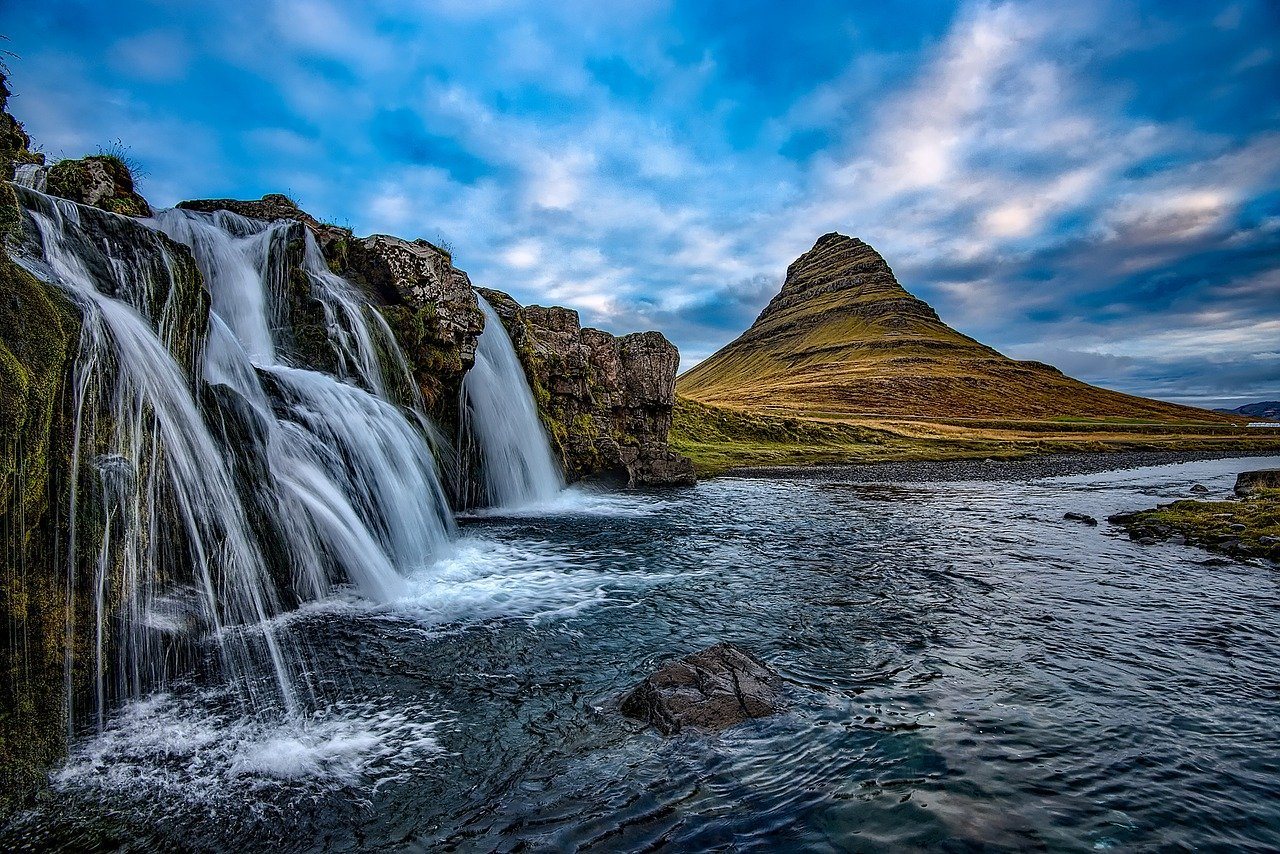
Summer in Iceland is characterized by long daylight hours and mild temperatures. Days rarely reach temperatures exceeding the low-20s, and while it’s mostly sunny and bright, it can also turn misty and rainy at the drop of a hat.
Winters are cold in Iceland, with frequent snow and rain. It’s dark, with only a few hours of daylight, and high temperatures rarely break into the double digits (Celsius). Stormy weather can cause problems with travel as some roads may become impassable.
Interestingly, although Iceland is located further north than most of Europe, the United States and parts of Canada, its winters aren’t as cold as, say, New York or even Russia. The warm Gulf Stream ensures that the country doesn’t quite live up to its name as much as we would expect.
Where is the Best Weather in Iceland?
The southern coastal region of Iceland is generally characterized by mild summers and cool winters which don’t often get too cold. The influence of the warm ocean currents causes an overall milder climate. The differences between summer and winter are not extreme, and rain can be expected at any time of year.
Further inland and in the higher elevations, the climate is much cooler. Summer peak temperatures rarely break into the teens (Celsius) and the winters are much colder than the southern coastal regions.
The northern regions of the country tend to exhibit cooler temperatures overall, with maximum daytime highs in winter hovering at around 10°C – significantly colder than in the south, which averages 0°C.

Stash your cash safely with this money belt. It will keep your valuables safely concealed, no matter where you go.
It looks exactly like a normal belt except for a SECRET interior pocket perfectly designed to hide a wad of cash, a passport photocopy or anything else you may wish to hide. Never get caught with your pants down again! (Unless you want to…)
Festivals in Iceland
Iceland celebrates many festivals annually, from ancient Viking traditions and religious observances to more contemporary celebrations. The population of Iceland may be small, but its capacity for celebration is large.
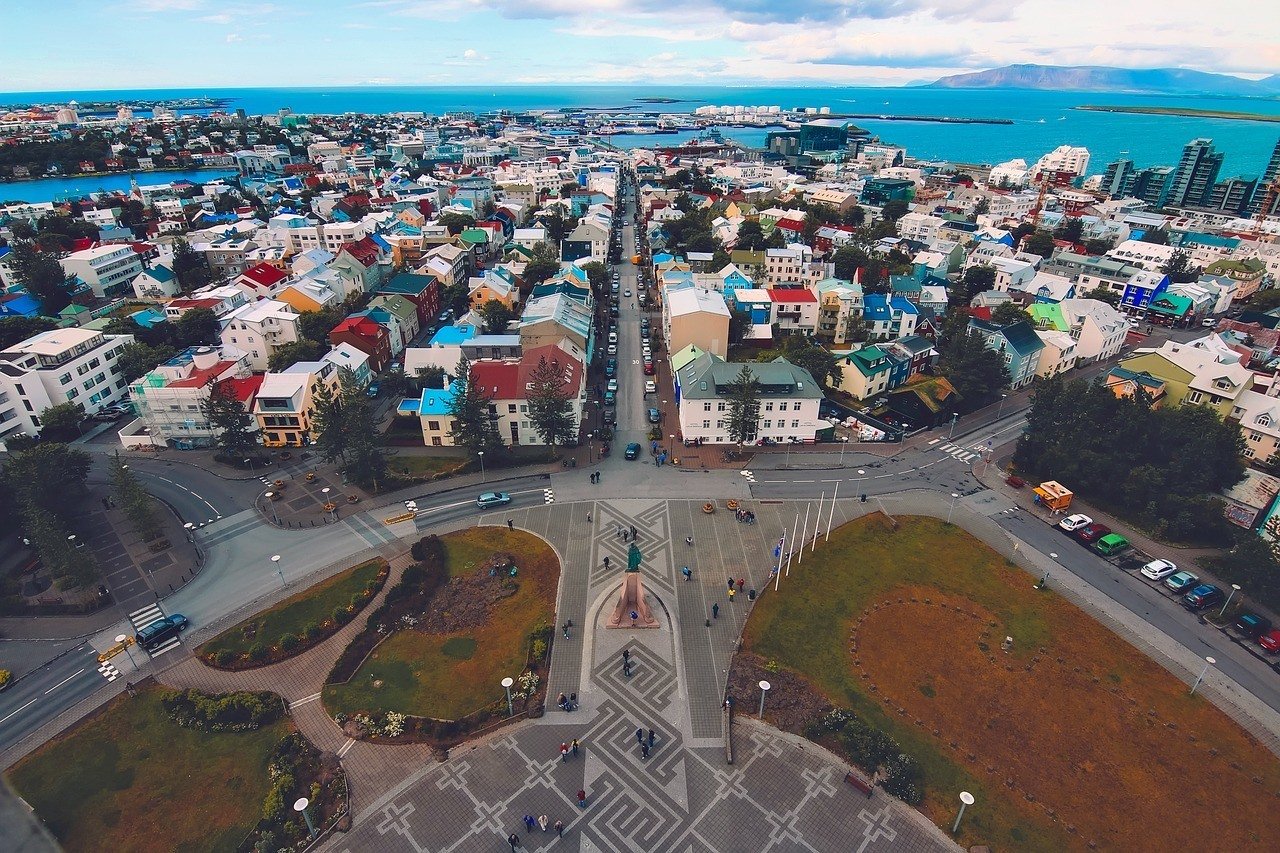
A slightly modernized Viking tradition featuring loads of singing and dancing and eating. The gastronomically adventurous and strong of stomach can try traditional delicacies like fermented shark, sheep’s head, and pickled ram testicles, and wash it down with a potent shot of brennivín – a schnapps-like spirit nicknamed the ‘Black Death’.
- Winter Lights Festival:
Hosted annually in February, the lights festival originated as a way to brighten up the darkness of the long winter months. Reykjavik is lit up with spectacular light installations, landmarks are illuminated, and various performances and shows.
Over the four days of the festival, you can also enjoy Pool Night and Museum Night – extended opening hours and free admission at the city’s pools and museums.
While not technically a festival or a celebration, the arrival of these shy, goofy-looking birds is worth taking note of. The puffins arrive on the shores in impressive numbers (over 10 million birds) in the spring for their breeding season, departing again by mid-August. Iceland is the breeding home for over 60 percent of the world’s Atlantic puffins, with colonies located all over the country.
The best time to see and photograph them is in late summer.
- International Viking Festival :
A celebration of the country’s Viking heritage, this is the oldest and biggest festival of its kind, held annually at Viking Village in Hafnarfjörður.
Five days of staged battles, dances, and story-telling offer visitors a glimpse into traditional Viking life. Visitors can learn to use traditional weapons like spears and axes, learn wood carving techniques, and purchase a variety of handmade goods from the market.
- Frostbiter:
Icelandic folklore is filled with tales of monsters and supernatural creatures. These dark tales are likely a result of the deep, dark winters, volcanic landscapes, and dramatic scenery of the country.
This penchant for dark themes has birthed an annual horror film festival celebrating these macabre, strange, and downright terrifying movies.
Horror film fans can head to Akranes, a small town north of Rejkyavik, for the Iceland Horror Film Festival which celebrates both local and international horror films.
Christmas is a special time to be in Iceland. From traditional Christmas concerts, festive markets, and twinkling lights that cut through the winter darkness, the country is transformed into a winter wonderland.
Any Christmas in Iceland is virtually guaranteed to be a white Christmas, and the chances increase the further north you travel.
If you’re still in any doubt as to the best time to visit Iceland for the experience you’ve been dreaming of, take a look at our month-by-month guide.
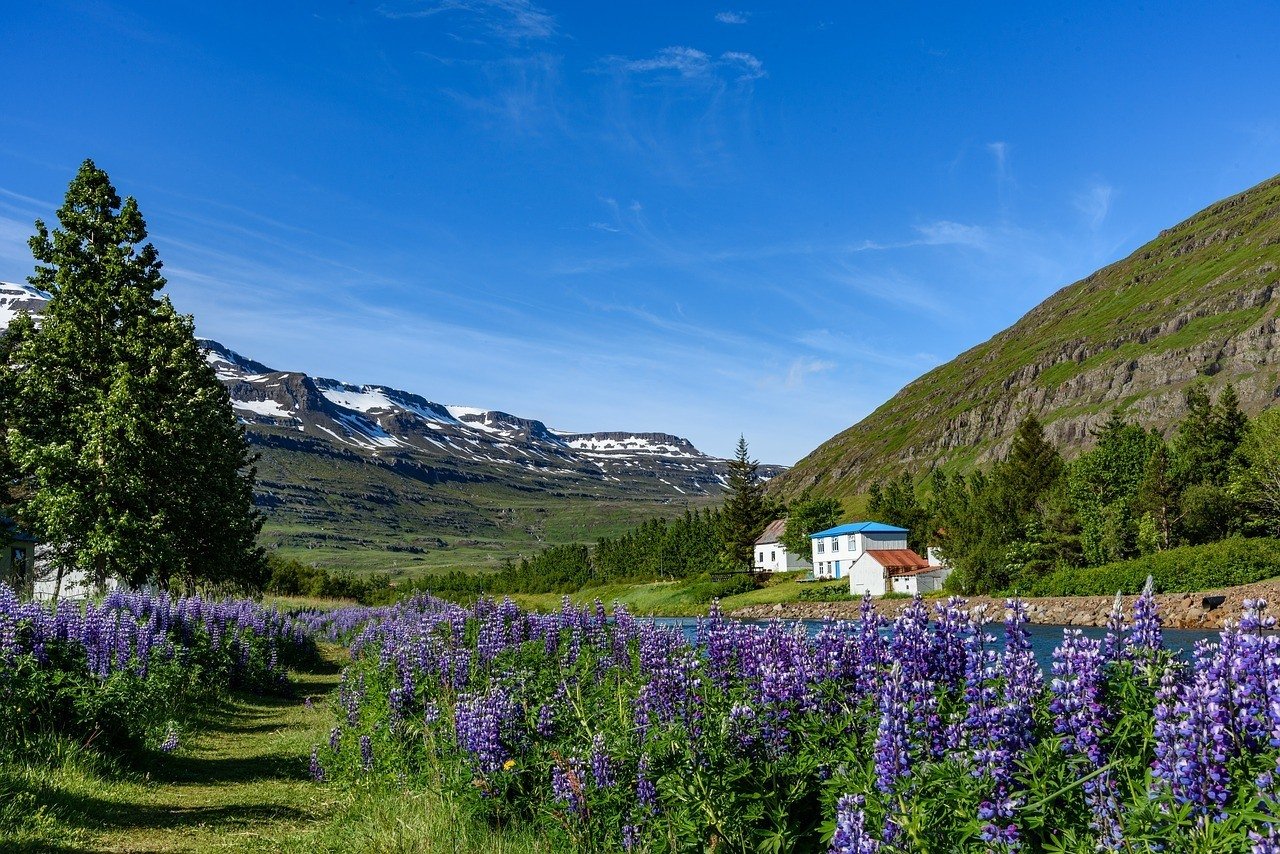
We’ve gathered all the details for each month of the year to help you find the ideal balance of costs, crowds, and climate.
January in Iceland
January in Iceland is cold and dark . Average high temperatures hover around 2°C and winds often reach gale force, making it feel colder than it is. There’s a good chance of rain and snow as well.
It’s very much low season, so definitely the cheapest time to visit Iceland , and there aren’t too many other tourists to contend with at tourist attractions. However, the days are short and offer only a few hours of daylight for sightseeing. Certain roads and attractions are likely to be closed or inaccessible due to weather conditions.
February in Iceland
It isn’t much warmer in February , but the chance of rain and snow decreases. The days are getting longer so there’s more time for sightseeing. Most of the roads should be accessible by now unless there’s a bad storm.
You’ll still benefit from low season conditions : sightseeing is still pleasantly crowd-free and prices are low.
March in Iceland
March is still cold with occasional rainy days . Snow isn’t likely unless you’re headed to the higher elevations. The days are getting significantly longer now, and there’s more daylight than darkness now.
There are few tourists around so sightseeing is still relatively uncrowded. This is a great time for winter sports in the mountains as there’s far more daylight to enjoy the slopes.
April in Iceland
This is the unofficial start of the summer season in Iceland. As the snow melts, the landscape is blanketed in greenery, and flocks of migratory birds arrive. While it’s still chilly with maximum temperatures only hitting the single digits (Celsius), there’s significantly less rainfall and much longer days .
Tourist numbers start to increase from April, but it’s still not peak season so costs and crowds are manageable.
May in Iceland
May is the best time to visit Iceland if you’re wanting a good balance between crowds, costs, and climate. The days are lovely and long, if a little chilly, there are fewer tourists, and prices are still low .
Temperatures are still fairly low, with the average maximum rarely peaking over 10°C. And like any time in Iceland, the weather has the potential to be erratic. Snow is unlikely unless you’re headed to the mountains.
June in Iceland
It’s now feeling a lot more like summer. Temperatures can get as high as 20°C but usually hover around the low teens. You can expect bright, sunny days for the most part, with the longest days of the year.
With the mild weather come the crowds and peak season pricing . Anyone wishing to visit in high season should book well in advance. Visiting Iceland in June is on my bucket list! More sunny days, please…
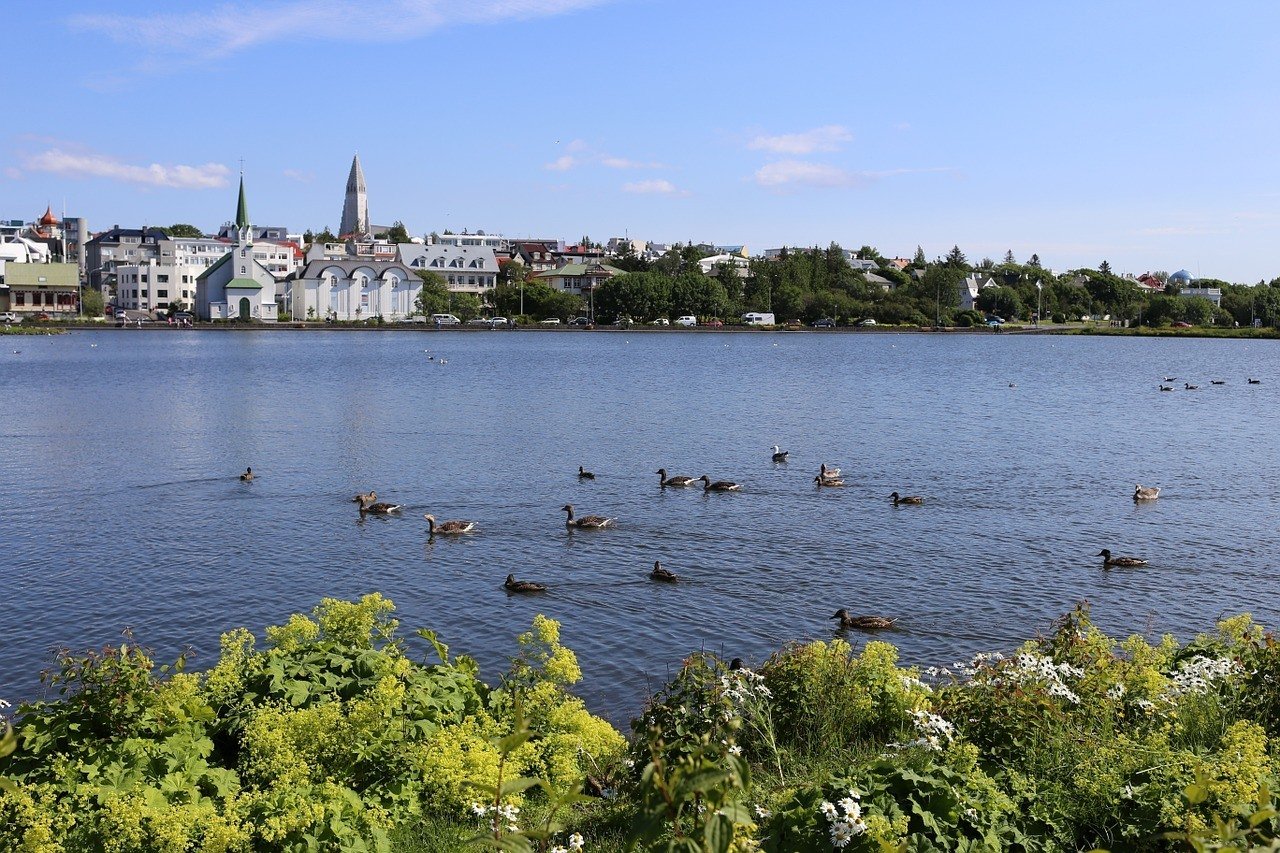
July in Iceland
Like June, July offers long sunny days and mild temperatures that attract large numbers of tourists. Average daytime temperatures creep closer to the mid-teens, but can sometimes get much higher. You may experience light rain on occasion.
This is one of the most popular times to visit Iceland , so expect busy attractions, crowds of tourists, and elevated pricing. If you’re visiting at this time, there are plenty of outdoor festivals and celebrations to attend.
August in Iceland
It’s still fairly warm in August, with daytime highs in the low teens , but the temperatures start to decline noticeably as the month progresses. There’s a slightly higher chance of rain, and days are getting noticeably shorter too.
It’s still a great time to travel to Iceland in terms of weather, but you may still encounter large numbers of tourists and higher pricing.
September in Iceland
The days shorten significantly in September in the lead-up to winter. It’s rainier at this time of year and the temperatures are cool , with an average maximum of around 10°C. The first sightings of the northern lights are possible now, although not guaranteed.
If you’re visiting at this time, you can enjoy the crowd-free conditions and the lower pricing that follows the peak season.
October in Iceland
Weather conditions become much more wintery in October. While it’s technically only autumn, the average maximum temperatures drop into the single digits, the days are short, and rain is common.
Conditions are still good for sightseeing and the weather hasn’t yet impacted the conditions of the roads. You’ll also benefit from fewer crowds and off-peak pricing . The northern lights become much easier to see from October onwards.
November in Iceland
Temperatures continue to drop along with the number of daylight hours. There are only a few hours of daylight to enjoy, so you’ll need to plan your time well. Light rain is common, and if you’re heading further north, your chances for snow increase. Some attractions and roads are impacted by the weather and may not be operating.
Tourist numbers are low at this time, making sightseeing pleasant and stress-free. You may be able to pick up some great deals on accommodation during November.
December in Iceland
The cities transform into festive winter wonderlands , with twinkling lights and festive markets brightening up the winter darkness. Snow is common at this time as is rain, and average daytime temperatures hover around 4°C.
There’s a small spike in tourism around Christmas, but if you book in advance, you’re still likely to pick up a good deal on accommodation.

A new country, a new contract, a new piece of plastic – booooring. Instead, buy an eSIM!
An eSIM works just like an app: you buy it, you download it, and BOOM! You’re connected the minute you land. It’s that easy.
Is your phone eSIM ready? Read about how e-Sims work or click below to see one of the top eSIM providers on the market and ditch the plastic .
When is the Best Time to Go to the Golden Circle?
The Golden Circle route can be done at most times of the year. May and September are the best times, as they offer pleasant weather and fewer tourists.
When is the Rainy Season in Iceland?
The weather in Iceland is notoriously unpredictable and rain can be expected at any time in the year. Most of the rain falls over the winter months between October and February.
When is the Coldest Month in Iceland?
January and February are the coldest months in Iceland. The average maximum temperature is around 2°C, and rainfall and snow are frequent.
When is the Worst Time to Visit Iceland?
Iceland’s short summer occurs between June and August. This is when large numbers of tourists flock to Iceland to enjoy the sights in the mild weather.
Don’t Forget your Iceland Travel Insurance
ALWAYS sort out your backpacker insurance before your trip. There’s plenty to choose from in that department, but a good place to start is Safety Wing .
They offer month-to-month payments, no lock-in contracts, and require absolutely no itineraries: that’s the exact kind of insurance long-term travellers and digital nomads need.

SafetyWing is cheap, easy, and admin-free: just sign up lickety-split so you can get back to it!
Click the button below to learn more about SafetyWing’s setup or read our insider review for the full tasty scoop.
Iceland, the Land of Fire and Ice, is a land of contrasts and extremes. Whether you choose to visit in the height of summer or the very depths of winter, each experience will yield a unique perspective of this fascinating island.
Choosing the best time to visit Iceland will depend largely on what experiences you wish to have. It all comes down to striking a balance between the weather conditions, the tourist numbers, and seasonal pricing.
If you’re planning a visit in the summer – you’ll be treated to long sunny days, but it’s essential to book well in advance. If you’re hoping to go off the beaten track and explore outside of the peak season, you might want to hold out for a last-minute deal.
Either way, there’s plenty to experience in Iceland. And when you’ve done it all? Come back and do it all again in a different season for a completely new perspective.
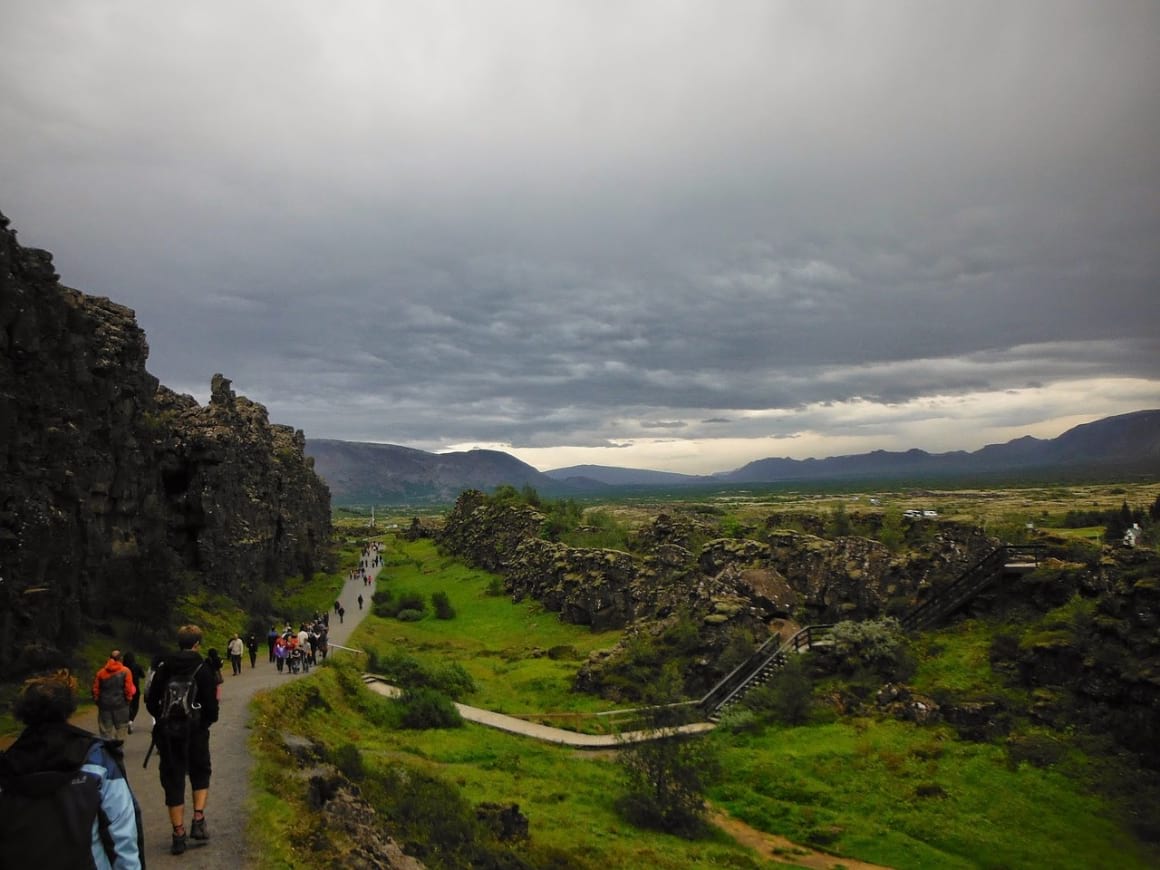
- Let’s get you ready for your next adventure with our backpacking Iceland guide .
- Check out the best hostels in Iceland to kickstart your adventure.
- Know where to stay in Reykjavik BEFORE you get there… trust me on this one.
- With the best international SIM card you can stay connected, always.
- Seeking a once-in-a-lifetime experience? Explore the best places to see the northern lights .
- Explore some of the best waterfalls in Iceland to experience something a lil’ different.
- Plenty of backpackers – myself included – make a stop at Iceland’s Blue Lagoon at the end of their Iceland adventure.
- Expand your horizons and explore the best winter destinations in Europe .

And for transparency’s sake, please know that some of the links in our content are affiliate links . That means that if you book your accommodation, buy your gear, or sort your insurance through our link, we earn a small commission (at no extra cost to you). That said, we only link to the gear we trust and never recommend services we don’t believe are up to scratch. Again, thank you!

Christina Grayt
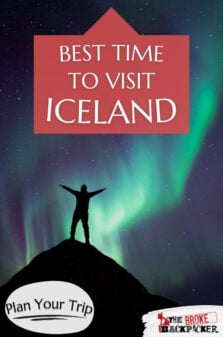
Share or save this post

My husband and I will be in Reykjavik from August 16 to August 18th. We are very interested in taking a Golden Circle small group tour on August 17th. How do I find such a day tour?
Ask at the local tourist information centre, check online, or ask at your accommodation. There will be more than a few tour companies advertising their jaunts.
Leave a Reply Cancel reply
Your email address will not be published. Required fields are marked *
Save my name, email, and website in this browser for the next time I comment.
Notify me of followup comments via e-mail.

Home » Europe » Iceland » The Absolute Best Time to Visit Iceland
The Absolute Best Time to Visit Iceland
By Author Lance Longwell
Posted on Last updated: July 23, 2023
This small country has received a lot of love in the travel sphere during the last decade, and with good reason. Thanks to its stunning landscapes and ease of getting there from both North America and Europe, this is the perfect destination for trips both short and long. But when is the best time to visit Iceland?
While we’ve been visiting Iceland (and writing about it) since 2009, we don’t know if we can really claim credit for the tourism boom. What we can do, is give you expert advice based on our visits over the years during the different seasons.
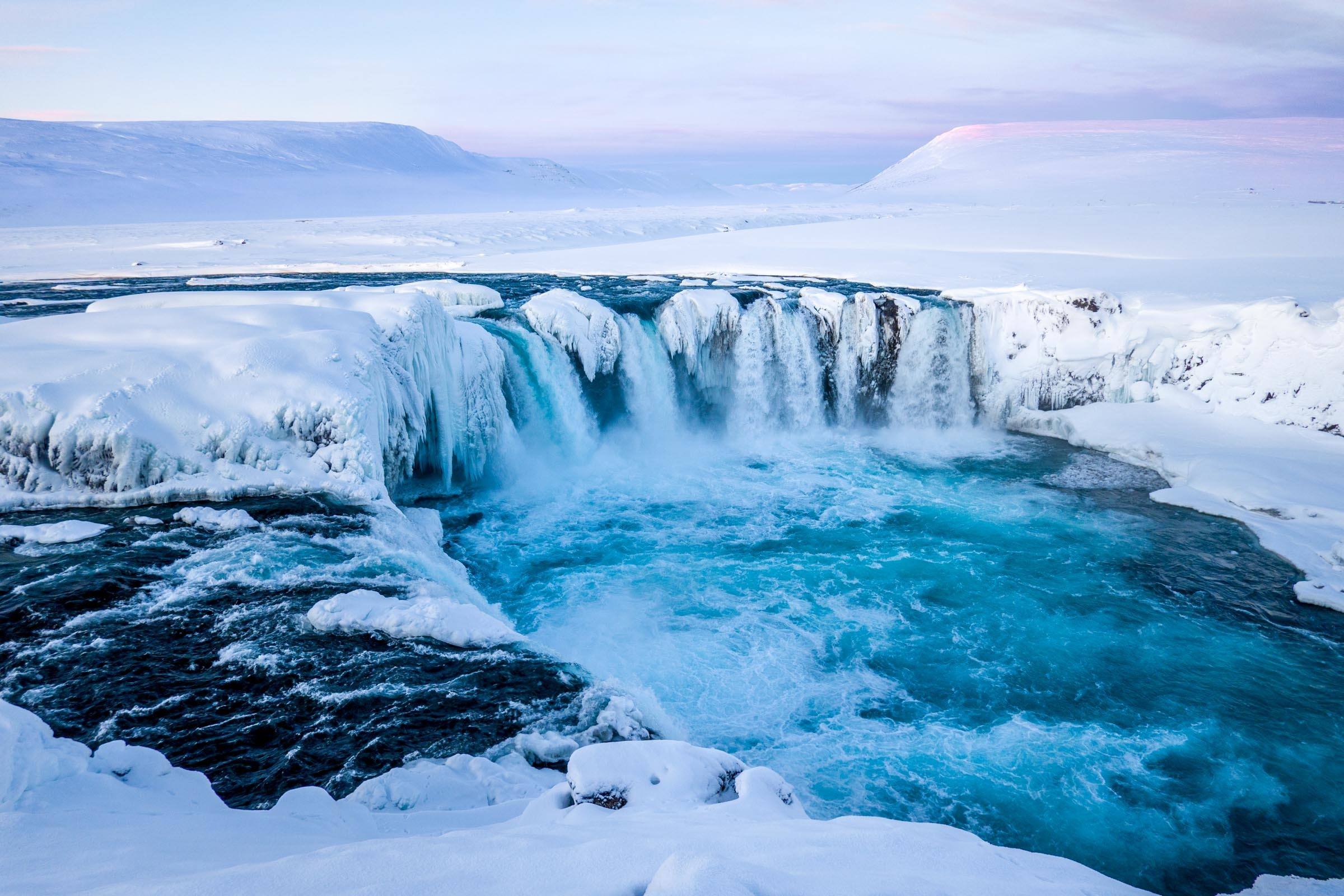
During your planning, if you’re not sure when to visit Iceland, this guide is for you. No doubt you have some ideas about what to do during your perfect Iceland getaway. We have broken down for you month-by-month what to expect, so you can make an informed decision on the best time of year to visit, based on your interests.
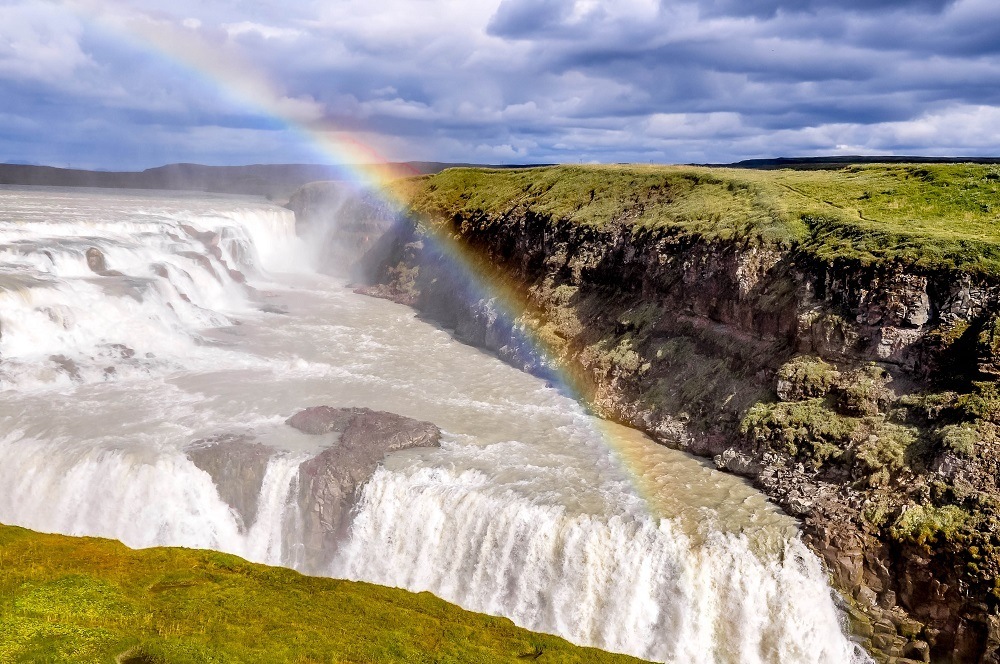
Our Recommendation: The Best Time to Travel to Iceland
Best months to visit, the best time to go to iceland by activity, northern lights, whale watching, saving money, avoiding crowds, holidays and festivals, holidays in iceland, festivals in iceland.
We are often asked when is the best time to visit Iceland. And while this is largely a matter of personal preference and based on your desired activities and attractions to visit , there are some general guidelines.
Iceland in the summer can be absolutely magical. The extremely long days mean you have more time for sightseeing, hiking, hot springs , whale watching, puffin watching, and about everything else under the sun. You will miss the snow, skiing, and Northern Lights, but rewarded for it in other ways.
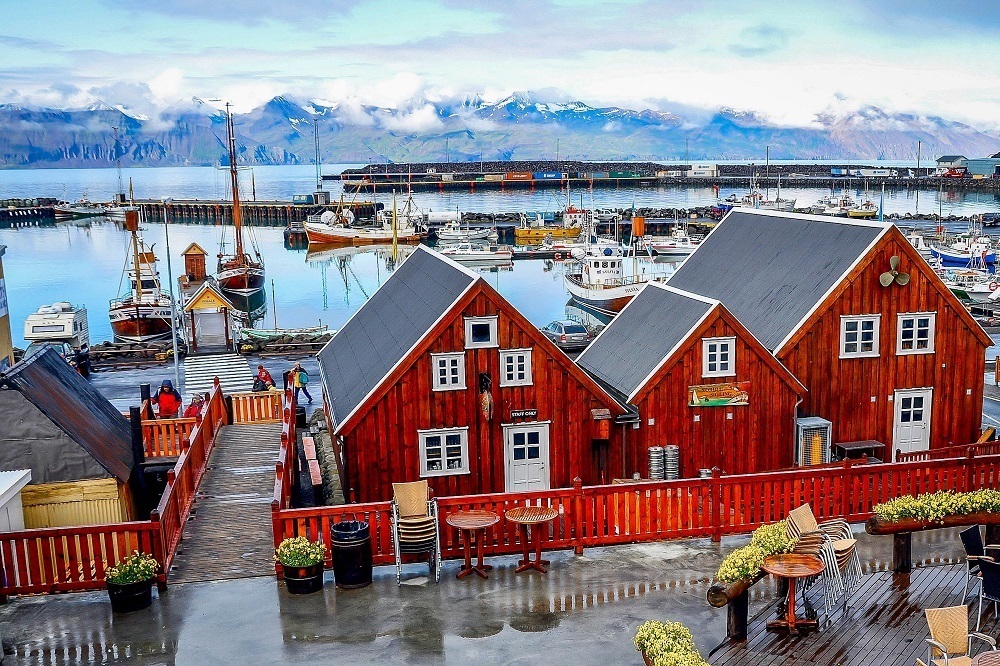
You will also have crowds and a lot more tourists to compete with. If you are going to Iceland in summer, head out of populated Reykjavik and spend time in the northern and eastern parts of the country, where there are fewer tourists. We recommend “shoulder season”: May/June or September where the weather is good, but slightly fewer people.
Iceland in the winter can be like a fairy tale. Only a few hours of actual daylight mean you’ll want to pack your activities close together. But the long twilight before sunrise and sunset create magical light (and stunning sunsets). Winter in Iceland can be beautiful.
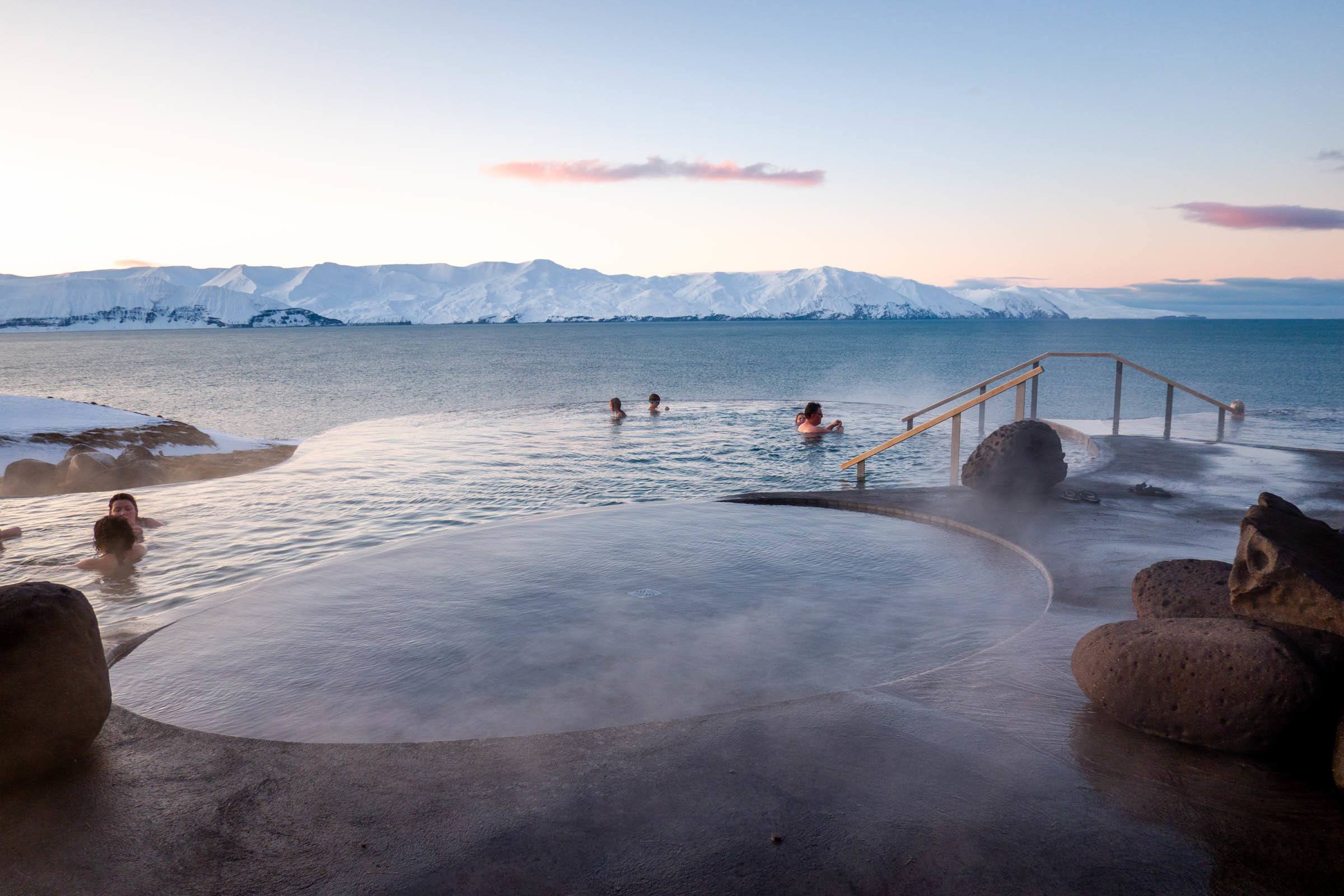
The Christmas-to-New Year period can be very busy with lots of other tourists. But early December and January/February can give you that dose of cold, snow, and Northern Lights you desire.
If you want our advice for when to visit Iceland, there’s no bad option. However, the best option is the one that fits your personal travel style and what you want to do while you are there.
This month is the coldest it will get. Ski season is usually underway by this time. The temperatures are not unbearable, however, because daytime averages are -1° C (30° F). At times, you may encounter fairly strong winds, which will make these temperatures feel colder.
During January, the average amount of sunlight is only 4 hours, although this increases to almost 7 hours by the end of the month. And if the Aurora Borealis is on your list, you are in for a treat, as this the best time to travel to Iceland to see the dancing lights.
With the number of daylight hours stretching from 7 to 10, February brings average temperatures of 0° C (30° F). This leaves adequate opportunity for exploration of the incredible scenery, and most of the attractions in the southwest part of the country are open for business –unless there is a big snowstorm.
February is the best time for skiing. This is also a good month to see the Northern Lights; just be sure to choose an evening when there is no precipitation and no cloud cover for the most optimal viewing.
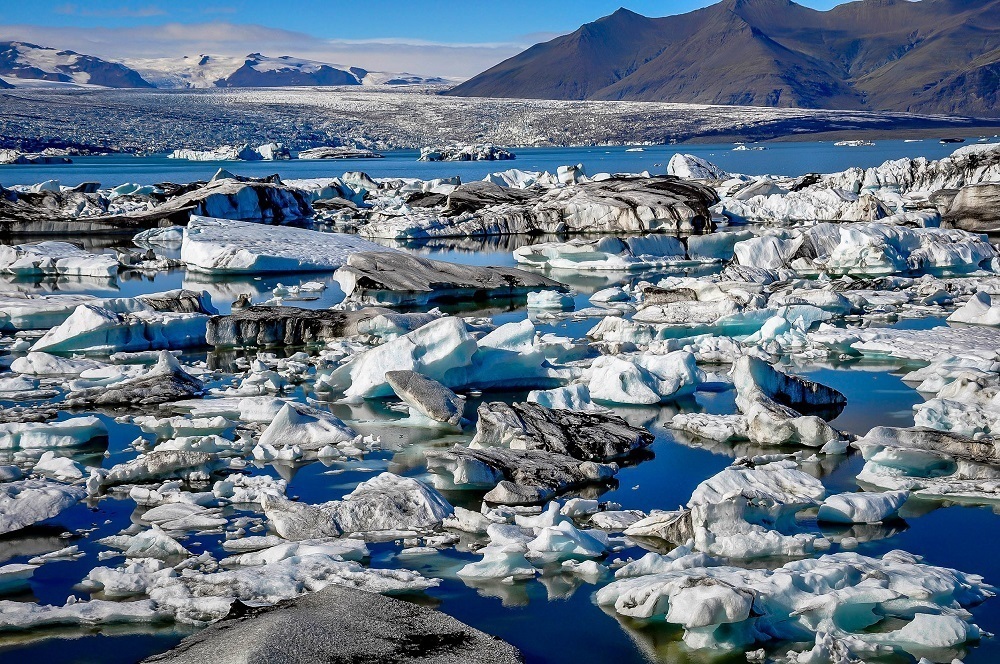
As the days get longer, the hours of sunlight with which explore range from 10 to 13.5. However, the average temperatures remain cold, but warming ever so slightly to 0.3° C (33° F). During March, about half of the days involve precipitation, which could be rain or snow, depending on where you are in elevation.
This is the heart of ski reason, although it starts to taper off by the end of the month. Still, you will need a 4-wheel drive to get to the more remote areas. This is also another ideal month for catching the Northern Lights on clear nights.
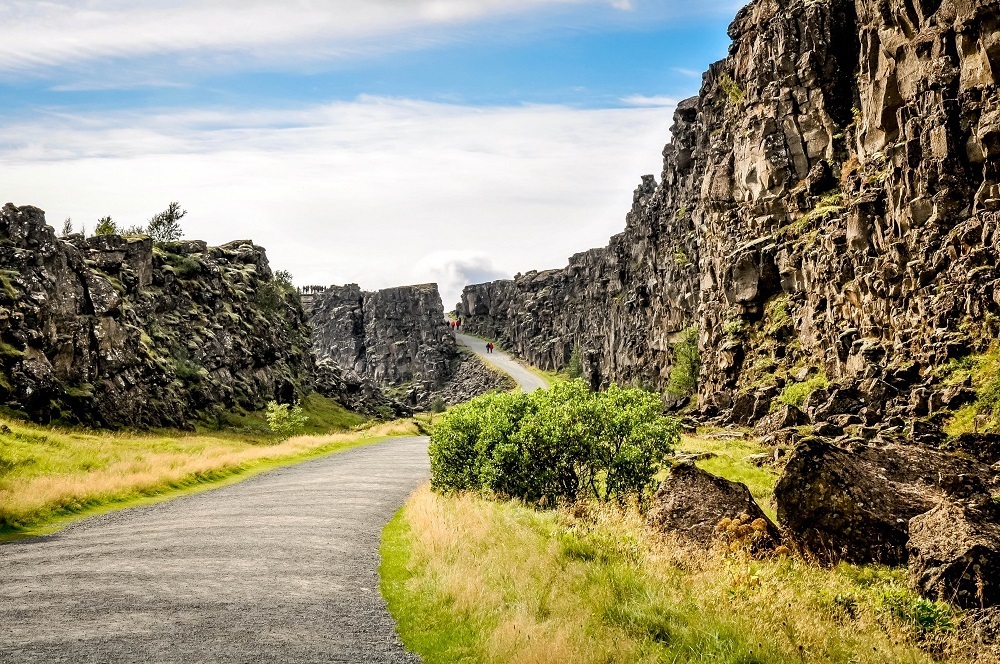
April is where the country really begins to “heat up.” Ski season is usually over by mid-April. With average daytime temperatures at 2.8 C (37° F). This is the time of year when the country sees drier weather.
However, with the clear skies also come the end of the season to see the Northern lights. They may not be as spectacular as during the winter months, but they are still there in April. The amount of sunlight stretches to 16 hours.
With long stretches of daylight at about 18 hours per day, you will no doubt guess that this is not a good time to witness the Aurora Borealis. However, what you can enjoy are average daytime temperatures of 6.3° C (48° F) and fewer tourists.
While this is still on the chilly side, the bright side is that you have many more sunny days with which to play.
In the Northern Hemisphere, June holds the longest day of the year, and here it is 22 hours, the month of the midnight sun! Temperatures are climbing as well, with average daytime highs of 8.9° C (48° F) or even higher on sunny days. That means you can expect less wind and rain, and more sunny weather.
The roads through the interior usually open in late-June. The waterfalls are still going strong. The number of visitors start to increase significantly.
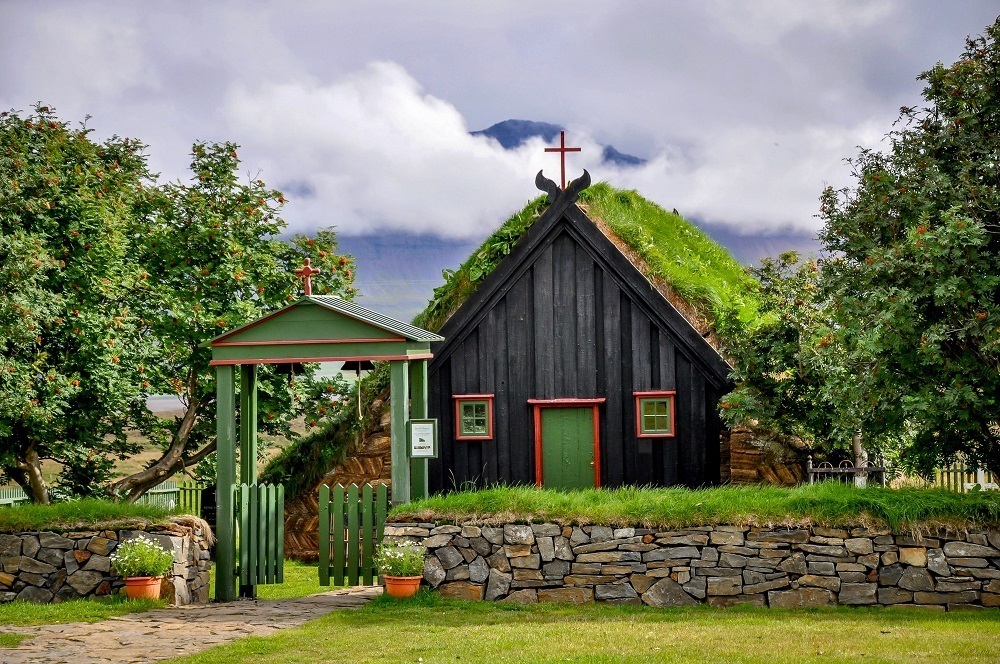
With pleasant weather and long days averaging 19 hours of sunlight, summer in Iceland can be quite lovely. The average daytime temperatures hover around 10.7° C (52° F) – never too warm. There is a good chance some light rain will mix in with sunny weather.
By July, you’ll be guaranteed that the 4-wheel drive roads into the interior will be open. This is peak season and many accommodation options will be booked out. Reservations will be necessary at restaurants.
This is when summer winds down and the daylight hours shorten to about 16, but is a great time to see landmarks in Iceland . The average daytime temperature is 10.3° C (50° F), and the weather remains fairly dry. Towards the end of the month, you will start to feel a distinct chill in the air, but still plenty of daylight for exploring.
This is the best time to visit the remote interior since the roads will still be open. Many locals take camping vacations at the beginning of the month. The number of visitors are at their peak this month.
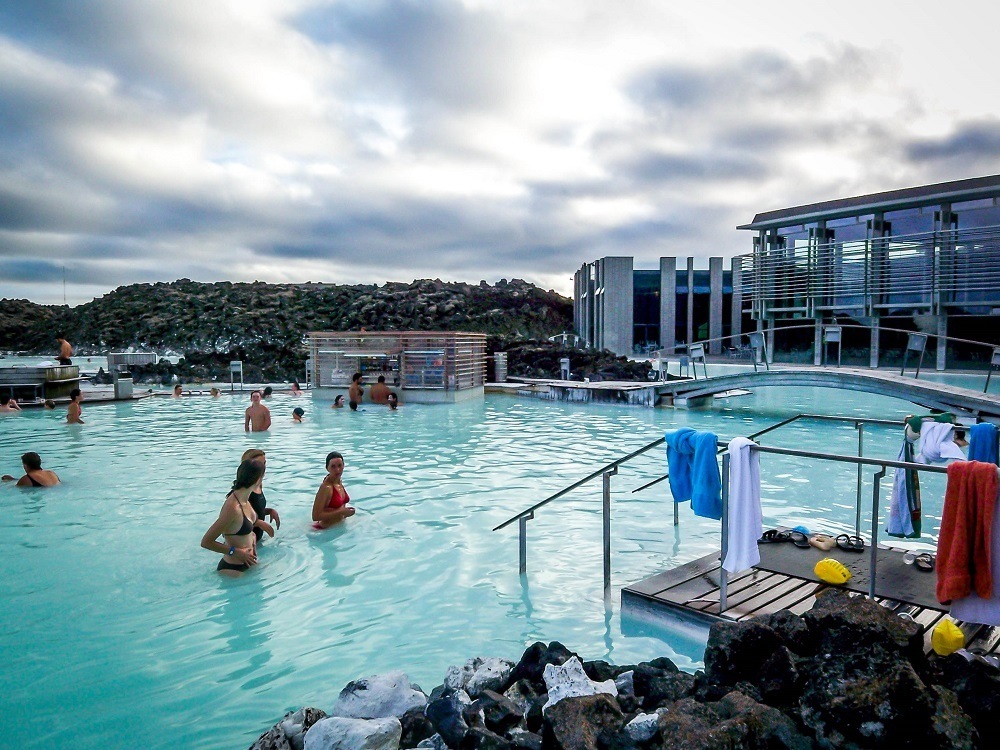
With the coming of autumn, September sees about 13 hours of sunlight and daytime temperatures of a cool 7.5° C (46° F). The season for good Northern Lights viewing is starting to ramp up towards the end of the month. There are also fewer days of sunshine.
By mid-September, some of the 4-wheel drive roads into the interior will begin to close for the winter. It is possible to start seeing some snow in the interior or at higher elevations.
In October, daylight hours drop significantly to around 9, with average daytime temperatures hovering at 4.3° C (40° F) and great autumn colors. Even though precipitation increases during this time, clear skies bring increasing chances for seeing the Aurora Borealis after the sun goes down.
While the weather is still good, there are significantly fewer people. This is a good “shoulder season” month: good weather, fewer crowds.
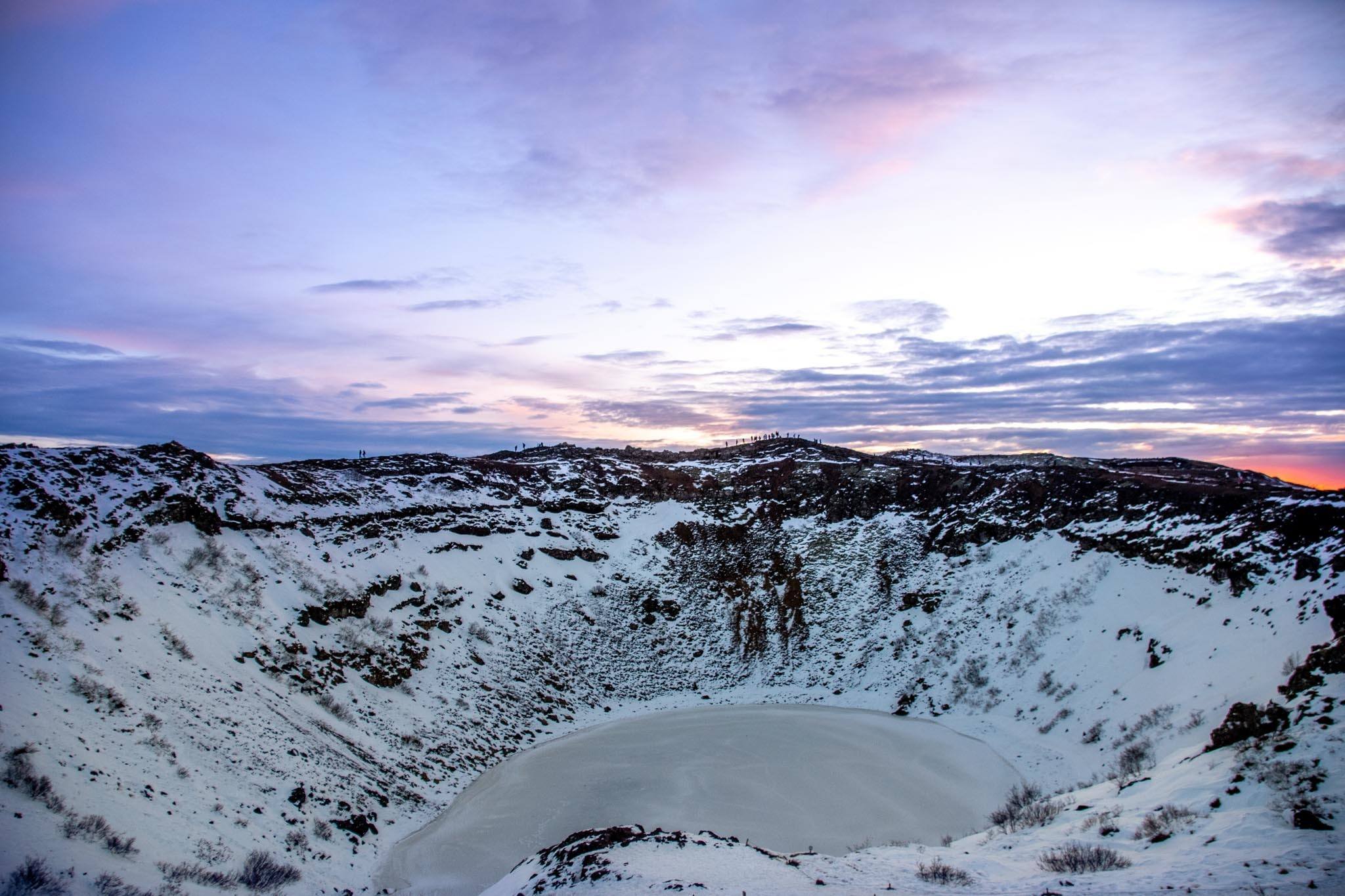
This time of year, temperatures drop to a bone-chilling 1.3° C (35° F). Now, just 6 hours of average daylight temperatures are available, but even though the days are short, this is prime Northern Lights-watching season. On many days you will see light rain or snow; even fog.
Other than January, this month is the darkest of the year, with only about 4 hours of daytime light to play with. Ski season usually starts in mid-December (or early January). The Blue Lagoon sees the fewest crowds in early December. Average daytime temperatures linger around -0.1° C (31° F).
On the flip side, this is prime fodder for some great Northern Lights viewing, when it is not snowing or raining, that is.
Not all activities are available here all the time. Depending on what you want to do, you may need to adjust your travel plans. Here is when to go to Iceland based on what activities are popular.
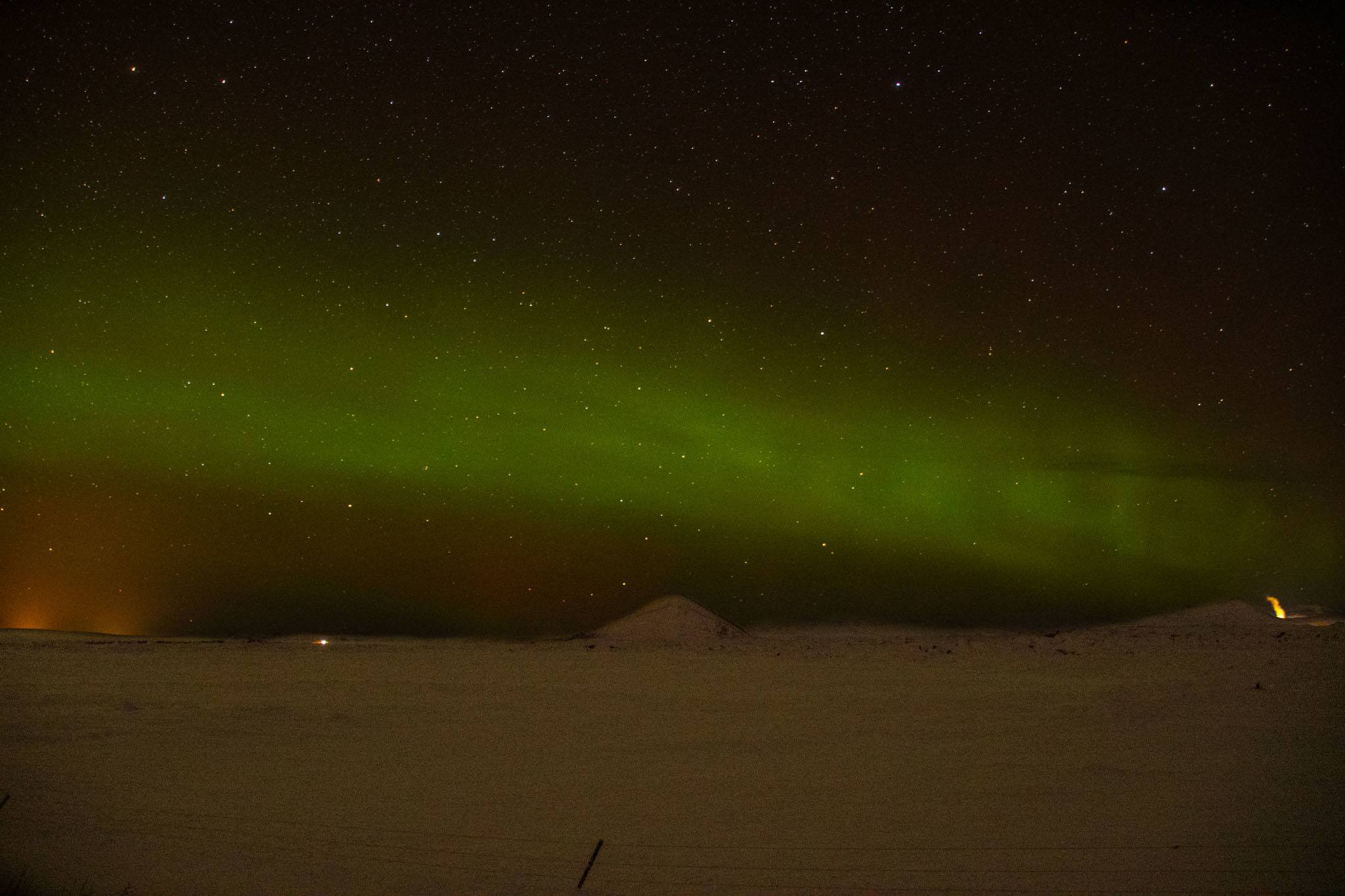
This is one of the premiere locations on the planet to view the Northern Lights, thanks to its remote location away from any city light pollution (save for Reykjavik). The season for Northern Lights lasts from late September through mid-April, however there are conditions required to get the best view. The sky must be clear and solar flares on the surface of the sun must occur, which produces the dancing lights.
During mid-November through about mid-March is when the temperatures are at their lowest. This is the optimal time for exploring the stunning ice caves. Due to the many glaciers and volcanoes, this is ripe territory for the formation of the ice caves. Also known as the Crystal Caves, you can take an ice cave tour and go inside the glaciers. Since most ice caves are inside glaciers, it is generally not safe to visit them during the summer months.
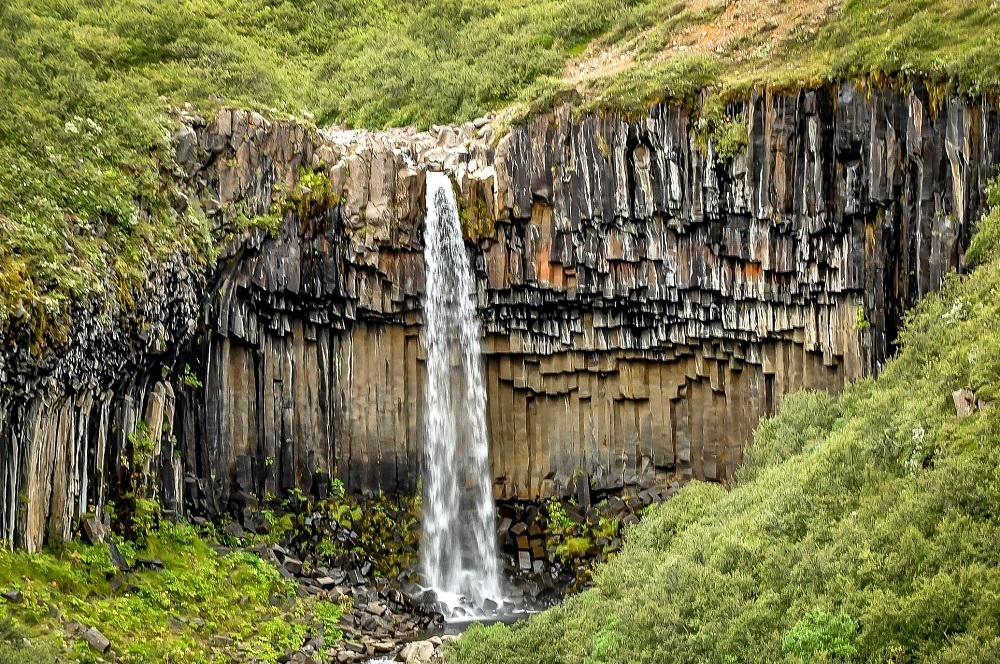
Waterfalls mean water, so the best time to catch waterfalls at their best is during the months of late April through June (with the heaviest rainfall) or anytime during the Spring-Summer months after a heavy rainfall. Also, there will be fewer crowds during this time.
Along with the Northern Lights, this island is a world-class spot for incredible whale watching. Optimal times for catching the whales in action is mid-June through the first week of September, however sightings do happen anywhere from April through October. Tours are available at several places around the island, including Reykjavik as well as the “whale capital” of Husavik in the north.
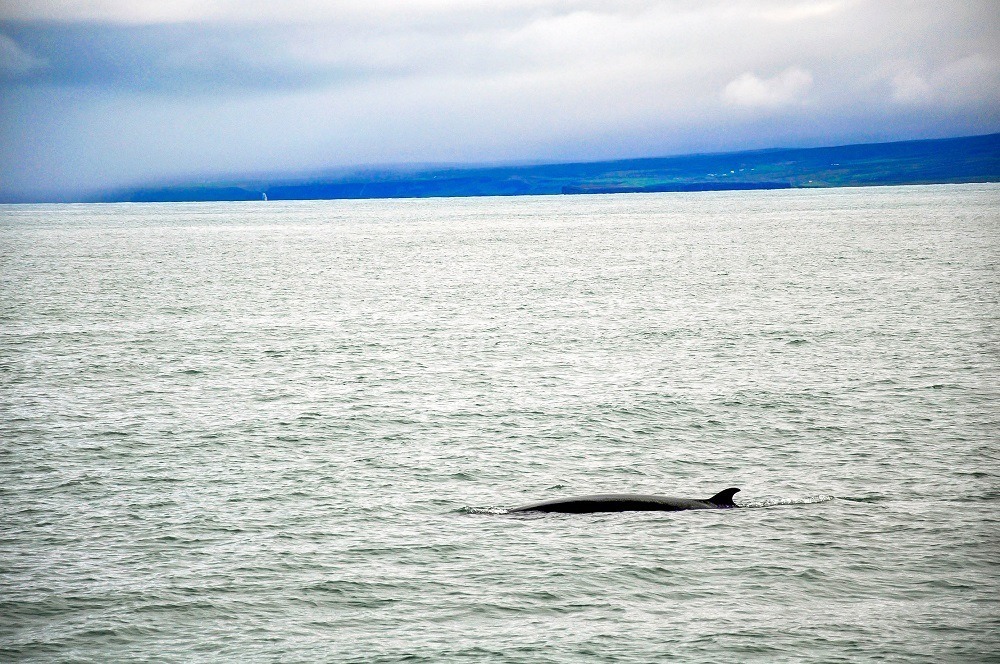
For the most pleasant mild weather, come to Iceland during the high season of July and August. With not quite as much daylight as in June, the days are still long, with the most sunshine and chance to explore the stunning landscape and all the attractions on the island.
If you are looking to save some dollars, travel in the low season of late October through early December, and then again from mid-January through March. Avoid the holiday season as this is when prices skyrocket. However, if you’d also like the weather to be a bit warmer, the shoulder season is good: mid-May through mid-June, and September through mid-October.
If you’d prefer your visit to be relatively uncrowded, the best time to plan your trip is during the months of March, April, May and September. Many people consider the shoulder seasons of spring and fall as the best time to visit.
Having said that, the capital of Reykjavik always sees its fair share of visitors, so to simply venture away from the city to more remote areas is ideal. The west fjords, northern and the east see far fewer visitors.
Icelanders celebrate some unique holidays all their own, and also some traditional ones (in a unique way!) Here are the highlights:
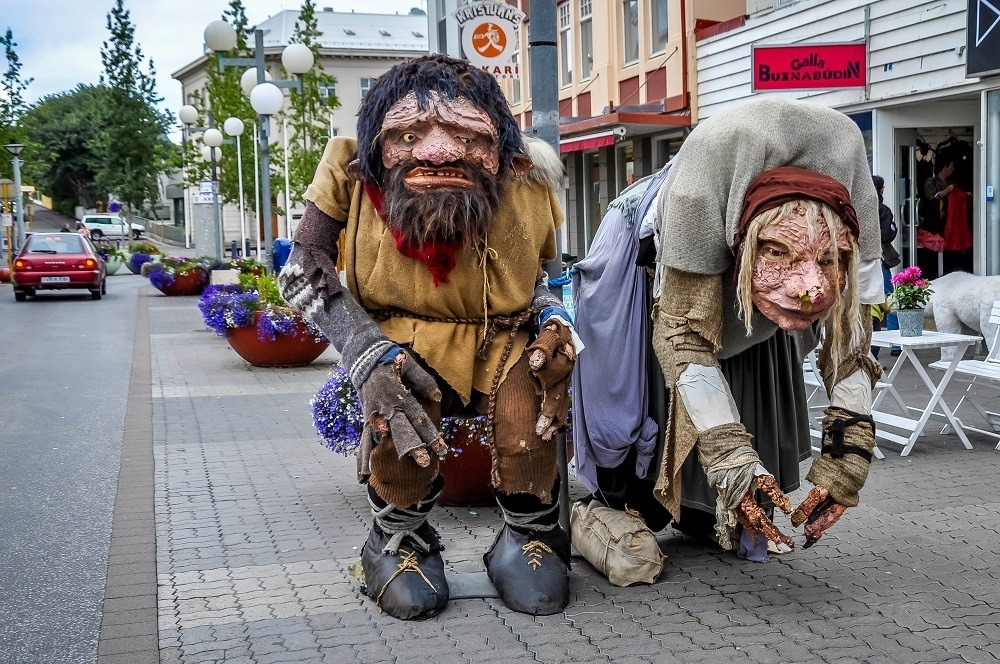
- New Year’s Day – 1 st of January, where most businesses are closed until the 3 rd.
- 12 th Night – 6 January, the last day of Christmas.
- Bóndadagur – in late January, known as ‘Husband’s Day’.
- Thorrablót – mid-January through mid-February, a feast of traditional foods.
- Konudagur – just after Thorrablót , this is ‘Wife’s Day’.
- Bolludagur – two days before Lent, this is another culinary holiday known as ‘Bun Day’.
- Sprengidagur – celebrated on Shrove Tuesday in February, another holiday where locals feast on lamb and pea soup.
- Öskudagur – known to other Westerners as Ash Wednesday, where children dress in costume and sing in shops for sweets.
- Iceland National Day – June 17, Independence Day.
- Verslunarmannahelgi – the first weekend of August, where many locals go camping
- Christmas – this a big holiday, with lots of holiday lights and events throughout the month, including special appearances by the Yule Lads.
- New Year’s Eve – the celebrations continue, and this is the only day that fireworks are legal.
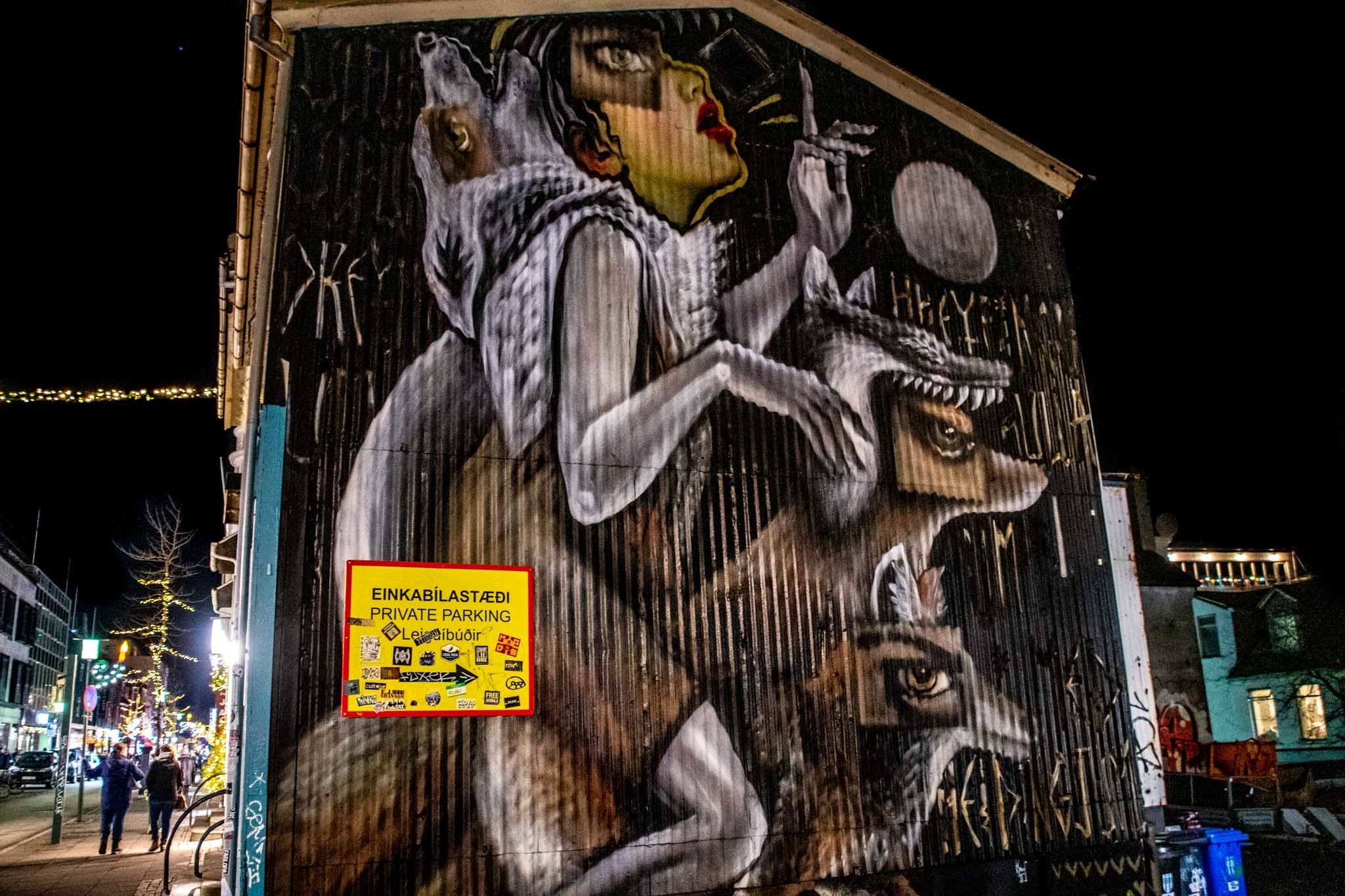
- Winter Lights Festival – held during the first weekend in February, winter spirits are lifted with light-art installations and cultural events.
- Food and Fun Festival – in late February in Reykjavik, chefs throughout the city celebrate with special menus and a televised competition.
- Reykjavik Folk Festival – three days of music in early March celebrates live folk music.
- Reykjavik Art Festival – taking place every other year in mid-May, it features a variety of national and international theater, design and dance.
- Seafarer’s Day & Festival of the Sea – the first weekend of June honoring local fisherman.
- International Viking Festival – the largest and oldest in the country in mid-June, celebrating all things Viking.
- Innipukinn Festival – held in late July, this is an annual music festival with top acts.
- Reykjavik International Film Festival – in late September, showing a wide range of films from around the world.
- Iceland Airwaves – over 3 days in early-November, it showcases some of the country’s best alternative music .
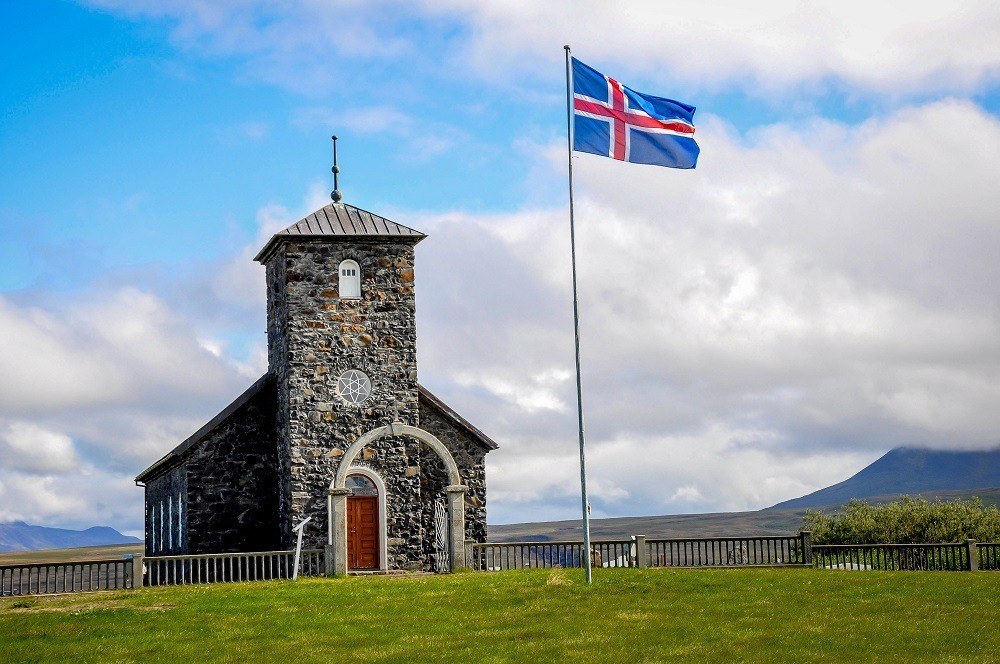
Have you visited before? What where your impressions? When is the best time to visit Iceland?
Lance Longwell is a travel writer and photographer who has published Travel Addicts since 2008, making it one of the oldest travel blogs. He is a life-long traveler, having visited all 50 of the United States by the time he graduated high school. Lance has continued his adventures by visiting 70 countries on 5 continents – all in search of the world’s perfect sausage. He’s a passionate foodie and enjoys hot springs and cultural oddities. When he’s not traveling (or writing about travel), you’ll find him photographing his hometown of Philadelphia.
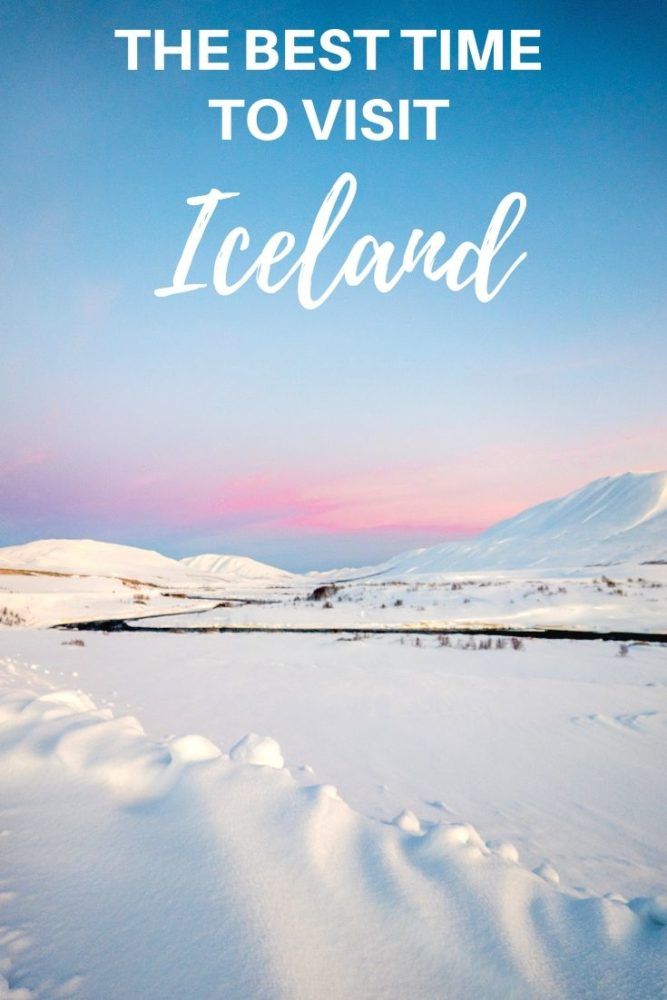
Share this post:
This site uses Akismet to reduce spam. Learn how your comment data is processed .
Thursday 22nd of June 2023
My wife and I are debating when to visit Iceland for the first time-our time is limited to either to the last week of August or the first or second week of September. We are into culture , archeology, nature and cuisine. We are not into hiking or water sports. What time frame should we travel??
Lance Longwell
Friday 23rd of June 2023
If it were me, I'd probably go the 2nd weekend in September. Slightly fewer tourists and restaurant availability will be better. There are a number of cultural events in the fall (film festival, etc.).

The Best Months to Visit Iceland: Fewer Crowds, the Northern Lights, and Prime Puffin Spotting
The best time to visit iceland depends on your itinerary..
- Copy Link copied

Whether you want to see the Northern Lights or go hiking, Iceland has plenty to do and see throughout the year.
Ragnar Th. Sigurdsson/age fotostock
Iceland sparkles and awes year-round, but what you can do while you are there varies dramatically from season to season. For most visitors, the best time of year to visit Iceland is undoubtedly summer, since the daylight stretches to 20-plus hours, and even the most remote regions become accessible.
But the shoulder seasons in May and September are a chance to avoid the heavy crowds, and winter to spring, spanning from October to April, shows a completely different face of the country.
Here’s the best time to visit Iceland, depending on what you have planned for your trip.
Hiking and the Highlands
Best Months: June–August
Part of the majesty of Iceland, of course, is getting out into its roiling lava fields, up on its crater rims, and alongside its thundering waterfalls. Summer is prime for hiking because the snow has melted and the trails have begun to harden (no mud-slush for you!) Also, this is the season when the interior highland F-roads open to four-wheel drive (4WD) traffic and tours—check out Midgard Adventure in the south and Fjalladýrð in the northeast. Some roads begin to open as early as the beginning of June, but others may not open until deep into July, and then they begin to close and become impassable by late August or early September. Similarly, Hornstrandir Nature Reserve in the Westfjords is at its most accessible from June to August.
Plus, in the summer you have upwards of 20 hours a day of sunlight to get out and get moving, and the weather, though always changeable, is at its warmest, averaging from 46 to 55 degrees Fahrenheit. This is also peak time for other activities like rafting, canyoneering, kayaking, and diving the Silfra Fissure at Þingvellir National Park.
Avoiding the Crowds
Best Months: October–April
Iceland in winter, when the weather is cooperating, can give you thrilling opportunities to visit extremely popular places like the Dyrhólaey Peninsula and the Dettifoss waterfall without the crowds. As an added benefit, the car rental and hotel prices drop in some regions. Downside? Outside of Reykyavík, many tourist-dependent hotels, restaurants, and shops close in true winter.
Also, winter exploring is not for the faint of heart if you plan to drive yourself, as roads are often snowy or icy, and snowstorms regularly pass through. Iceland is well equipped, though, with excellent weather forecasting and websites for road conditions , and rental cars have snow tires (a 4WD vehicle is the best bet at this time of year). The rewards are giant: Think about the possibility of standing alone on a volcanic beach in a snowscape of white-and-black drama.
If true winter seems too intense, choose September or May—a good compromise, as average temps range from 40 to 50 degrees Fahrenheit.
Best Months: May–September
One of the grand pleasures of a trip to Iceland is cruising its remote roads through open landscapes and along wave-swept shores, absorbing the majesty of the country. For example, you can make a wellness road trip in the Westfjords , connecting natural springs and town pools with the occasional luxe spa. Or go for a waterfall tour around the Ring Road. The experience is much better in good (or, at least, not bad) weather, so late spring to late summer is an ideal time to visit. However, during high-season summer, the Ring Road can get busy, especially in the south, where most tourists go, creating snaking lines of traffic. This is easily avoided, though, by simply venturing further afield—consider routes like the Diamond Circle route or the Arctic Coast Way .

Come to Iceland in the summer for a chance to have up-close encounters with adorable puffins.
Nicholas Kampouris/Unsplash
Wildlife Watching
Best Months: Puffins May–mid-August, birdwatching mid-May–July, whales April–September
A trip to Iceland offers the opportunity to see wildlife you don’t usually encounter in your backyard. Seasons vary by animal, of course, so if you’re looking for cavorting puffins, come starting in May, when they return from the open ocean, and get there before mid-August, when they leave again. The Vestmannaeyjar Islands are tops for their abundant colonies (they also have a beluga sanctuary), or go on a puffin tour at Ingólfshöfði in the back of a charming tractor wagon.
Birdwatching of other sorts is generally a summer activity in Iceland’s wetlands and lakes. like North Iceland’s Mývatn—birds are most active mid-May to mid-June as they arrive and build nests—and bird cliffs, like Látrabjarg in the Westfjords. Some areas close during nesting to protect the birds’ habitat. The elusive Arctic fox, the only mammal native to Iceland, is tough to spot. It’s most likely to be seen on the move near sunrise and sunset along coastlines and in summer when you can visit the Westfjords’ Hornstrandir Nature Reserve.
Whales and dolphins pass by year-round, and tours leave from Reykjavík, Húsavik (in the north), Grundarfjörður, and Ólafsvík (on the Snæfellsnes Peninsula), but April to late September or early October are the best months because the cetaceans arrive en masse to feed in local waters.
Animal activities, like excellent horseback riding or visiting the Icelandic goat farm at Háafell, though easiest in summer, happen year-round.
Cultural Life
Best months: Year-round
Part of Iceland’s immense charm is its welcoming, fascinating, vibrant people and their culture. And that’s available in all seasons. Sure, summer sees festivals like Pride, National Day, and Reykjavík Arts Festival , and cities and towns are wide open for business. But as darkness spreads across the land, Icelanders play on into the winter at music festivals Iceland Airwaves and Dark Music Days or the midwinter feast of Þorrablót, when Icelanders celebrate their culture, and you can sample fermented, smoked, and unusual (for you!) Icelandic fare. Reykjavík’s excellent museums, galleries, music clubs, and design shops boom year-round.

One of the best places to see the Northern Lights is by Skógafoss Waterfall.
Photo by Balazs Busznyak/Unsplash
Northern Lights
Best Months: September–April
Always a treasure hunt, the search for shimmering curtains of the Northern Lights is easiest with long winter nights—more darkness equals more chance to see them. But you need to find clear skies and high solar activity ( Aurora Forecast is a helpful resource). Interestingly, the most activity occurs around the equinoxes (September/October and March/April), when solar particle ejections are at their highest, though you have a shot from November to February as well, simply because there are up to 20 hours of darkness per night.
Snow and Ice Sports
Best months: glacier hikes year-round, ice caves October/November–March
Naturally, snow sports like skiing are best in winter, when there’s more snow. Same goes for ice caving, when these glistening complexes become more stable at glacier edges. But you can hike on glaciers, ice climb, and go snowmobiling throughout the year. In all seasons, go with a local guide (check out Icelandic Mountain Guides and Tröll Expeditions )—the crevasse-laden glaciers are never stable enough for newbies.


HIDDEN ICELAND
Come & Find the Best of Iceland
BEST TIME TO VISIT ICELAND
When is the best time to visit to iceland this is probably our most frequently asked question. closely followed by, when should i book both questions are great but often more difficult to answer than you might think. believe it or not, iceland is a year round destination so read on to learn about the midnight sun, northern lights, blue ice caves, glaciers, volcanoes, atlantic puffins and lots more., the question of ‘when is the best time to visit iceland’ is a surprisingly complex one. it can also be quite a personal one too., over the years, we’ve found that although there are many reasons to travel to iceland, our guests tend to have one big dream that they want to fulfil while in the country. it is only once an itinerary has been created (and the guests have chatted to us) that they realise there is far more to see and do, at any time of year., so the question, ‘when is the best time to travel to iceland’ should really be ‘ when should i travel to iceland so that i’m able to achieve my dream’, hopefully, by the end of this article, you will know when the best time of year for you to travel to iceland is and when you should start planning (and booking). next step is to match the package option that fits..

A Brief Overview Of The Seasons
Each season has its own unique traits that should be considered before starting to plan your trip. read beyond this to get a more comprehensive understanding of when you should travel to iceland and to know how far in advance you should book your trip., 1. springtime tranquility | april & may springtime is the quietest time of year to travel. whales, puffins and other migratory birds start to appear across the country, and the free-roaming sheep with their new-born lambs are let loose into the wilderness. it tends to be a little more affordable too, based on hotel prices., 2. summer under the midnight sun | june, july & august in summer, you are treated to the warmest time of year and up to 24 hours of daylight. the average temperature sits around 14 celsius (57 fahrenheit) so you’ll never be retreating for the shade after a long glacier hike or nature walk. this is a very family friendly time of year. the highlands open up to adventure, and basking under the midnight sun is something that you’ll remember for the rest of your life., 3. autumn northern lights hunting (september and october) autumn brings with it an increased chance to see the northern lights . it’s still (relatively) warm compared to winter and you get plenty of daylight to match evening northern lights hunts with invigorating daytime activities like glacier hikes., 4. the long winter with newly discovered ice caves (november to march) shorter days, colder temperatures and plenty of snow turn this dark time of the year into a winter wonderland . the average temperature sits around 0 celsius (32 fahrenheit), thanks to the gulf stream, though we are prone to the odd very cold snap too. the biggest draw is the mighty blue ice caves that become safe to visit at this time of year..

When Is The Best Time To Visit Iceland?
1. spring | april & may, the quietest (and most affordable) time of year, springtime is the quietest time of year. even the easter holidays don’t bring as big an influx as you might think, with hotels in reykjavík tending to have space even quite late in the planning process. that’s not to say the rest of the year is overcrowded but if you’re really looking for solitude with good levels of daylight, then coming at this time of year is spot on. although many services remain the same price all year round, hotels and car rentals do tend to drop their prices quite dramatically in some cases., warmth and sunlight, by mid-april the days are already long, with the sunset not being until around 9pm . by the end of may, you are treated to 24 hours of daylight. it’s also warmer than winter as you can imagine, but you are still likely to be treated to snow capped peaks and the odd dusting of snow . you can still technically see the northern lights in the first few weeks in april too, though this shouldn’t be the sole reason to travel at this time of year since there’s less nightime to enhance your chances., wildlife re-emerges, especially in april, the wild reindeer can still be spotted at sea-level, near the jökulsarlón glacier lagoon in the south east (summer is a little too hot for them, so they migrate into the mountains). twenty different whale species return to iceland to mate. athough the atlantic puffins are spotted in spring too, the bulk of them don’t arrive until late may. the flora re-emerges with plenty of colours popping up across the landscape. but the big draw in terms of wildlife is the birthing season of the lambs . there are more sheep than people, so you’ll have a pretty high chance of seeing the odd new-born lamb., best activities to do at this time of year, there are lots of great activities you can take part in at this time of year. from an adventurous glacier hike to whale watching to tranquil horse rides. however, the one activity that works best at this time of year is snowmobiling . the glaciers (where you do the snowmobiling) are truly covered in thick snow all the way down to the edges of the ice. sure, the dead of winter works too in terms of snowfall, but in springtime you’re more likely to get clear skies and nicer weather (pivotal for those breathtaking panoramic views)., when should i book, around 3 months in advance is generally fine, even for private tours . this is one of the few times of the year that you can book relatively last minute and still have a high chance of us being able to help. the earlier the better is always safest of course, but in general if you request a tour for april and may, more than a month in advance should be able to provide something wonderful for you..

2. Summer | June, July & August
Midnight sun and warmth, witnessing the midnight sun is an experience unlike any other. from late may until mid-august, nighttime disappears…literally. this gives you unlimited amounts of time to exlore the country. the sun will still set, but only briefly, making sure any encroaching darkness is held at bay. don’t worry though, most hotels have black out curtains to help you sleep. watching the sun set around midnight only to rise again shortly after is something only iceland and other arctic regions can offer. all of this direct sunlight brings warmth with it too which makes this a great time of year for multi-generational families ., life is flourishing, in stark contrast to winter, summer is bursting with life. the vibrant alaskan lupine bloom across much of iceland’s flat lands, temporarily turning the landscape purple. over 10 million atlantic puffins call the icelandic cliff sides home and over 20 different whale species come to the shores to mate too. add in the release of the 480,000 or so sheep into the wild and you’d be forgiven for forgetting that you are on an isolated island on the edge of the arctic circle., the warmth and sunlight of summer allows you to do most things that iceland has to offer but the defining activities that are best in summer are puffin tours, glacier hikes and travelling into the highlands . this is also the best time to travel around the ring road, whether that’s on a private tour , guided by us, or a self-drive itinerary, if you prefer to have more flexibility., at least 6 months in advance to be safe. a request any later than january/ february can still be planned, but accommodation becomes a bit of an issue on certain dates in some locations. summer is the busiest time of year for sure, but with the entire ring road, highlands, and islands opening up to tourists, there is certainly plenty of room to spread out. last minute requests for summer travel is possible but is often relegated to making reykjavík your base and potentially asking you to join our small group tours ..

3. Autumn | September & October
Northern lights, by autumn, nighttime has truly returned and with it – the northern lights . sure, you can see the northern lights all through the winter and even into early april. but, nearer the equinox it is statistically the most likely time for you to see them. the reason for this anomaly is not fully explained but a mix of slightly more particles entering the atmosphere and a higher chance of having clear skies and you won’t care ‘why’, only that you get to see the light show for yourself., not ‘too’ cold yet, these months are quite funny in terms of weather. you can get days warm enough to wear a t-shirt and other days where there’s a big dump of snow. that’s half the fun of autumn. this is the time of year where the trope, 4 seasons in one day, is most obvious. most activities are still achievable in these months and you can even get around the island by car without too much worry in terms of ice on the roads, until around mid-october., sunsets and rainbows, our guide & safety manager lovingly refers to autumn as rainbow season . the sun drops low in the sky early at this time of year and gives rise to plenty of chances for rainbows. especially when visiting one of the many waterfalls iceland has to offer. if you aren’t lucky enough to see a rainbow, one thing is for sure – those autumn reds, oranges, yellows and mossy greens, really make the landscape pop ., northern lights tours are of course number one here, though not in the way you would expect. the sun still doesn’t set until around 8pm, meaning full darkness doesn’t arrive until closer to midnight. so the best way to see the aurora is not to join a late-evening tour but rather to join an overnight tour where you sleep in secluded locations around the country (our specialty). then you can just step out of your hotel at any time in the night and look up., early september can still have plenty of sold out hotels in the more remote parts of the country early in the year, so aim to book 4 or 5 months in advance just to be sure. october is less of a problem and can actually be requested relatively last minute depending the dates. just be aware that luxury accommodation isn’t as prevalent outside of reykjavík, so if you have your heart set on all luxury accommodation trip, then get in touch as early as you can just in case there are some sold out nights..

4. Winter | November to March
Winter wonderful, you will notice that this ‘season’ is longer than the rest. it would seem iceland’s winters can last a long time. obviously, some might say. but actually, thanks to the gulf stream, the temperature skates around the 2 degrees celsius mark most of winter (with plenty of cold snaps and warm fronts keeping us on our toes). this means you will still likely get a winter wonderful but not the constant sub-zero temperatures that you might have expected., in fact, the reason this season is so lengthy and well defined is for one the activities that we consider a must see – the ice caves effectively, from november to march (and even into april) it is considered safe to enter these beautiful blue ice structures. they can range from snake like tunnels to mighty cathedrals . every season is a little different from the last., despite autumn being the ‘best time’ to see the northern lights , winter is also a phenomenal time too. aside from the festive period, it tends to be quite a quiet time too. even though you’re slightly less likely to see them than in autumn, it does get dark as early as 3:30pm on some days, so there’s plenty of nighttime to play with. this is the time of year where your dinner time can often get interrupted by an excited tourist shouting that they’re ‘ right outside the window’ ., it’s already been said – ice caves and northern lights . but actually, sitting in a warm hot pool with snow surrounding you is also a favourite of many of our customers too. the contrast between the hot and cold is just as breathtaking as seeing the aurora, though maybe in a slightly more visceral way., excluding the festive period (20th of december to 10th of january), you can be quite relaxed with this. november and january are the quietest times (similar numbers to spring) but even in february and march, which are considered key ice cave times, we’re likely to be able to be able to say yes to most requests as late as 3 months out. last minute request are welcome too , though we might just need to be a bit creative with the order, hotel choices and activities..

Activities that can be done all year round
Still undecided here is a run down of some of the activities that can be done all year round:, glacier hikes can be enjoyed all year round. the pristine blue ice in winter makes for some great pictures but the crunchy white ice in summer allows for more adventure. the temperature has little effect on the enjoyment of a glacier walk., horse riding is great fun regardless of whether you are trotting through fresh snow, black sand or volcanic lava fields. the horses are lovely and warm regardless. just don’t call them ponies, they get offended., south coast sights. this area is the least affected by the changing weather of the seasons. although the rest of the country is open year round, with the exception of the highlands, the south coast tends to get less snow and ice on the roads. thankfully our award winning 2 day tour to the jökulsárlón glacier lagoon is also in this region., the golden circle and snaefellsnes are must see locations. snaefellsnes has the most photographed mountain in the country (game of thrones anyone) and the golden circle has a geyser that erupts every 10 minutes. both are easily accessible all year round, each possible as a day trip from reykjavik., have you decided when is the best time to visit iceland yet, hopefully, one of these seasons has stuck out a little more than another for you. if you now have a preferred time of year in mind or want even more details you can get in touch any time . let’s start planning the perfect itinerary together., check out our private tour page for a custom planned itinerary..

Hi, I am Ryan Connolly; Co-Founder and Marketing Manager of Hidden Iceland.
I’ve guided in multiple countries around the world and stepped foot on all 7 continents. my passion for the outdoors, science, nature, glaciers and volcanoes has led me to study and write about iceland. i have been interviewed in forbes , conde nast traveller and travel pulse on various subjects..

One thought
- Pingback: ICELAND PRIVATE & PACKAGE TOURS | HIDDEN ICELAND
Leave a Reply Cancel reply
This site uses Akismet to reduce spam. Learn how your comment data is processed .
Discover more from HIDDEN ICELAND
Subscribe now to keep reading and get access to the full archive.
Type your email…
Continue reading
- Things to do
Iceland in March 2025: Things to See & Do
8 minute read

By Max Naylor
4 February 2022
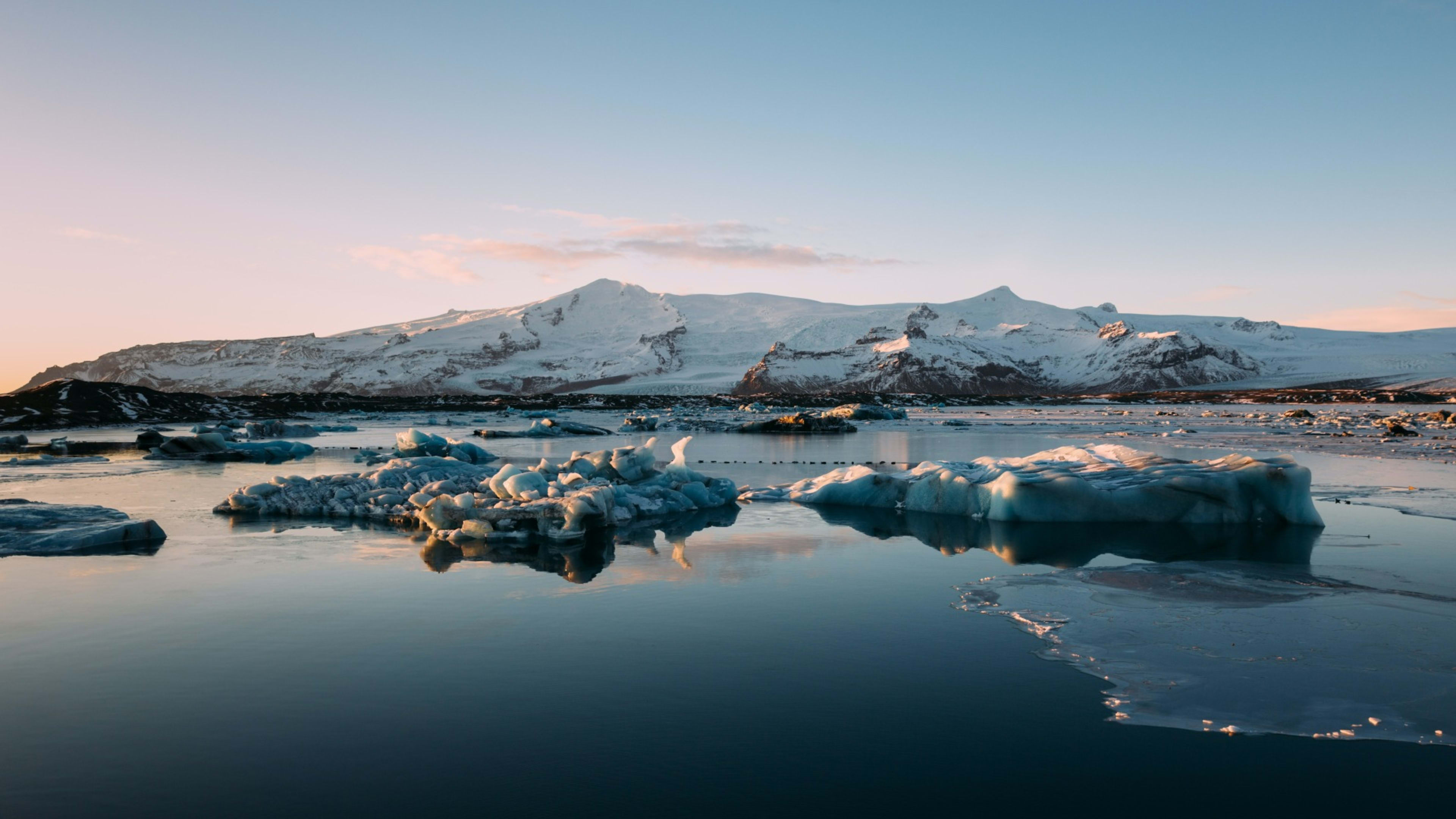
Why take a trip to Iceland in March? You’ve got a great chance of seeing snow, and though the days are getting longer, the Northern Lights continue to appear. That sense of winter magic is still very much in the air.
If you want to make the most of a winter break in Iceland, then the month of March is a great time to visit. You’ll get all the charms of winter, but have much more sunlight than in December, January, or February.
So what does Iceland have in store for you in March? Read on to find out.
- Check out these Iceland winter vacation packages and plan your March trip today.
- Blog: Why visit Iceland in 2023?
Should I go to Iceland in March?
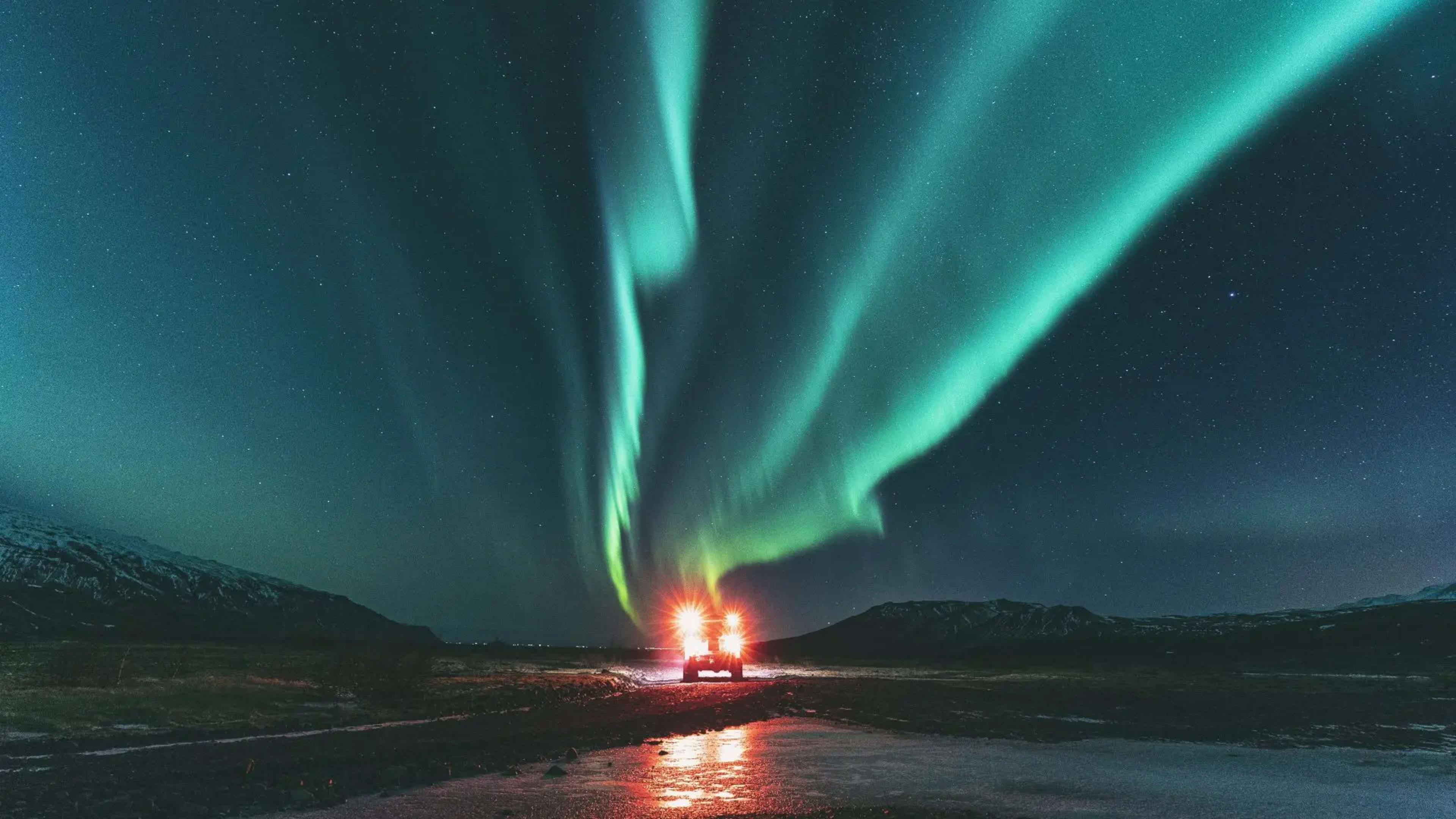
For sure! Even though March is definitely still wintertime in Iceland, it’s a great time of year to visit. It’s normally one of the snowiest months, making for not only beautiful backdrops but ideal skiing conditions.
March also offers you a good balance between day and night. The days are steadily getting longer, but equally you still have enough darkness to go out and hunt the Northern Lights.
Visiting Iceland in March allows you to catch all the highlights of winter before they disappear, including shimmering ice caves, snow-capped mountains, and glaciers at their fullest extent.
- Walk inside a glacier on an ice cave tour in Iceland .
- Blog: How many days do you need in Iceland in winter?
You’ll also be able to enjoy classic natural sights such as geysers, hot springs, waterfalls, volcanoes, and mountains.
Best things to see and do in Iceland in March
You’ve got shedloads of options on a trip to Iceland in March. Shake up your itinerary with a mix of nature and culture, all without having to venture too far from Reykjavík.
Imagine fresh and crisp winter days, with the bright sun illuminating snowy landscapes. Clouds of steam rising from the ground as naturally heated water hits the cold March air. A truly magical sight!

Here are some ideas for things to do in Iceland in March:
- Take a whale watching tour from Reykjavík or Húsavík
- Go glacier hiking and snowmobiling on Langjökull
- Relax and unwind in the Blue Lagoon geothermal spa
- Join ice cave tours in Vatnajökull National Park
- While away the evenings chasing the Northern Lights
- See snow fall on Reynisfjara black sand beach
- Ski the slopes of the Bláfjöll mountains
- Check out the classic gems of the Golden Circle route
- Watch water boil in the ground at the Deildartunguhver hot spring
- Venture to the Snæfellsnes peninsula with its own glacier
- Spot Icelandic horses as you drive through South Iceland
- Soak up culture in Reykjavík or Akureyri
Want to go earlier? Find out what you can do on a trip to Iceland in February .
Events in Iceland in March
Icelandic beer day.
A curious fact about Iceland is that beer was banned in the country until 1989! Every year on 1 March, Icelandic Beer Day (called Bjórdagurinn in Icelandic) is held to mark the day the prohibition was lifted.
You could say we’re living in the golden era of the Icelandic beer scene. Over the past decade or so, craft breweries have sprung up around the country. The selection of high-quality, characterful Icelandic beers grows bigger and bigger every year.
Brewery tours are a great way to experience Icelandic beer culture. Why not visit Borg brewery in Borgarnes, West Iceland? Or if you’re heading up north, you could visit the famous Einstök Brewer’s Lounge in Akureyri.
- Read more about Iceland’s bars & nightlife .
Best places to visit in Iceland in March
1. west iceland.
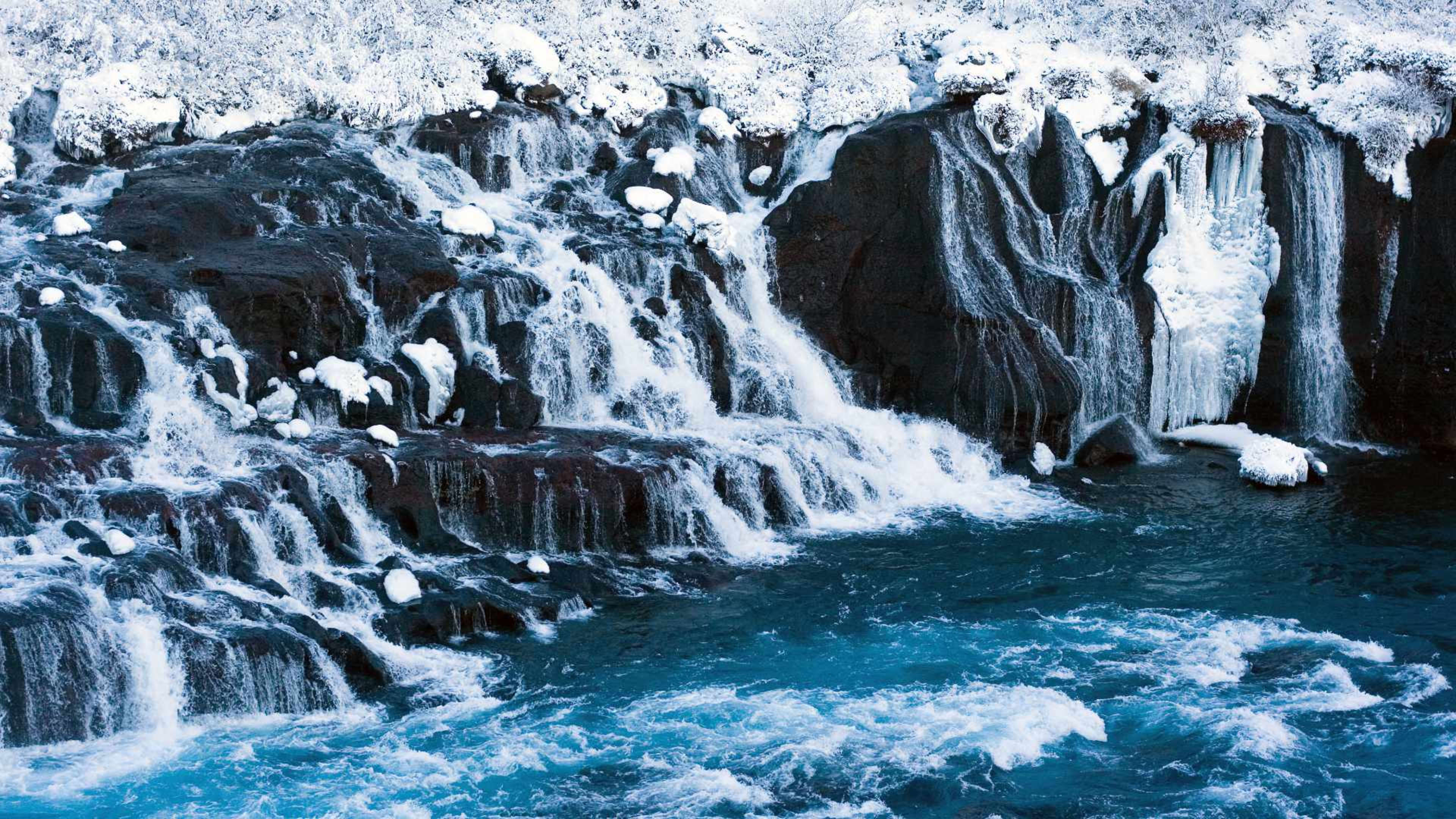
Location: Around 1 hour’s drive north of Reykjavík.
Why visit? West Iceland is easily accessible at all times of year, so it’s perfect for a winter road trip.
For the fast route west, follow the Ring Road through the Hvalfjörður tunnel. Alternatively, you could drive the scenic way around the fjord along route 47. Hvalfjörður has fantastic coastal scenery and is famous for its clean waters, where mussels are harvested.
Check out the quaint town of Borgarnes , one of the oldest in Iceland. If you want to learn more about the first settlers, pay a visit to the Settlement Center museum in the town.
- Explore West Iceland on one of these winter vacation packages .
- Related: Best towns & cities to visit in Iceland .
The jewels in the crown of West Iceland are around the Reykholt area. There you’ll find the awe-inspiring Deildartunguhver hot spring. And be sure to check out Hraunfossar and Barnafoss , two of Iceland’s prettiest waterfalls.
Don’t miss: A guided tour of the Víðgelmir lava cave, if you’re feeling adventurous!

Location: North Iceland, 1–2 hours from Akureyri.
Why visit? Húsavík has been making a name for itself in recent years, mainly as the capital of whale watching in Iceland. The town’s most recent claim to fame though is as the backdrop to the Netflix film Eurovision Song Contest: The Story of Fire Saga.
Whatever reason you decide to visit Húsavík , there’s no denying its small-town charm. Here you’ll also find the Húsavík Whale Museum and Icelandic Maritime Museum.
What’s more, Húsavík boasts its own microbrewery. If you happen to be in town on or around Icelandic Beer Day, be sure to stop by for a cold one!
- Head to Húsavík on a winter self-drive trip around Iceland .
Don’t miss: The charming wooden-framed church opposite the harbor. When it’s open, you can climb the tower for a fantastic view over the sea.
3. South coast
Location: We’ll give you 1 guess.
Why visit? The great thing about Iceland’s south coast is that it’s easy to get to pretty much all year round. In wintertime, its star attractions look fantastic. Chief amongst them are the Seljalandsfoss and Skógafoss waterfalls, which are particularly stunning against the snow.

You could also head down to the Vík area. This popular village is nestled between mountains and the world-famous Reynisfjara black sand beach. And because it’s Iceland in winter, you can’t rule out snow on a trip to the beach!
- Stop off at Reynisfjara on an Iceland Ring Road trip .
- Blog: Your guide to Reynisfjara black sand beach .
Don’t miss: The Reynisdrangar sea stacks. These columns of rock are visible from both the village of Vík and Reynisfjara beach.

4. Golden Circle
Location: Around 1 hour’s drive east of Reykjavík inland.
Why visit? It’s essentially a crime to visit Iceland without doing a Golden Circle tour . Here you’ll find 3 of Iceland’s most famous attractions.
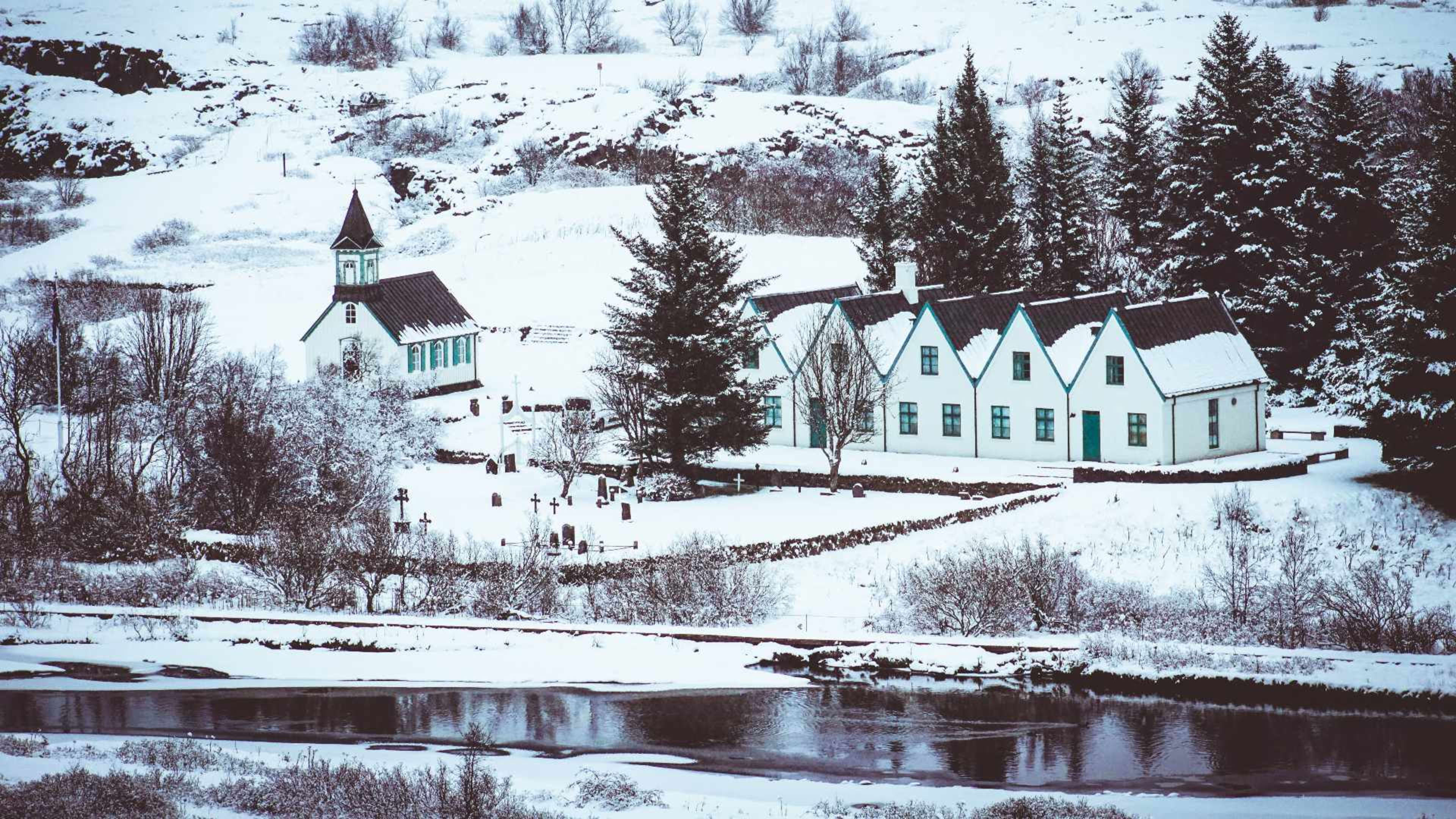
First, there’s Þingvellir (Thingvellir) National Park. This is the site of Iceland’s ancient Viking parliament and spectacular scenery between the Eurasian and North American tectonic plates.
Next, you’ll make your way to the Geysir area . Named after Iceland’s most famous geyser, it’s a hotbed of geothermal activity. Although Geysir itself may now be sleeping, you can see its younger brotherStrokkur erupt every few minutes.
- See Þingvellir, Geysir, and Gullfoss on a multi-day tour from Reykjavík .
- Blog: Your complete guide to the Golden Circle .

The icing on the cake is the jaw-dropping Gullfoss waterfall . Witness the powerful stream of water tumble over multiple sheer rock faces, over a total height of more than 40 meters (130 feet). On a sunny day, you might even be lucky enough to see a rainbow form in the waterfall’s mist.
Don’t miss: Peningagjá gorge at Þingvellir. Throw a coin in here for good luck!
5. Reykjavík culture

Location: Southwest Iceland.
Why visit? Reykjavík is packed full of galleries and museums, which make perfect additions to your itinerary in between adventures into the countryside.
Museums downtown include the Settlement Exhibition, National Museum of Iceland, and Icelandic Phallological Museum. Hold on, what? That’s right, Iceland has its very own museum dedicated to penises of various species.
- Delve into Reykjavík and its surroundings on a city break .
- Related: Best museums in Reykjavík .
On the more conventional side of things are the National Gallery of Iceland, Reykjavík Museum of Photography, and Ásmundarsalur Gallery. The Reykjavík Art Museum is also well worth checking out. It has two main locations: downtown in Tryggvagata, and at Kjarvalsstaðir in the Klambratún park.
Don’t miss: The Nordic House, a short walk from downtown near the University of Iceland. A beautiful library and gallery space designed by Finnish architect Alvar Aalto.
- Related: Best places to visit in Iceland .
What’s the weather in Iceland like in March?

March is wintertime in Iceland, so weather conditions are still pretty cold. But don’t let that put you off!
The average high in Reykjavík in March is 3°C (38°F), whilst the average low is –2°C (28°F). This means there may well be snow, although if you get a warmer day it might not stick around.
Wind is a fairly constant fixture of the weather in Iceland at all times of year. It can knock a couple of degrees off how cold the temperature feels, so make sure you bring extra layers to keep warm.
- March sound too cold? Check out our guide to Iceland’s climate to find the perfect time of year for you.
- Related: Iceland in Spring – Your Guide .
Is there snow in Iceland in March?
Snow and ice are a definite possibility if you’re visiting Iceland at this time of year. In fact, the weather in March tends to be really quite snowy, with heavy overnight frosts.
On average, around 23 cm (9 in) of snow falls across the month in Reykjavík. This makes March the snowiest month of the year.
Is driving in Iceland in March safe?
Driving in Iceland in March can be done perfectly safely. That said, conditions are likely to be different from what you’re used to back home. There’s the chance of frost and snow on the roads, but they are cleared regularly.
You should keep an eye on the weather forecast and check for any road closures. That way you can adjust your itinerary if needed.
- Find out more about driving in Iceland with our car rental guide .
If the temperature climbs above freezing though, the snow will soon disappear by itself.
How many hours of daylight are there in Iceland in March?

The days are starting to get decently long by March. At the start of the month, sunrise is around 8:35 a.m. and sunset around 6:45 p.m., giving you a good 10 hours.
Towards the end of March, the sun is coming up by 6:50 a.m. and setting at around 8:15 p.m. This adds another 3½ hours onto your day.
Good to know: There’s no daylight savings time in Iceland, so the clocks don’t change in March as in many other countries.
Can you see the Northern Lights in Iceland in March?
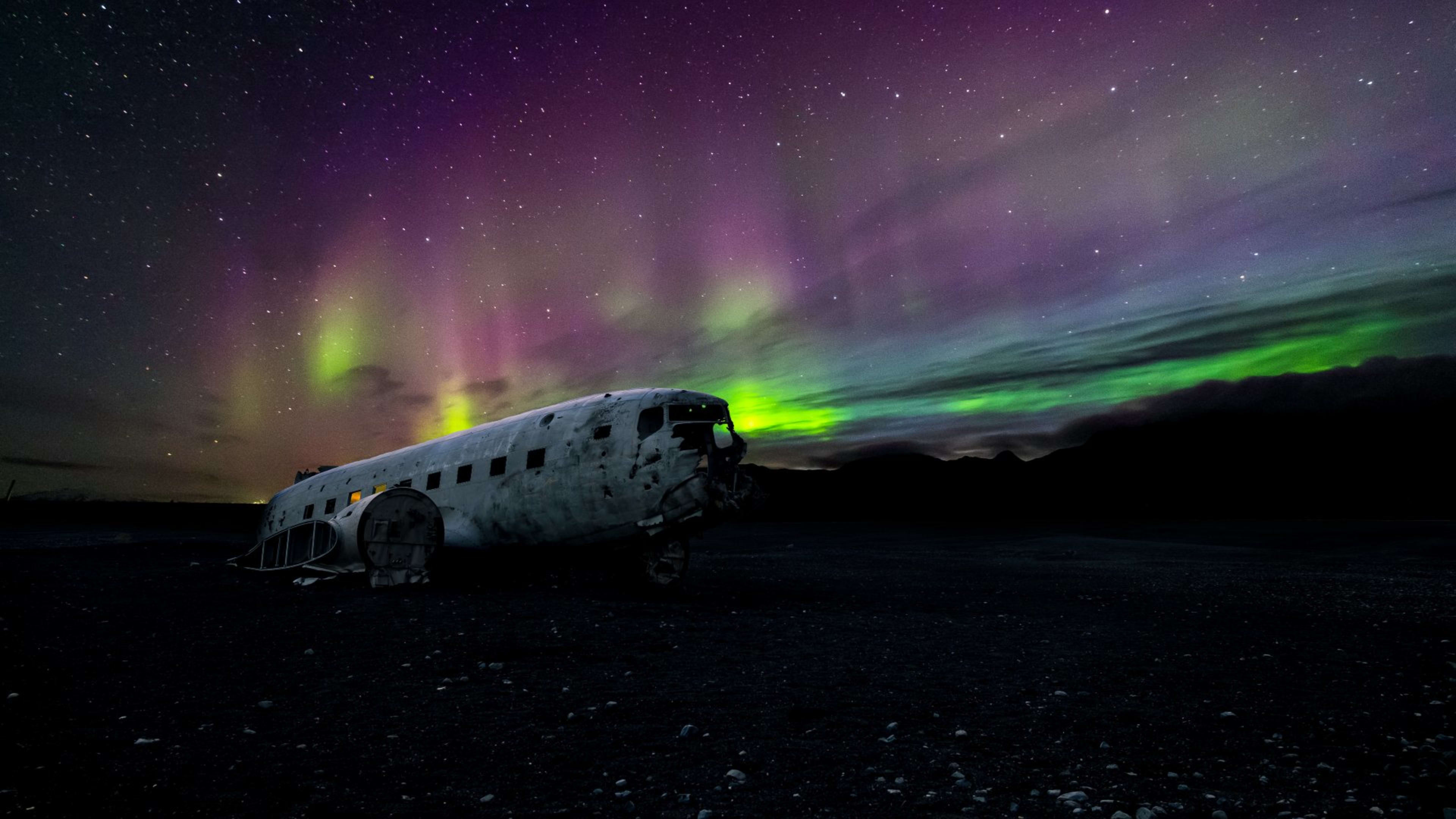
Definitely! To maximize your chances, you should think about a trip in early March if seeing the Northern Lights is top of your list. That way you’ll have more darkness and therefore more opportunities to spot the lights.
Although it’s certainly possible to see the Northern Lights at this time of year, no one can guarantee a sighting. This is because they’re a natural phenomenon dependent on clear skies and high solar activity.
- Blog: Guide to Northern Lights in Iceland .
Northern Lights tours run every evening, and you normally get a chance to go again if you didn’t manage to catch them the first time. So try your luck, and fingers crossed they come out to play!
If you want to know more, check out the best places to spot the Northern Lights in Iceland .
What to wear and what to pack for a trip to Iceland in March
As the Icelandic weather in March is still decidedly wintry, it pays to pack well. Bring plenty of warm layers and extra changes of clothes. Streets can be wet and slushy, so having a spare pair of socks to hand means you’re never far away from being dry and toasty.
Here’s your list of must-pack items for March:
- Warm and waterproof winter coat
- Sturdy, waterproof boots and thick socks
- Gloves, scarf, and woolen hat
- Wooly sweaters
- Thermal underwear
- Swimwear and towel for hot springs and pools
- Lip salve and moisturizer
Read our packing guide to get all the deets on what to bring on your Iceland trip.
Planning your trip to Iceland in March
Now that you know how amazing visiting Iceland in March can be, how do you start putting your trip together? The first step is to pick your dates. Go for early March for more Northern Lights hunting time, or the end of the month if you want more daylight for road trips.
- Rack up more ideas for your trip with our winter must-sees and must-dos .
Next, think about how you want to travel. If you want the most freedom to explore, then a self-drive tour is a good option for you. Start and stop when you like, and take as many detours as you fancy.
On the other hand, if you’d rather not drive in wintry conditions, you could join a multi-day tour . On this sort of trip, you’ll stay in Reykjavík and join different day tours in the Icelandic countryside.
If you prefer a group vibe, you could join a guided group tour . You’ll spend your whole trip with the same driver-guide and pack of like-minded travelers.
With Iceland Tours, you can travel in any of these ways. All it takes to confirm your booking is a 5% deposit. And with our Book with Confidence promise , you have ultimate flexibility should Covid disrupt your plans.
So what’s holding you back? Start browsing winter vacations to Iceland and get that dream trip booked!
- Travel advice ,
About the author
Max has been back and forth from Iceland since 2009. He lived and worked there for several years, and although he’s moved away, he left a piece of his heart there. When he’s in Iceland, he loves to relax in the ‘hot pot’, chow down on some local food, and catch up with friends. He speaks Icelandic fluently, so if you need to know how to pronounce ‘Fagradalsfjall’, he’s your guy.
Related articles
Iceland in january: things to see & do.
All the best things to see and do in the month of January.
Iceland in February: Things to See & Do
All the best things to see and do in the month of February.
Iceland in April: Things to See & Do
All the best things to see and do in the month of April.
Iceland in May: Things to See & Do
All the best things to see and do in the month of May.
The Best Time to Visit Iceland
SD › Best Time to Visit Iceland Updated: March 3, 2024 By Santorini Dave
- Where to Stay in Reykjavik
When is the Best Time to Visit Iceland?
I think the best weather in Iceland is from May to August. This is when you can expect pleasant temperatures and long days. But it’s also high season and hotels, tours, and flights should be booked many months in advance. April and September are reasonable alternatives with decent weather, shorter days, smaller crowds, and cheaper prices.
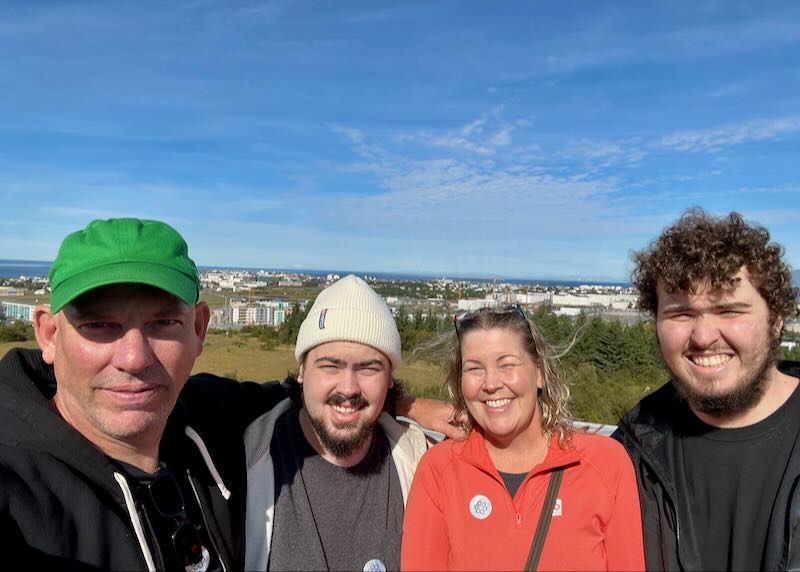
Me, my wife, and my two kids in Reykjavik during an August visit.
- Best Time to See the Northern Lights : Many people come to Iceland hoping to see the aurora borealis, or northern lights. It’s an ideal place to do so, as the country’s small population and long distances between towns make it easy to escape light pollution, even if you’re in or near Reykjavik. There are a number of conditions required for them to be visible, including guaranteed darkness, which is why the best time to see them is from late September through late March, when there are full dark nights. (Although the lights can sometimes be seen as early as mid-August or as late as mid-April.) Another important factor is the weather – cold, clear nights are best for aurora views, because warmer nights often bring precipitation or cloud cover. Solar flares on the sun or solar wind is also required. When all of these conditions are met, you’ll have the best chance to view the colorful dancing lights. As there is less precipitation in October and November along with full dark, chilly nights, these months tend to bring the highest odds for viewing.
- Best Time for Sightseeing : Iceland is renowned for its numerous spectacular waterfalls, geysers, and volcanoes. In order to see as much as you can, you’ll want to have longer days, fewer crowds to interrupt the view, and weather that doesn’t make roads impassable. That means going in the weeks that frame either end of the high season, around the last week of May through mid-June, or anytime in September.
- Best Time for Whale Watching : Generally, the best time to go whale watching in Iceland is from April to October. The peak season is in the summer months: June, July and August, with tours available from Reykjavik, Vestmannaeyjar islands of the south coast, Husavik Akureyri and Dalvik. You aren’t out of luck if you come during the winter, however. Provided a storm doesn’t blow in, winter whale watching is available from Grundarfjordur on the Snaefellsness Peninsula. In the winter months, watchers are given thermal suits, making it fairly comfortable to see the orca whales that follow the herring in the area waters.
- Best Time for Good Weather : The best time for optimal weather in Iceland is during the high season, particularly July and August when average highs are around 13°C, though temps can reach as high as 15°C or even 20°C. If you’re hoping to avoid the rain, the lowest amount of rainfall occurs in May and June, and temperatures are often a pleasant 11°C.
- Best Time for Visiting Blue Lagoon : The Blue Lagoon is one of Iceland’s most popular attractions all year round, though the biggest crowds tend to be there between May and September, peaking in July and August. Winter months are typically the calmest, particularly December and January, outside of the holiday period. Tuesdays and Wednesdays are generally the least crowded days of the week, but more important than the day is the time of day you visit. Peak hours are in the morning, from about 10 a.m. to 2 p.m., and lunchtime is generally the busiest time of day overall. By 3 or 4 p.m., the crowds are much smaller, and you’ll still have plenty of time to enjoy a soak; the lagoon is open until 10 p.m. January 1 through May 25 and August 21 through October 1; until 11 p.m. May 26 through June 29; and until midnight June 30 through August 20, and October 2 through December 31.
- Best Time to Save Money : Airfare and accommodation rates in Iceland are typically cheapest during the winter months, outside of the Christmas and New Year holidays. Prices for everything peak during the busy summer months. If you’re hoping for a combination of lower overall costs and better weather, go during the shoulder season: mid-May through mid-June or September through mid-October.
- Best Time to Avoid Crowds : If you’re hoping for a more relaxed experience without the crowds, avoid going to Iceland in the high season, from mid-June through August. By visiting in April or May, September or October, you’ll encounter fewer tourists, yet the days will be long enough to enjoy sightseeing and possibly decent weather. The fewest visitors come between November and March, but this is also when inclement weather and short, dark days can affect your plans.
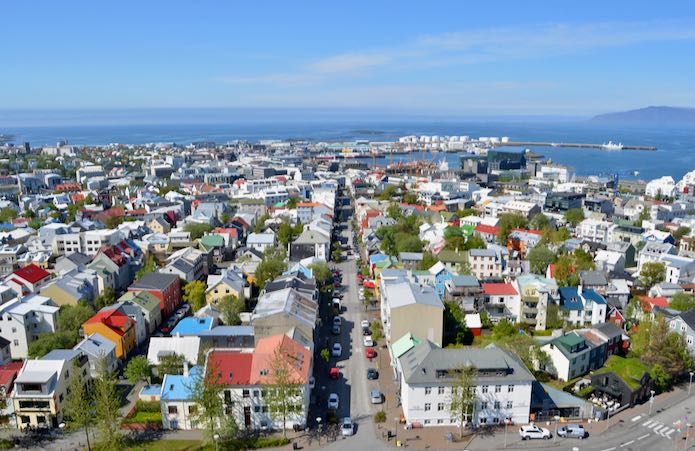
The best time to visit Iceland can vary depending on your interests, but for most people it will be between late April and early September.
Iceland’s Travel Seasons
- High Season (mid-June through August) : Iceland’s high season falls during the peak of summer, when the days are very long (the sun never completely sets on the longest day of the year), allowing visitors to enjoy the country’s myriad of outdoor adventures in the Midnight Sun. This is also the best chance for pleasant weather, but expect to find thicker tourist crowds at popular attractions, higher prices, and greater difficulty finding accommodations.
- Shoulder Season (Mid-May through mid-June, September through mid-October) : Iceland doesn’t have much of a shoulder season, with the majority of visitors arriving during the peak of summer. Coming in late spring, visitors can expect the snow to be thawing, fewer tourists, a wider range of available accommodation, and occasionally lower prices. In early autumn, temperatures may be cool and crisp, with golden light and changing colors on the trees. There will be fewer travelers and some lower prices. The later in the fall you arrive, the better chance you’ll have of seeing the northern lights.
- Low Season (Mid-October through mid-May) : An increasing number of visitors travel to Iceland during the low season for hot springs, winter adventures, and nightlife, but this is still a good time to avoid tourist crowds and enjoy better rates and availability on accommodation, car rentals, and airfare. Winter temperatures in Iceland are surprisingly moderate, generally hovering right around freezing, though days are often dark, with just four to six hours of daylight. Most major roads are plowed, but mountain roads and interior routes will be impassable, and many attractions are shut down, especially outside of Reykjavik.
Iceland Weather by Month
- Iceland Weather in January : January is the coldest month in Iceland, with an average high of 2°C, and an average low of -3°C. When you consider that the temperatures are similar to that of New York City, it’s probably milder than what you’ve envisioned. Winds often reach gale force, however, and when that happens, it does feel very cold. It’s frequently rainy, particularly in and around Reykjavik, and this month (along with February) have the best chance for snow. The days are short, with about four hours of sunlight in early January; sunrise is at 11:19 a.m. and sunset at 3:44 p.m. on the 1st, although by the end of the month that stretches to about seven hours, with the sun coming up at 10:10 a.m. and going down at 5:12 p.m. (Average Max Temperature: 2°C. Average Precipitation: 55mm.)
- Iceland Weather in February : February is similar to January in terms of temperature, but you’ll have more daylight hours to enjoy the scenery. By the end of the month, there are 10 hours of sunlight, with sunrise at 8:38 a.m. and sunset at 6:43 p.m. There is also slightly less precipitation, with an average of 40mm falling in the form of rain or snow. Instead of snow covered streets, you may even see lush gardens, with temps hovering slightly above zero on most days. The majority of attractions and roads in southwest Iceland will be open with the exception of significant storms that may blow through, and most will be wonderfully crowd-free. Dress properly and you’ll stay warm, with temps comparable to winter weather in the northern reaches of the U.S. (Average Max Temperature: 2°C. Average Precipitation: 40mm.)
- Iceland Weather in March : March brings even more daylight, with more sun than darkness throughout the day by the end of the month. As of March 31st, day length increases to 13 hours and 26 minutes – a gain of three hours and 16 minutes in just one month. Temperatures still haven’t changed much, however, and the amount of precipitation is the same as it was in February, meaning it will still feel like winter. Rainy days are as common as sunny days, though in the city of Reykjavik, most snow is likely to be seen on the surrounding mountains and not on the ground. Many roads, outside of the capital area and southwest region, will still be impassable without a 4-wheel drive vehicle. (Average Max Temperature: 2°C. Average Precipitation: 40mm.)
- Iceland Weather in April : While it’s not exactly beach weather, April unofficially marks the start of “summer” in Iceland. Temperatures are on the increase, with an average high of 5°C and lows right at freezing. Precipitation drops considerably, to half of what it was in February and March at 20mm, which can come in the form of snow but most often falls as rain, especially in the lowlands. By April’s end, the length of day has increased to 16 hours and 44 minutes, another significant gain over the previous month, with sunrise at 6:46 a.m. and sunset at 8:19 p.m. As you really should no matter when you visit Iceland, bring lots of layers and waterproof shoes so you can handle anything the weather might throw at you. (Average Max Temperature: 5°C. Average Precipitation: 20mm.)
- Iceland Weather in May : May is often a fabulous time to be in Iceland, with long 20+ hour days, fewer tourists and lower prices. While it’s still a bit chilly by most standards, with an average high of 9°C, there are typically plenty of sunny days. In Reykjavík, the chance of a wet day over the course of the month rapidly decreases, starting at 36% on the 1st and ending it at 29%. That said, the weather in Iceland is always subject to extreme change and can be rather unpredictable, so it’s best to be prepared for the unexpected. In the interior, mountainous areas of the country, there is still a possibility of snow. (Average Max Temperature: 9°C. Average Precipitation: 40mm.)
- Iceland Weather in June : June brings the longest day of the year. While sunrise and sunset hours shift throughout the month, the sun rises on average at 2:42 a.m. and sets at 11:32 p.m. In Iceland’s northern reaches, the sun barely sets before it pops back up again. Temperatures are climbing too, with the average high at 11°C, and it’s not unheard of for temps to reach 15 or even 20°C. There’s also less wind, and less rain, making it easier to enjoy all of those outdoor adventures. Of course, with that brings the peak tourist season, so expect bigger crowds and higher prices, and book accommodations well in advance. (Average Max Temperature: 11°C. Average Precipitation: 20mm.)
- Iceland Weather in July : As mentioned, July is another one of the most popular times of the year to visit Iceland. The weather is often pleasant, though never too hot, and days are still long with sunset averaging around 11 p.m., and the sun rising early, at 3:23 a.m. July boasts the warmest temperatures in Iceland, with average highs of 13°C and lows at 11°C. Of course, like June, temps can creep up quite a bit more than that and you could end up with a number of much warmer days. While you might experience some light rain, average precipitation is still at a minimum. (Average Max Temperature: 13°C. Average Precipitation: 20mm.)
- Iceland Weather in August : Summer in Iceland is short-lived, so expect temperatures to gradually decline this month – though August is still one of the warmest and driest times of the year. Temps rarely dip below 6°C, or exceed 14°C. There’s a slightly higher chance for rain than in June or July, with an average of 30mm of precipitation. Earlier in the month, you’re more likely to experience summer-like days, but as August moves towards September, temperatures drop and a chill comes to the air, especially at night. The days of the Midnight Sun are gone, though you’ll still have lots of daylight for exploring, with sunrise around 5 a.m. and sunset just before 9:30 p.m. (Average Max Temperature: 13°C. Average Precipitation: 30mm.)
- Iceland Weather in September : While the days aren’t as long in September (nearly 15 hours of daylight on the 1st, decreasing to 11 hours and 35 minutes on the 30th), temperatures are often pleasant, crowds have disappeared, and prices start to drop. The earlier in the month you come, the warmer it’s likely to be, with temps as warm as 13°C. On average, the high hovers around 9°C and can dip as low as 5°C. There is a greater chance for rain, and even a possibility of snow, so be prepared by bringing plenty of layers and a variety of clothing. You may even be treated to the northern lights, which can generally be seen, when conditions are right, from about late September through late March. (Average Max Temperature: 9°C. Average Precipitation: 40mm.)
- Iceland Weather in October : By the end of October, it starts to feel like winter in Iceland. This month is a time of transition; the autumn colors are in full swing, temperatures are gradually dropping, and days are increasingly shorter. On October 31st, the sun doesn’t rise until 9:03 a.m., and it sets at 5:18 p.m. The average temperature is a brisk 4°C and drizzle is quite common, so plan for wet, cool weather. On the upside, with the exception of some of the most remote areas of the country, the majority of Iceland is still accessible to tourists, and there are far fewer crowds and reduced prices too. (Average Max Temperature: 6°C. Average Precipitation: 30mm.)
- Iceland Weather in November : Summer is now a distant memory, and while it isn’t as dark or cold as December and January, temperatures drop to an average of around 3°C with lows dipping to about freezing, and the sun shines for only six hours or so, rising a little before 10 a.m. and setting around 4:30 p.m. Of course, the earlier in the month you arrive, the milder the weather and the more daylight you’ll have. Even though it’s likely to be pretty cold, with frequent days of light rain, snow and/or fog, depending on the specific destinations you visit, as long as you dress appropriately, most of the time you’ll be comfortable and find lots to do with fewer crowds to contend with. (Average Max Temperature: 5°C. Average Precipitation: 30mm.)
- Iceland Weather in December : December in Iceland is cold and dark, but it’s also one of the most beautiful months to be in the country, with snow covering the landscape and dazzling holiday lights helping to brighten the darkness. The days are very short, now the opposite of summer’s famous Midnight Sun. While you won’t see much daylight, when you do it has a surreal, iridescent quality unlike anywhere else; this is known as the “long blue,” the blue light that lingers before the sun finally rises. When it does rise, it grazes the sky and then quickly descends below again. You’re almost guaranteed to experience snow, rain, or a combination of both, though the temperature rarely dips much below freezing, with the low averaging -1°C. The weather also keeps many tourists away, so you’re likely to find lower rates and greater accommodation availability. Bundle up and enjoy like the Icelanders do. (Average Max Temperature: 4°C. Average precipitation: 40mm.)
Iceland Events and Festivals
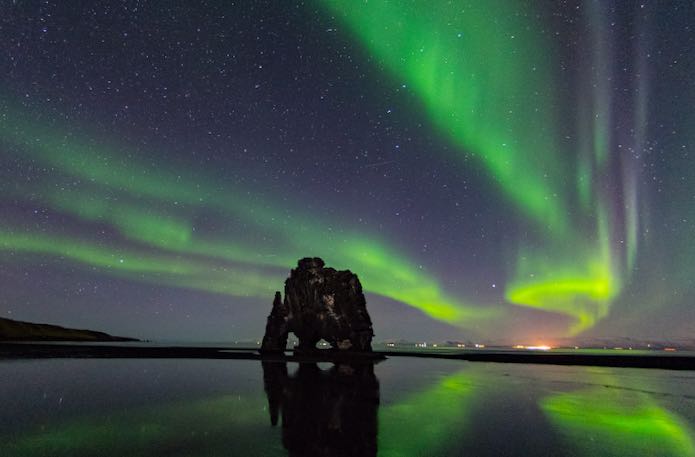
September to March is best time to see the Northern Lights in Iceland.
Iceland in January
- New Year’s Day – January 1st is a national holiday as it is in most nations around the world, though it’s really a two-day holiday here as just about everything is closed until January 3rd. As most people stay up very late on New Year’s Eve, the first day of the new year is often spent sleeping at home and the second-day shopping holiday sales.
- January 6th – January 6 marks the official last day of Christmas in Iceland. Known as “þrettándinn,” it is celebrated with bonfires, traditional songs and fireworks.
- Thorrablot – This is an ancient Viking mid-winter tradition that originally was a feast of sacrifice, involving the blood of goats and oxen. Today, the celebration that starts the 13th week of winter on the Friday that falls within January 19 to 25, includes lots of singing, dancing, drinking and eating traditional Norse dishes like fermented shark, pickled ram testicles and boiled sheep heads. To attend a real celebration, you’ll need an invitation from a local, but some restaurants in Reykjavik offer special Thorrablot dinners.
Iceland in February
- Winter Lights Festival – This festival hosted around the first weekend in February was created to help lift spirits and brighten the winter darkness. The capital city will be dramatically lit up, not only with gorgeous light-art installations, but with a cornucopia of cultural events from choral performances and figuring skating to fashion shows and belly dancing. Other highlights include Pool Night and Museum Night, in which the museums and pools around Reykjavik stay open late and offer free admission.
- Öskudagur – Öskudagur, or Ash Wednesday, is on the seventh Wednesday before Easter (February 14 in 2018). This is when Icelandic children dress in costume and sing for candy, similar to Halloween.
- Food and Fun – For four days in late February, and sometimes early March, the Food and Fun Festival is a time when many of the world’s most acclaimed chefs collaborate with the finest restaurants in Reykjavik. Special menus are prepared that consist only of Icelandic ingredients and are available at participating eateries during the festival. A televised competition is also held in which the top international chefs are challenged to create dishes on the spot, using purely Icelandic ingredients.
Iceland in March
- Beer Day – On March 1st every year, this unofficial holiday honors the anniversary of the 1989 legalization of beer with an alcohol content above 2.2%. To make up for the lost time it was banned (all the way from 1915 through 1989), Icelanders indulge in a beer spree, with celebrations held in pubs, clubs and restaurants throughout Reykjavik.
- DesignMarch – This event held over four days in mid-March showcases Icelandic product design, interior and graphic design, furniture and architecture over three days in mid-march. It hosts workshops, talks, exhibitions and other events, and has attracted big names in the past like Calvin Klein.
- Reykjavik Folk Festival – A three-day music feast held in early March, this event celebrates the Icelandic folk music scene with a lineup of folk artists of various styles and ages.
Iceland in April
- Easter – Easter marks the end to the long, dark winter. Most workers in Iceland get five days off, from Holy Thursday to Easter Monday, which may fall in March or April, depending on the year. Schools and most offices shut down, and many shops may be closed too. This is a time when locals often head elsewhere to visit family and friends, or to the famous ski festival in Isafjordur, which features ski competitions as well as a rock music festival.
- The First Day of Summer – The old Icelandic calendar, in which there are only two seasons, summer and winter, designated the official start of summer on the Thursday that falls within April 19 and April 25. Just about every town in Iceland will have its own celebration which typically includes parades, sporting events, street entertainment and gift giving.
Iceland in May
- Reykjavik Art Festival – This long-running art festival takes place every other year over 16 days starting in mid-May, with the next event to be held in 2018. It features a variety of national and international theater, art, design and dance that’s showcased throughout the capital city.
- Rite of Spring Festival – Hosted in early May, this festival is focused on cutting-edge world, jazz and folk music.
Iceland in June
- Seafarer’s Day & Festival of the Sea – This holiday officially known as Sjómannadagur, is held on the first weekend of June to honor the contribution fishermen have made to Icelandic culture and the economy, as well as to remember those who were lost at sea. In fishing villages across the country, you’ll find it celebrated with lively parties, fantastic local seafood, cultural events and paradise. The fishermen themselves take part in all sorts of competitive events like strongman competitions as well as rowing and swimming races.
- Iceland National Day – This official public holiday commemorates Iceland’s full independence from Denmark on June 17, 1944. One of the most popular events of the summer, the streets of Reykjavik are filled with colorful parades, street performances, traditional dancing, theatrical performances and free outdoor music concerts that last well into the night. Each town honors the day in its own unique way, so no matter where you plan to be, you’re likely to find a celebration.
- Summer Solstice and the Secret Solstice Festival – This relatively new festival is held on the longest day of the year, June 21st. It features rock bands, singer-songwriters, DJs and other acts from Iceland and beyond, hosted on multiple stages over four days under the Midnight Sun. There are also numerous local summer solstice celebrations held on this day in which Icelanders gather to watch the sun dip below the horizon only to quickly rise up again.
- International Viking Festival – The oldest and biggest festival of its kind in Iceland is held in Hafnarfjörður at Viking Village over five days in mid-June. A Middle Age market is set up where costumed “Vikings” sell handmade goods, host staged battles, dance, tell stories and show visitors how to do things like shoot a bow and arrow, carve wood, and throw spears and axes.
Iceland in July
- Innipúkinn Festival – This small annual music festival held over the bank holiday weekend in late July in downtown Reykjavik offers the chance to enjoy some of the country’s favorite bands, bringing in the cream of the crop of the Icelandic music scene. It also includes standup comedians, a music market and a wide variety of food trucks.
- LungA – Hosted in the small town of Seyðisfjörður in East Iceland, LungA offers a mix of art and music in a spectacular location that’s held over seven days in mid-July. It includes live music, a variety of workshops, and a wide range of art on display.
Iceland in August
- Verslunarmannahelgi – The first weekend of August is a bank holiday weekend during which many Icelanders leave town to go camping. The Westman Islands are the most popular destination, with visitors gathering at campgrounds to enjoy live bands and a bonfire that goes on well into the morning. There are also a variety of events held throughout the country.
- Gay Pride – Iceland’s biggest Gay Pride event is held over the second weekend in August. It features concerts, theater, all-night parties and a parade. Tens of thousands pour into downtown Reykjavik to show solidarity and revel with the city’s gay community, making it a fun event for all.
- Reykjavik Marathon – This annual event held on the third weekend of August attracts more than 10,000, from Iceland and abroad. It features a full marathon as well as a 42.2K team relay, a half marathon, 10K, and shorter “fun runs” for kids and adults. It kicks off early in the morning, with races starting and finishing at Lækjargata. Runners also get free admission to all of the city’s pools and thermal baths afterwards.
- Menningarnótt – Menningarnótt, or “Culture Night,” begins when the marathon ends. It’s one of Iceland’s biggest events of the year, and when the streets clear of runners, all types of cultural events fill in that can be found throughout town, in the parks, squares, streets, and individual homes, and ends with an impressive fireworks display.
Iceland in September
- Reykjavik International Literary Festival – This annual festival held in early September is considered one of the most prestigious literary events in Northern Europe and includes Icelandic and international authors. In the past, it’s hosted numerous distinguished writers, including Kurt Vonnegut, Seamus Heaney and David Sedaris. In 2017, it will take place from September 6 to September 9 at various Reykjavik venues.
- Reykjavik International Film Festival – Taking place over 10 days starting in late September, this festival shows a diverse range of non-fiction and dramatic films from more than 40 countries around the world. There are multiple screening venues in downtown Reykjavik that include world premieres and award-winning films from other festivals. It also encourages interaction with other art forms by hosting photo exhibitions, concerts and more.
Iceland in October
- Iceland Airwaves – This festival held over three days in mid-October, showcases some of the best Icelandic indie/alternative music talent, including big names like Of Monsters and Men and Bjork, along with a number of international artists and local DJs. It’s been called the “hippest long weekend on the annual music festival calendar” by Rolling Stone magazine.
- Illumination of the Imagine Peace Tower – On October 9th, John Lennon’s birthday, Yoko Ono invites guests on a complimentary ferry trip to Viðey Island to take part in a gorgeous illumination ceremony.
- Halloween – Celebrating Halloween is relatively new in Iceland, but it’s quickly become one of the year’s biggest party events for adults. There is no trick-or-treating, but restaurants and bars throw costume parties with prizes for the best costume, and many host live music too.
Iceland in November
- Frostbiter – This Iceland Horror Film Festival is hosted in the town of Akranes, about 40 minutes north of Reykjavik, and features horror films and filmmakers from around the world. A mix of horror feature films and shorts are screened over the last weekend in November. It also includes after-parties and other events.
Iceland in December
- Christmas holiday events – Christmas is celebrated in a big way in Iceland. As the days are very short, with just 4 to 5 hours of daylight, you’ll see lots of holiday lights to brighten things up. Annual Icelandic Christmas concerts, one of the oldest holiday traditions in Iceland are hosted, and a group of 13 mischievous trolls known as Yule Lads begin arriving into town, one each night from December 12 through Christmas Eve. Christmas Eve is the most important night of celebration in Iceland, officially beginning at 6 p.m., when the church bells throughout Iceland ring in the Jól. Icelanders typically attend mass which is followed by a Christmas dinner with family.
- New Year’s Eve – New Year’s Eve in Reykjavik is one of the world’s most impressive celebrations. This is the only time of year when private use of fireworks are legal here, and individuals put on their own unique displays that set the skies ablaze. It also includes neighborhood and waterside bonfires that are meant to symbolize the burning away of the previous year’s troubles. Some 500 tons of fireworks can be seen lighting up the sky from every corner of the city starting at around 11:35 pm. There is lots of drinking and singing of folk songs, and some people dress up as elves and trolls. After midnight, the pubs and nightclubs remain open, with the celebrations going on well into morning. At 5 am, locals line up for hot dogs and then head to the hot springs to ease the pain of those inevitable hangovers.
About Santorini Dave


The Best Time to See the Northern Lights in Iceland

When Is the Best Time to See the Northern Lights in Iceland?
What is the best month to see the northern lights in iceland, when can you see the aurora borealis in iceland, can you see the northern lights in reykjavik, what are the best conditions to see the northern lights, 1. strong solar activity, 2. clear skies, 3. as little light as possible.
- Iceland’s Northern Lights Season
Can You See the Northern Lights in Iceland During Winter?
Can you see the northern lights in iceland during autumn and spring, can the northern lights be seen in the summer, what time of night is best to see the aurora borealis in iceland, what else can i do to make sure i see the northern lights in iceland, 1. avoid urban areas when northern lights hunting, 2. extend the length of your holiday, 3. travel across iceland, 4. check the weather forecast for northern lights, 5. be well-prepared and patient.
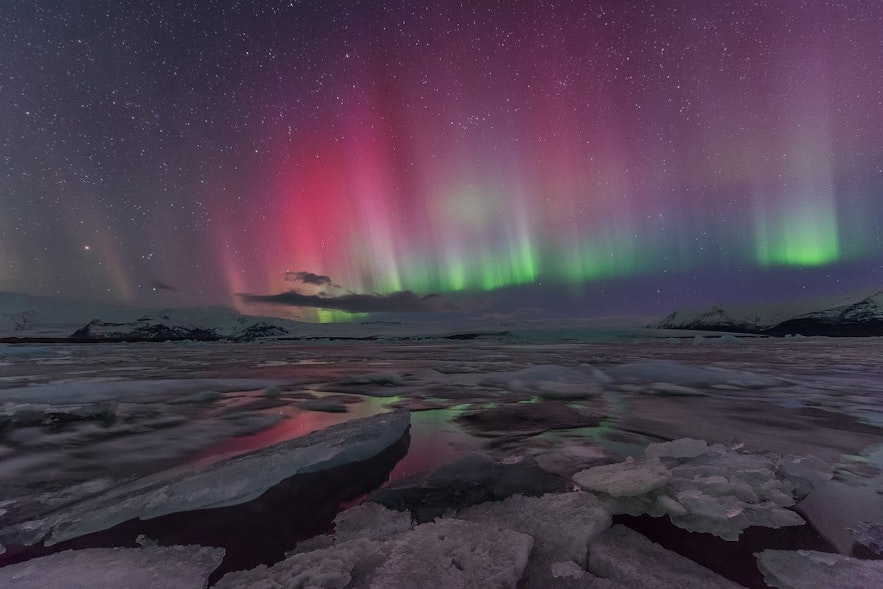
Learn the best time of year to see the northern lights in Iceland. Find out which are the best seasons and months for viewing the aurora borealis in Iceland.
The northern lights are one of nature's most magical sights, but they're also one of the most unpredictable. Maximize your chance of seeing nature’s most spectacular light show with this complete guide before embarking on a northern lights tour or renting a car on Iceland's biggest travel marketplace.
Iceland’s northern lights are one of its major attractions, but the aurora borealis are fickle. They’re only visible under certain conditions, at certain times of the year, and only with enough solar activity. Knowing when you can see the northern lights in Iceland is essential for ensuring you have the best chances of a once-in-a-lifetime viewing.
Top Northern Lights Tours & Holidays
2 day ice cave tour with south coast waterfalls & jokulsarlon glacier lagoon, 3-day northern lights tour of iceland’s golden circle & south coast with ice caving & glacier hiking, 8-day guided northern lights winter tour of the complete ring road of iceland.
- Get to know more about the aurora by reading Northern Lights in Iceland
- Find out all you need to know about Northern Lights Photography
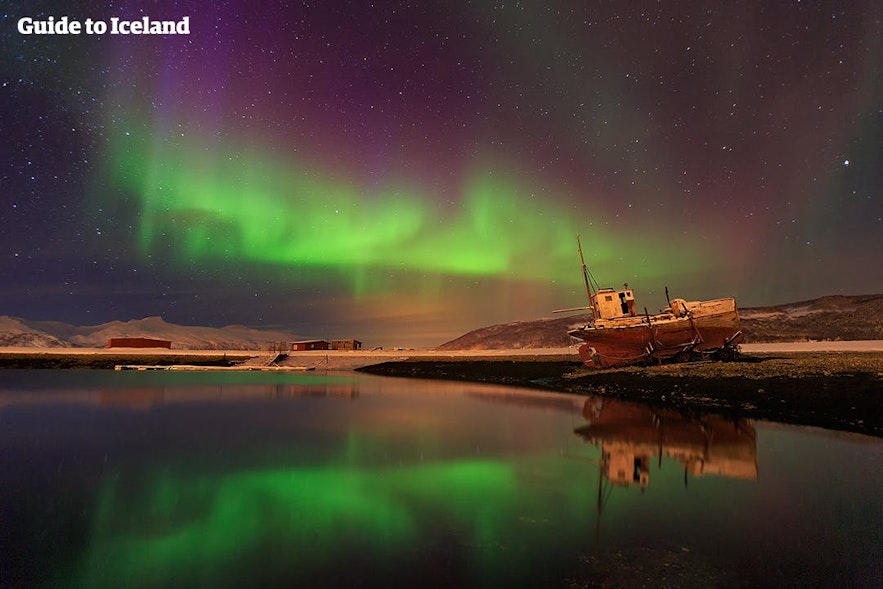
The best time to see aurora borealis in Iceland is between September and April. It’s when the nights are dark enough to see the aurora.
Iceland only gets 4-5 hours of daylight in midwinter, providing endless opportunities to hunt for aurora borealis during that time.
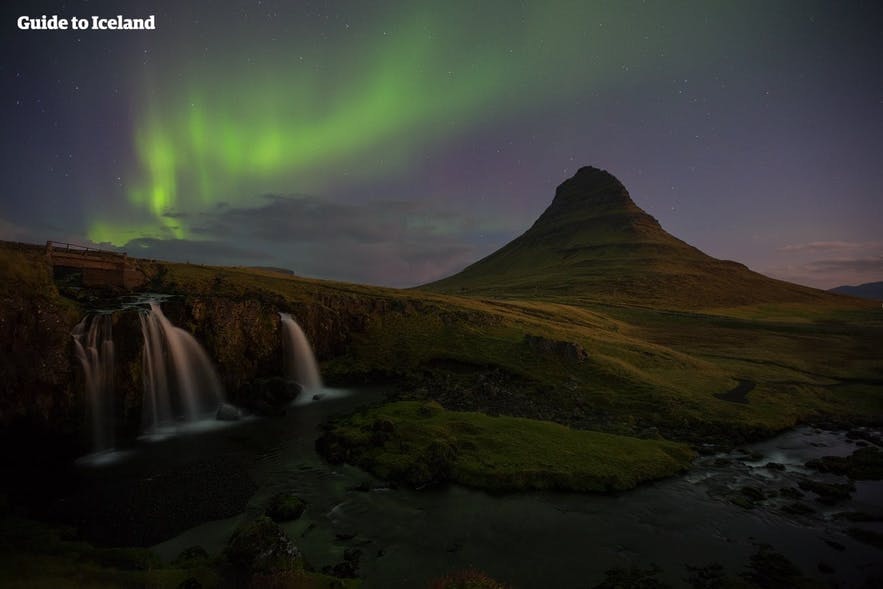
Northern lights tours run between September and April. While there’s no particularly optimum time between this range, the nights are the darkest from November to January. This means you can seek the aurora in Iceland from late afternoon until nearly noon the next day, which provides perfect conditions to photograph the northern lights .
This makes January the absolute best time to visit Iceland for the northern lights, although you have a good chance to spot the aurora borealis in Iceland until April. Then it’s a long wait until September.
- See also: Best Winter Activities in Iceland
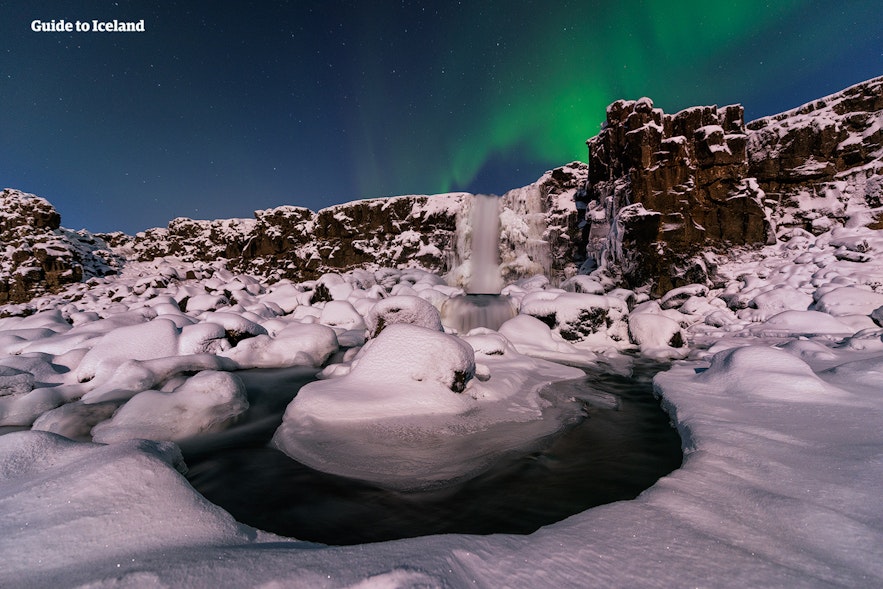
Another advantage of coming in midwinter is that you can see Iceland under a blanket of snow and make the most of Iceland’s other winter phenomena, most notably exploring the crystal blue ice caves , which are only found in a few other places worldwide.
The northern lights appear whenever there’s solar activity, but we can only spot them when it’s dark. Therefore northern lights tours only run in the winter months as the longer nights make the aurora borealis easier to spot.
In general, northern lights are visible between late August and mid-April in Iceland. But that also depends on several other factors. For the best time to go to Iceland for the northern lights, it’s best to aim for the weeks around the winter solstice.

Photo from Mesmerizing 25-Minute Northern Lights Show at Perlan Museum in Reykjavik
Though the urban light pollution usually hampers visibility, you can sometimes see the northern lights from the city center of Reykjavik. There are also areas within and around the city where the lights are more visible. Look for parks and coastal areas, like the Grotta nature reserve or the Sun Voyager sculpture, that are more isolated.
If you want some unique northern light experiences while in Reykjavik, you can combine a northern lights tour with a visit to Aurora Reykjavik , an exhibition dedicated to the aurora borealis. Alternatively, check out the award-winning Northern Lights Show at the Perlan Museum observatory!
- For more, check out the Best Places to See the Northern Lights in Reykjavik
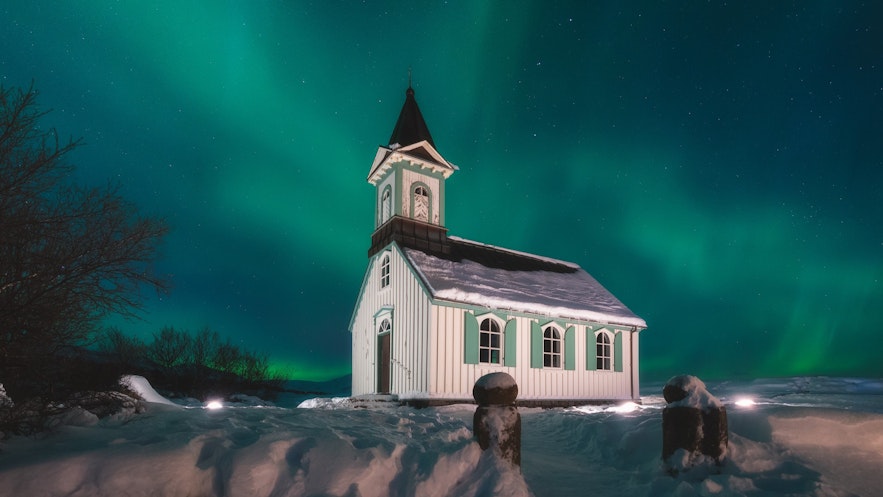
The solar wind is the reason behind the appearance of northern lights. The Kp-index forecast is the measurement unit used to indicate the level of solar activity. The optimum level is above three, and you can check this on the Aurora Forecast in Iceland.
The Icelandic Meteorological Office also has an aurora forecast on cloud covers in Iceland to help you find the best place to spot northern lights.
The darker it is, the easier it is to spot aurora borealis. You can still see the northern lights in Reykjavik and other cities, but the best results are from the remote countryside. See our tips for finding aurora borealis yourself in Iceland , including how to see the northern lights in Reykjavik.
So there is no straight answer to when you can see the northern lights in Iceland since it isn’t just dependent on the season or month but also the meteorological and solar conditions.
Iceland’s Northern Lights Season
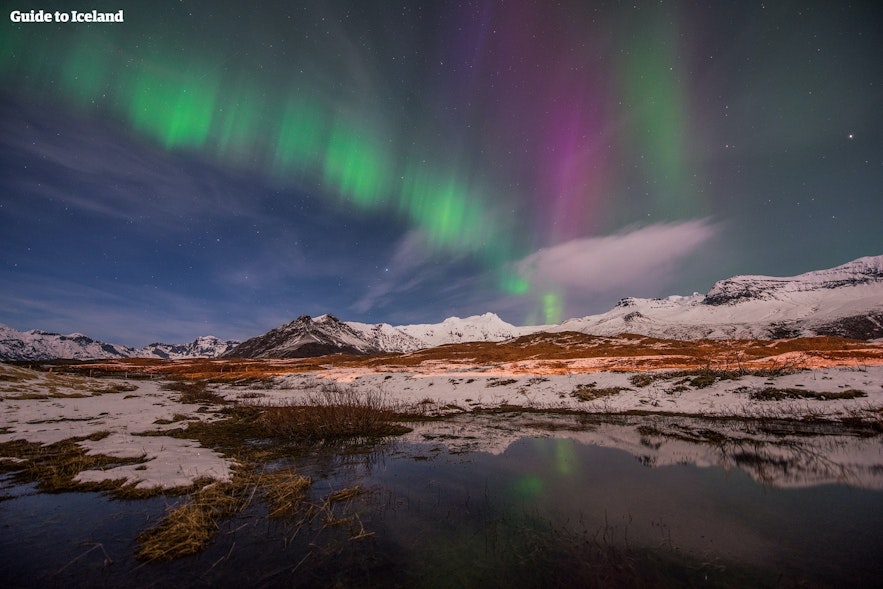
The best time of the year to see the northern lights in Iceland is undoubtedly the winter months. However, throughout these months, Iceland endures its worst weather.
Clouds can block the sky, and therefore the aurora borealis, for weeks at a time. Storms are also more common this season, occasionally leading to the cancellation of tours or the closure of main roads.
There are still plenty of winter activities in Iceland you can enjoy. You can go ice caving , snowmobiling , and glacier hiking before setting out to explore the northern lights each night.
Iceland’s weather is milder in autumn and spring (if still very unpredictable), meaning less chance of cloud cover, although note that the window of opportunity for northern lights hunting is smaller due to the increased daylight hours.

However, many summer tours extend into these months, allowing you to do more when the auroras are not visible. The Thrihnukagigur Inside the Volcano Tour continues until October and will enable you to descend into and explore a vast, unbelievably colorful magma chamber.
Whale-watching from the whale-watching capital of Europe, Husavik, begins in March and lasts until November, providing you the chance to marvel over the giants of the deep.
Keep in mind the best time for northern lights in Iceland is the winter months. However, seeing them in late autumn and early spring is still possible.
In the summer equinox weeks at the end of June, the sun never sets in Iceland. Instead, it circles the sky, touching the southern horizon but never quite sinking below it. The brightness of this ‘ Midnight Sun ’ entirely obscures the northern lights. Through the end of May, the entirety of June and July, and the beginning of August, the nights are still too bright to see the auroras.
- See also: The Midnight Sun in Iceland
Despite this, you can still see the aurora borealis faintly during the short hours of darkness at the very beginning and end of summer. Usually, they will be seen dimly against a dusky sky, often making for a uniquely beautiful display considering how vivid the colors of Iceland’s sunsets can be.
Even so, you have much less chance of seeing Iceland’s aurora borealis during these times, as they will need to be particularly intense to be visible, and there’s a much smaller window of opportunity to seek them. Suppose you want to see the aurora borealis in Iceland while still enjoying relatively mild weather and the option to partake in most summer activities. In that case, it’s recommended you come in September.
Top September Tours
- See also: Iceland in September
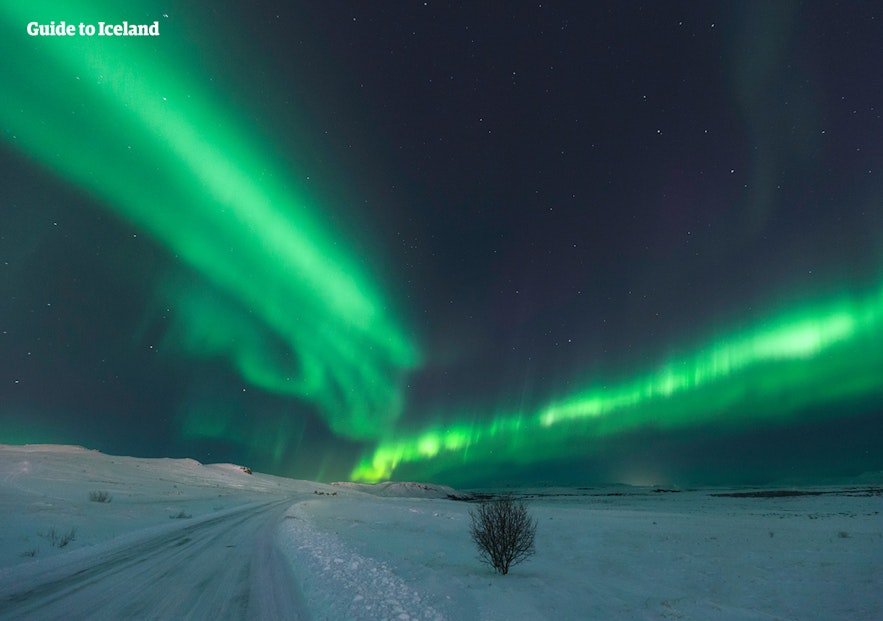
You can see the aurora borealis in Iceland whenever the sky is dark. Therefore, in December , they may be visible from three in the afternoon until nine in the morning. However, due to the Earth’s rotation, atmosphere, and magnetosphere relative to Iceland’s position on the globe, they are most likely to be seen between 10 PM and 12 AM.
This is when most northern lights tours set off. It also means that when the tours end, you’ve searched through the optimal time and back home early enough that it won’t compromise your plans the next day.
If you’re renting a car in Iceland and taking a winter self-drive tour tailored to the aurora borealis, you can search for the northern lights throughout the night. But you should remember to avoid sunrise and sunset when light pollution significantly dims them. If you are out well into the early hours hunting for the auroras, it’ll be noticeably colder, so dress accordingly.
Top Winter Self Drive Tours
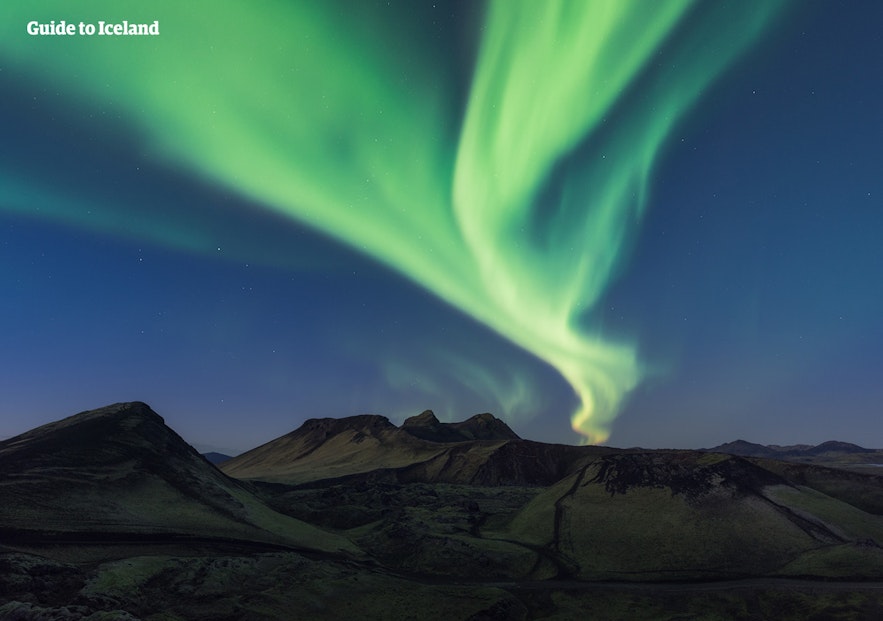
Witnessing the northern lights in Iceland always requires some luck. Some travelers dead-set on aurora hunting may encounter cloud cover or a lack of solar activity every night of their holiday. Others, traveling for one night in August , might be blessed with a fantastic show without even looking for it.
Other than waiting for a clear winter’s night, there are several ways to optimize your chances of enjoying a fantastic display of the aurora borealis in Iceland.
Just hoping you see a northern lights display without laying any groundwork is probably not the wisest option. There are several easy steps you can take to increase your chances:
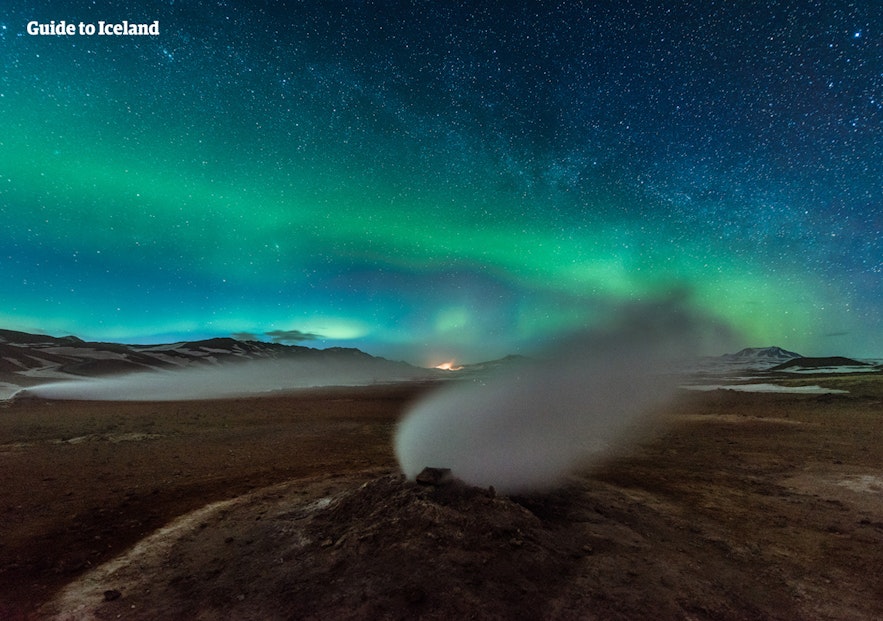
All lights have the same dimming effect on the auroras as the sun. If you’re in Reykjavik and want to see the northern lights, you must move away from the light pollution. You can take a bus to the Seltjarnarnes Nature Reserve , which is fairly dark compared to the rest of the city. However, you are more likely to achieve better results by booking a tour or driving out into the dark surrounding landscapes.
If you are on a guided package or self-drive tour, your route will take you out into the reaches of Iceland’s nature, maximizing your chances of catching a show every night.
If traveling to Iceland for just a weekend, you only have two or three nights in which to go aurora hunting. Considering the unpredictable weather and fickle nature of the aurora borealis, you’re not setting yourself up for success.
You’re statistically more likely to see the northern lights by staying in Iceland for an extended time.
A two-week-long vacation spent in different parts of the country will significantly increase your chances of a lucky night in perfect conditions.
Travelers could also consider spending much or all of their holiday in North Iceland . The nights here are longer, and the sky is usually less cloudy, providing increased opportunity. During the northern lights season, the north is also less busy than the Reykjavik area, allowing you to avoid the crowds at the most scenic viewing spots, such as the marvelous Myvatn lake or frozen waterfall Godafoss .
Iceland’s weather website has regularly updated pages revealing the predicted and current cloud cover around the country, allowing you to plan to reach the areas with the clearest skies. The aurora forecast measures from zero to nine, with three and above considered promising.
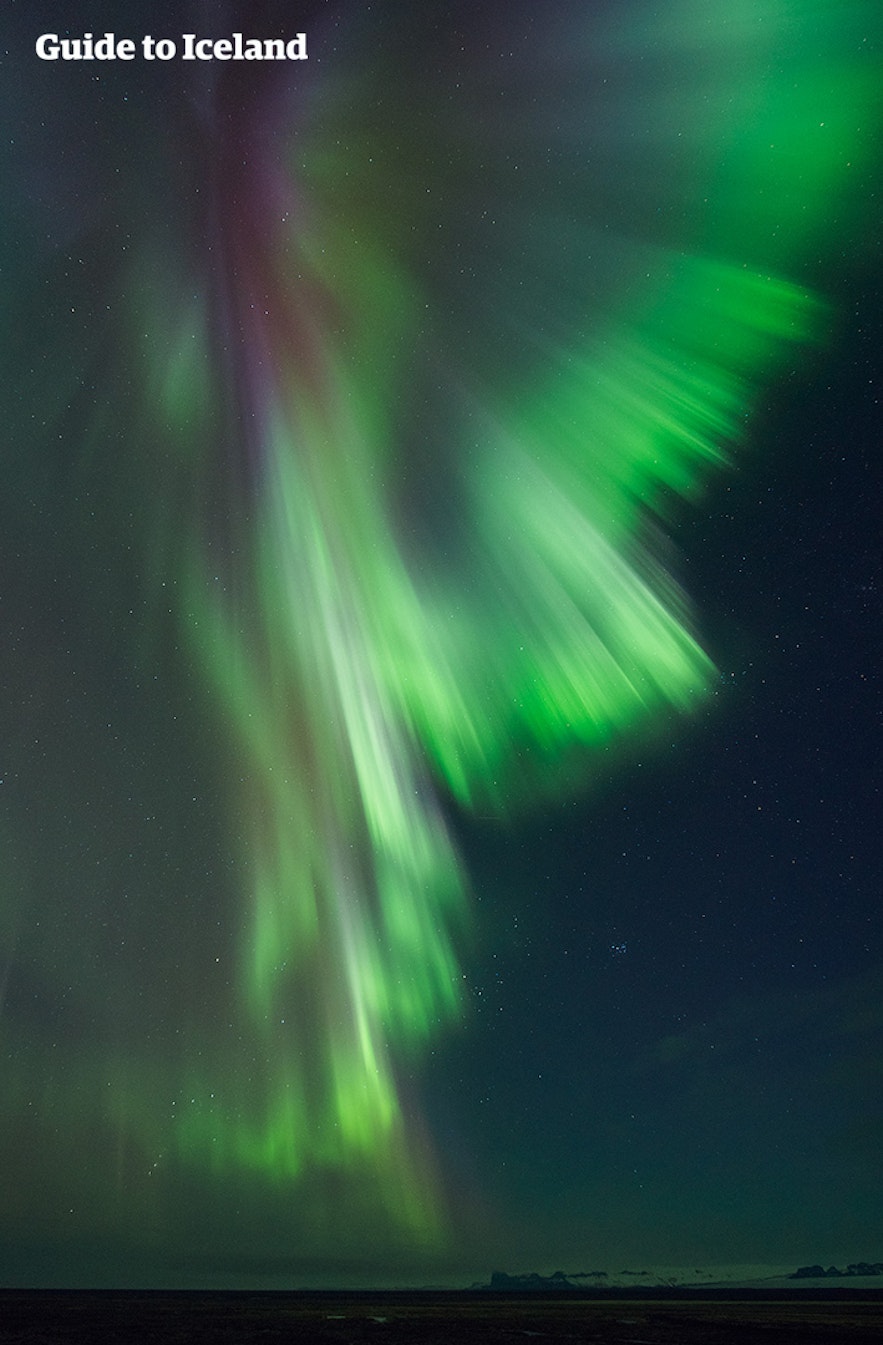
It'll take several minutes for your eyes to adjust to the darkness of Iceland's winter nights, so stay a while at each spot, even if the sky appears clear. The northern lights can also begin at any moment, so don't rush away if they aren't immediately active.
Make sure you have many layers of warm clothes - and perhaps some hot cocoa -so you can comfortably wait for the auroras as long as you need. When it comes to northern lights hunting, just a little bit of patience can lead to the most incredible rewards, which no doubt you will remember for the rest of your life.
Do you have any other questions about hunting the northern lights in Iceland? What time of year are you planning to visit? Are you considering a self-drive trip or taking a northern lights tour? Log in to Facebook to see or add to the comment section below!
Popular articles

Guide to Iceland | The Story of the Leading Travel Agency of Iceland

The Complete Guide to the Midnight Sun in Iceland

Top 20 Most Beautiful Waterfalls in Iceland

22 Photos of the Aurora in Iceland

Mountains in Iceland
Other interesting articles.
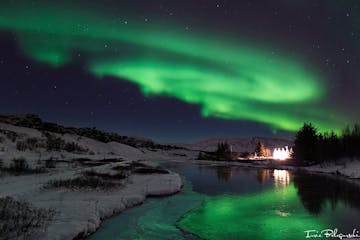
How to Photograph the Northern Lights
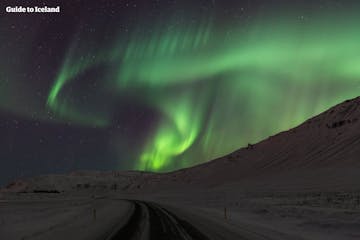
Northern Lights in Iceland - When & Where To See the Aurora
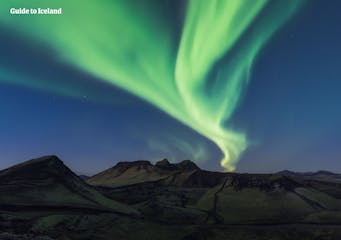
FAQ About the Northern Lights in Iceland | Science & Mythology

Download Iceland’s biggest travel marketplace to your phone to manage your entire trip in one place
Scan this QR code with your phone camera and press the link that appears to add Iceland’s biggest travel marketplace into your pocket. Enter your phone number or email address to receive an SMS or email with the download link.
Top things to do in Iceland
Book your complete trip with the best companies only

Explore an Ice Cave

Visit a Live Volcano

Find the Northern Lights

Visit the Blue Lagoon

Go on a Road Trip

Do the Golden Circle

See the Glacier Lagoon

South Coast Tours
Aurora Tracks See Northern Lights

ICELAND Northern Lights Month-by-Month Planner

Planning a successful trip to Iceland for the aurora begins with choosing the right time of year. In this article, we breakdown Iceland Northern Lights month-by-month, and explain what the best month to see northern lights Iceland is.
Iceland is well-renowned as a prime aurora-chasing destination, with many tours and accommodation designed around aurora hunters seeking a glimpse of these spectacular lights. However, despite the inspiring photos and travel marketing hype, it is not as simple as wandering over to the icy land, stepping outside your hotel, and seeing them blaring in the sky whenever you like. There are many factors that come into play which allow you to see the northern lights, and the most important one is choosing the right time of year.
If you plan on visiting Iceland to view the northern lights, it is important to make sure that you plan ahead of time. Every year, countless people make their way up to Iceland in order to hunt for the elusive auroras, which can make it very difficult to find available accommodations if you are searching at the last minute. In this guide, we explain the best month to see Northern Lights Iceland, to ensure you plan and book your trip for the right time and give you the best chance of seeing them. We also explain other factors that affect aurora visibility, so you can plan your trip accordingly.
So, read through this guide as well as our other Iceland Northern Lights articles here , and start planning for a wonderful aurora vacation.
Factors Affecting Iceland Northern Lights Visibility
There are many factors that affect the visibility of the aurora borealis in Iceland. These include the location, the Earth’s magnetic activity, solar activity, weather conditions, light pollution, both the season and time of day, as well as the solar cycle.
Geographical Location
The closer to the poles you are, the easier it is to view the elusive lights. In the northern hemisphere, the best locations to see the aurora borealis are Alaska, Scandinavia, northern Canada, and of course Iceland. The chances of catching a glimpse of the northern lights increase as you get closer to the magnetic poles.
Magnetic Activity
The magnetic activity also plays a very important role in the visibility of the auroras. The lights themselves are actually caused by an interaction of the sun’s solar radiation with the Earth’s magnetic field. When magnetic activity surrounding the planet increases, it helps to enhance the visibility as well as the intensity of the northern lights. The best time for viewing the auroras is when geomagnetic storms are at their highest.
Solar Activity
Naturally, solar activity is crucial to the creation of auroras. The more active the sun is, the greater the visibility of the northern lights. During solar cycle peaks, large amounts of radiation are ejected from the surface of the sun into space. As this solar radiation passes around the Earth’s magnetic field, it results in an ionization of the upper atmosphere. This ionization is what creates the northern lights.
Weather Conditions
While the actual weather conditions play very little role in the creation of the auroras, they are crucial to ensuring that the elusive lights are visible. It takes very little cloud cover or precipitation to completely obstruct the view of the northern lights. This is why most aurora hunters prefer seeking out the elusive lights during the winter months. The skies are darker and clearer during the winter months than at any other time of year.
Light Pollution
The closer you are to a major city, the greater the chances that light pollution can interfere with your ability to see the northern lights. If you have ever taken a trip to another part of the country, then chances are you could easily spot where a major city is on the horizon, by the halo of light that envelops it at nighttime. This is light pollution, and it can greatly diminish your ability to view the elusive lights.
Season and Time of Day
The auroras are technically visible year-round. Astronauts in outer space can view the elusive lights regardless of the time of day or season. But on earth, it is best to hunt for the northern lights during the time of year when the night is the longest. The longer the night, the darker the skies, and the easier it will be to view the auroras.
Solar Cycle
The level of solar activity peaks every 11 years. This is known as the solar cycle. And while it is possible to view the northern lights during the winter when the solar cycle is at its weakest, the odds of capturing a glimpse of the elusive lights increases during the peak of the solar cycle. During the last major solar cycle, the solar activity was so great, that the auroras could be seen as far south as France and Kentucky. For further explanation of the best years to see the aurora and the solar cycles read our article here .
BEST MONTH TO SEE NORTHERN LIGHTS Iceland
When it comes to viewing the aurora borealis in Iceland, the best time of year is between September and April. While there is no guarantee that you will actually view the auroras when visiting Iceland during these months, the odds of catching a glimpse of them increases substantially.
The best months to view Northern Lights in Iceland is September to April.
Of that period, many seasoned aurora hunters choose to do their northern lights hunting in September and October , or February and March . These months are close to the equinoxes which some people have said anecdotally is best for aurora activity. More importantly, these months side-step the snow storms of Winter, which bring in cloud cover that can obstruct views of the aurora. Not to mention, it is more pleasant being outside when it’s not so cold that your hair freezes and breaks off.
Iceland Northern Lights Month-by-Month Planner
It is possible to capture a glimpse of the elusive lights in Iceland over the course of an 8-month period. Starting in September, the days begin to shorten and the nights become longer. This continues on until the peak of winter when the night lasts for nearly 24 hours each day. As the seasons segue from winter into spring, the chances of capturing a glimpse of the auroras decreases with each passing day.

Considerations for Iceland Northern Lights in September:
September is one of the first months of the year that the northern lights can be routinely viewed in Iceland. It is best to visit the country towards the end of September when the weather is still hospitable, but the longer nights provide ample opportunity to hunt for the lights. For sightseeing, the countryside is beautiful as the trees express their red and orange autumn colors, and the days are still mild enough to walk around outside comfortably.
Iceland in October Northern Lights Considerations:
By October, as the nights continue to get longer, the weather conditions change and tend to become a little more difficult to predict. While the temperature is still bearable during the daytime, the night brings the first major snowstorms of the year. As a result, it’s important to pay close attention to local forecasts before making your way out into the Icelandic countryside to hunt for the lights.
Considerations for iceland northern lights november:
The nights continue to get longer throughout November, and the air gets increasingly colder. During this time of year, the snowstorms tend to even out, making it easier to predict the best time to head out into the countryside to view the auroras. Make sure to avoid a full moon, as the moon can create excessive amounts of light pollution.
Considerations for iceland Northern Lights in December:
December provides some of the longest nights of the year. It is also one of the coldest times of year to visit Iceland. While it may be one of the best times of year to visit the country and view the auroras, keep in mind that it is also the most popular time of year for tourism. During December, most of the lodgings will be fully booked.
Considerations for January Northern Lights in Iceland:
During the month of January, the skies are clearer than any other time of year. The nights are at their longest, and the temperatures at their coldest, but the odds of catching a glimpse of the elusive auroras increases substantially. Due to the frigid conditions, the chances of finding vacancies increases as well.
Considerations for February Northern Lights in Iceland:
As the year segues from January into February, the nights begin to shorten and the days grow longer. Nevertheless, the nights are still long enough to ensure plenty of opportunities to view the elusive lights. The skies are generally clear throughout the month, which enhances the visibility of the lights as a dance through the heavens.
Considerations for Iceland northern lights in march
By March, the first thaws of the year begin to warm the Icelandic countryside making it more bearable for aurora hunters. While the nights are still long enough to view the lights, the odds of capturing sight of them decreases with each day. Early March is one of the most popular times of year for seeking the northern lights throughout Europe. However, the snow melt will make the ground wet and boggy for outside hiking, so be prepared and take a good pair of boots.
iceland northern lights in april Considerations:
During the earliest parts of April, it is still possible to view the northern lights in Iceland. However, as the month progresses, it will be increasingly difficult to view them. By mid-April, the chances of capturing a glimpse of the elusive lights fade into oblivion.
May, June, July, August – AVOID THESE MONTHS
Iceland northern lights in may-august considerations:.
While this time of year is popular for vacationers as it coincides with summer break, when it comes to aurora-hunting it is very important that you avoid these months. The days are simply too long and bright, and the short nights do not have the deep darkness that is needed to reveal the northern lights.

Common Question: Can you see the northern lights in Iceland in July?
No, for one main reason, there is too much sunlight. In the northern regions of the world close to the Arctic Circle, the daylight hours are extremely long, reaching almost 24 hours in some parts. For successful northern lights watching, you need total darkness, to allow the aurora to shine against the dark sky. While the aurora borealis is always there, you can only see it when it is dark. Think of northern lights viewing like star-gazing – the stars are always there, but you can’t see them during the daytime because it is too light. The same principle applies to the aurora borealis. It is simply not dark enough to see northern lights in Iceland in July. You will not be able to see northern lights in Iceland in during the entire period of May, June, July for this reason.
Day Activities to Enjoy While Waiting for the Northern Lights in Iceland
While there are some who visit Iceland purely to view the northern lights, many other visitors to the country want to experience all that the country has to offer. This is why most lodgings offer a wake-up service when the lights appear, and provide an endless list of activities to keep you busy throughout the day. Here are some of the best daytime activities to keep you busy while waiting for the northern lights to appear.
Whale Watching
Of course, nothing beats getting up close and personal with whales. May to September are the best months for catching whales crossing through the Icelandic waters, so if you’re visiting Iceland northern lights in September make sure to include whale watching in your itinerary, too. There are countless whale-watching opportunities throughout Iceland. Some of the best destinations to find a whale-watching expedition are Reykjavik, Akureyri, and Husovik. You will have the opportunity to view orcas, humpbacks, as well as minke whales.
Golden Circle Tour
One of the most popular attractions in Iceland is the Golden Circle. This is a route that takes visitors to 3 of the most popular destinations in the country. Visitors who take a tour of the Golden Circle will be able to visit the Geysir geothermal area, Thingvellir National Park, as well as the Gullfoss Waterfall.
Glacier Hiking
For those feeling a little more adventurous, there are plenty of guided tours that will take you hiking out on a glacier. They provide you with all of the proper equipment that you need and an experienced guide will take you out to explore the awe-inspiring landscapes that stretch on for miles.
Ice Cave Explorations
Naturally, if there are glaciers in Iceland, then there are also ice caves to explore. Take advantage of a magical expedition through the many beautiful, blue, ice caves in the country. Experienced guides will take you on an amazing expedition through the frigid blue caves.
Snowmobiling
For those looking for a little bit of an adrenaline rush, snowmobiling is always an excellent way to see the Icelandic countryside. Strap on a cold winter suit, and head out onto a glacier on the back of a high-powered snowmobile as it cuts through the Icelandic countryside at break-neck speeds.
Hot Springs and Geothermal Spas
Not only is Iceland known for its stunning snow-covered vistas, but it is also well known for its geothermal activity. Due to the high level of geothermal activity in Iceland, hot springs are found at many different sites. The most popular hot springs in the country can be found at the Blue Lagoon.
Snowshoeing
During the peak of the winter months, when the Icelandic countryside is covered with fresh layers of powdery snow, the best way to view the magnificent vistas is by snowshoeing through the countryside. There are countless trails and experienced guides will take you on an amazing adventure through the wintry scenery. Since snow is of course essential for this activity, the best months for it are the most snow-covered ones, from December to February/March.
Dog Sledding
But, if you’d really like to view Iceland the way it was meant to be seen, then you have to take a dog sled. There is nothing more thrilling than being pulled across the snow-covered landscape by a team of friendly yet energetic huskies. The time of year to enjoy dog sledding is of course in winter, from November to March, since snow is essential for this activity. But beware, from personal experience, being pulled in a sled at high speed in January is terrifyingly cold, to the point of fearing I had frostbite on my toes – despite that, it was truly a memorable experience.
Final Tips for Iceland Northern Lights Month & Time
By now, you should have a pretty good idea of Iceland northern lights month and time of year options for your aurora vacation. To summarize quickly, the best month to see northern lights Iceland is September to April. To fine-tune that time period, you may like to consider September-October or February-March for your trip. While December and January are very dark and renowned for northern lights, those months are often plagued by snow clouds and it is bitterly cold to spend time outside waiting for the aurora to appear.
Since you’re planning in advance, I also suggest you read about the best years to see the aurora based on solar activity , since we are coming up to a solar peak. Choosing a year with high solar activity will maximize your chances for seeing the northern lights, and it pays to spend a few minutes learning about this aspect of it.
For more resources, be sure to check out our Northern Lights Iceland category page on this website, which is packed full of articles about seeing the aurora in Iceland, to help you plan your vacation.
Happy aurora chasing!
Further Reading and Sources:
- Visit Iceland https://www.visiticeland.com/article/northern-lights-in-iceland
- Thingvellir National Park https://www.thingvellir.is/en/
Related posts:
- ICELAND Where to See Northern Lights | Best Places
- NEWS: ICELAND 2023 Volcano Halts Aurora Borealis Hunters
- What is the Best Time to See Northern Lights NORWAY?
- Best Northern Lights Hotels ICELAND for All Budgets
Related Posts
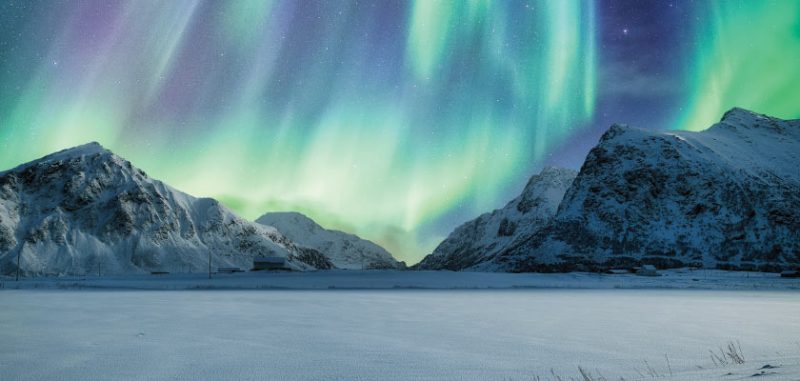
Best Time of the Year to See Northern Lights (Monthly Planner)
Trying to work out the best time of the year to see Northern Lights? In this month-by-month guide to the Aurora we share the best…

Best Place and Time to See Northern Lights 2020-2035
Want to know exactly where and when to see Northern Lights? Discover the best place and time to see Northern Lights across the globe, inc…

5 Great Short Tours to Northern Lights ICELAND
Looking for the best short tour to see Northern Lights in Iceland? In this article, we share some of the most popular short tours to…

5 Most Popular ICELAND Northern Lights Vacation Packages (2022-2023)
Considering a trip to Iceland to see the Aurora? Here we share 5 of the most popular Iceland Northern Lights vacation packages taking bookings for…
8 Reasons Why August Is The Best Time To Visit Iceland
Check out why August is the best time for travelers to visit Iceland and what travelers can do in the land of ice and fire.
Sarah Rand • Apr 25, 2024
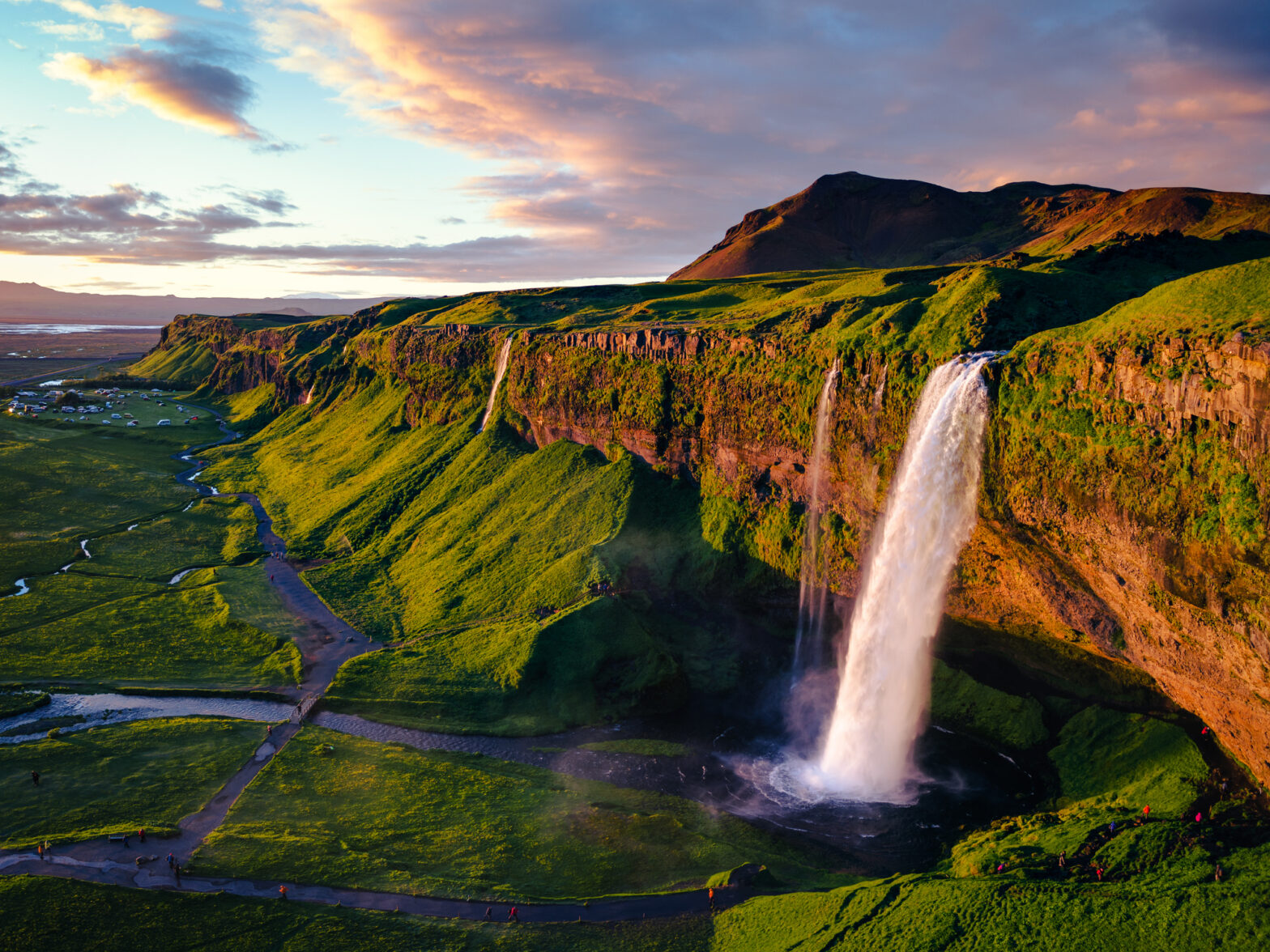
Iceland is a European country that is well known for its stunning glaciers and volcanoes. The Nordic island nation is home to striking national parks, thriving wildlife, and an intriguing viking history. Its most visited and highest populated city is Reykjavik, the capital of Iceland . The country also has friendly locals and a diverse landscape. This landscape includes mountains, glaciers, volcanoes, rivers, and caves. The natural environment of Iceland has made it a favorite destination for snow sports, which has enticed travelers from near and far. Iceland is so popular that it attracts over two million travelers per year.
Unfortunately, travelers do not always get a chance to see some of the country’s best attributes . Much like any other travel destination, there is an ideal time to visit. Depending on the time of year, some travelers may not see much of anything due to factors that can not be controlled. The best time to visit Iceland depends on many factors and even a traveler’s personal preferences.
Overall, August is the best time to visit Iceland, during its high season. Although August is one of the most popular times to travel to Iceland, travelers can still avoid crowds if they choose to. Iceland is generally not considered overcrowded so a visit in August is still pleasant. Visiting the top attractions either earlier or later in the day usually resolves concerns about crowds.
There is plenty to see and do in Iceland during August, so travelers will not find themselves lacking a reason to visit. Check out what things make this month the best time to visit and what travelers should expect.
Average Temperature This Time of Year
- The average temperature in Iceland during August is around 46-55 Degrees F
The Best Weather
During August, the summer temperatures and fall foliage are present in Iceland. This mix brings mild temperatures and a cool breeze. Although temperatures in the 50s may seem low to some travelers, in Iceland the weather is quite warm. This month is a time that locals and visitors dress more warmly, so summer attire is still appropriate. Many travelers enjoy all kinds of outdoor activities during August thanks to favorable weather.
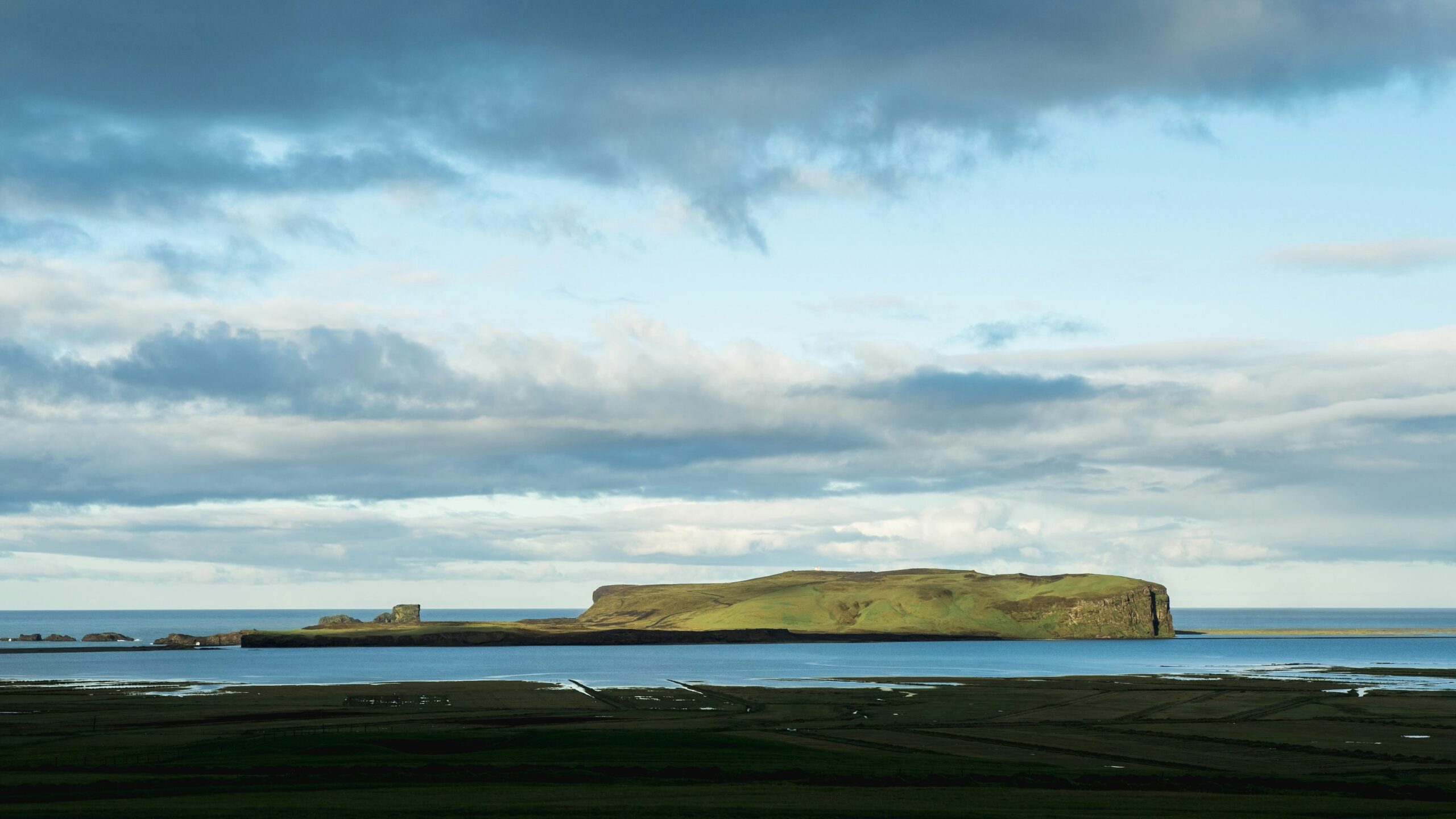
Travel Tips :
- Average Temperature This Time of Year: 46-55 Degrees Fahrenheit.
- River rafting, camping, sea kayaking, and hiking are among the most popular outdoor activities that travelers can enjoy.
- Visiting a waterfall, hot spring, or a dramatic fjord is a great way to enjoy the vast natural beauty of Iceland, especially in August.
The Next Solar Eclipse
The Europe 2026 solar eclipse is expected to occur in August. The eclipse will happen on August 12th, 2026 to be exact. In Reykjavik, Iceland the solar eclipse can be seen at 4:47 p.m. The early projection of the event means that travelers can plan their vacations well in advance. Along with the striking beauty of Iceland in August, travelers who visit in 2026 will be able to observe the first European total solar eclipse in 27 years. Seeing a solar event like this is a unique experience, which is why August is the best time to visit Iceland.
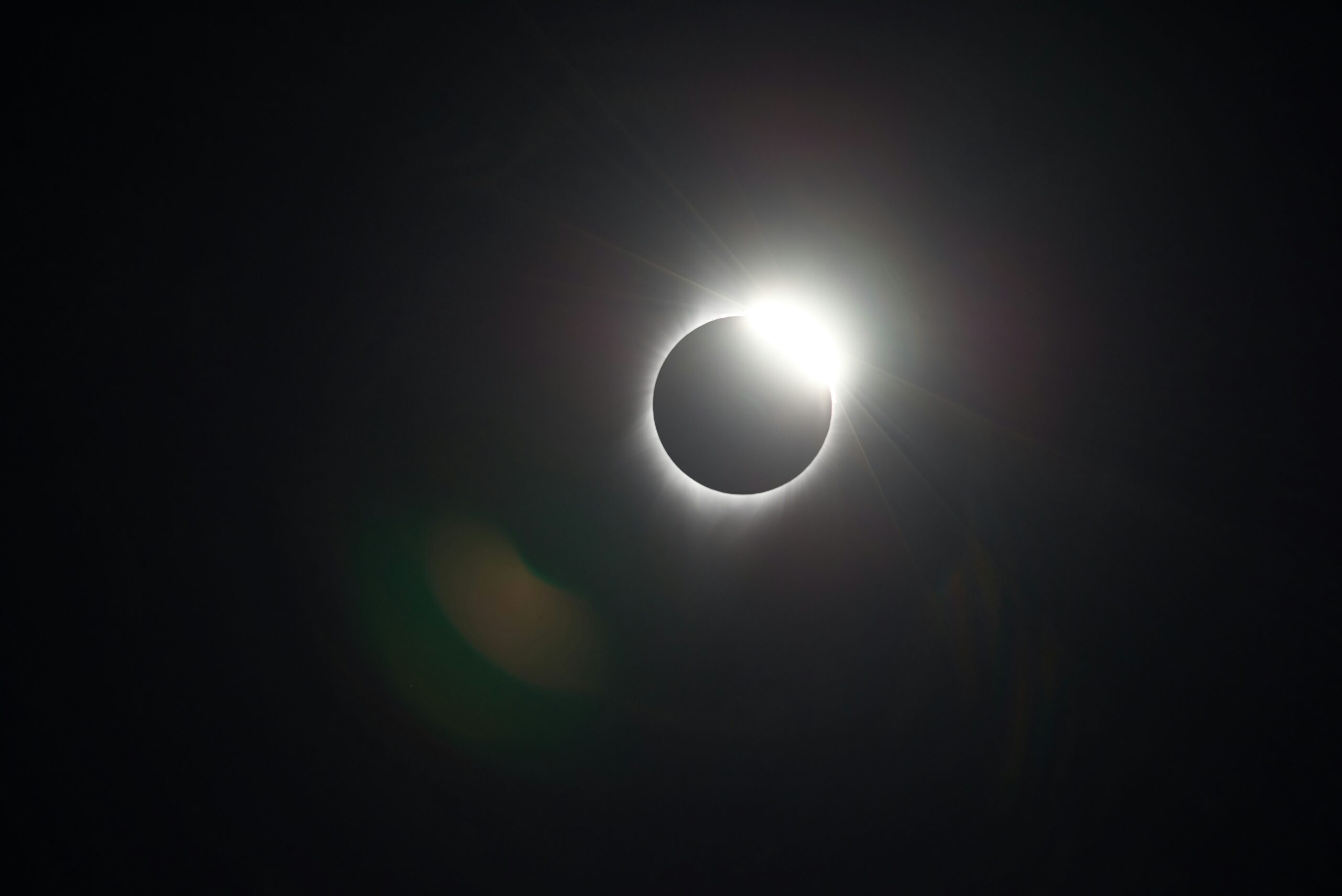
Travel Tip :
- The last European total eclipse was Aug. 11, 1999, so people will gather from far and wide to witness the next one. There are already cruises and tours centered around the event so travelers should secure their travel plans early.
The Midnight Sun
August is the peak of summer in Iceland and travelers can observe the midnight sun. It marks a period when Icelanders can expect a unique natural transition due to the country’s location. Earth’s circulation happens in an elliptical orbit and the planet’s axis is tilted away from and towards the sun for six-month periods.
The beginning of August in Iceland has dark skies and technically long days. These long days mean that the sun is up for 24 hours. This phenomenon is intriguing but, rightfully, some locals celebrate when the midnight sun season is over. Since the sun is out significantly longer than people are used to, locals recover from the sleep they lost during the nearly all-day sunny skies. However, visitors appreciate the extended time to enjoy the August sun. Travelers can expect the midnight sun season to be reaching its end around late August when the nights are longer.

- Seljalandsfoss Waterfall is one of the most ideal places to visit during the midnight sun season. After a nearly two-hour drive from Reykjavik, travelers can watch as the sun catches the waterfall cascading down.
The Northern Lights
The aurora borealis is a famous feature of Iceland . It is even considered one of the country’s most cherished natural attractions. Travelers can sit in awe as the night sky illuminates with green, red, pink, purple, orange, and blue seemingly otherworldly lights. Generally, between late August and mid-April the Northern Lights can be viewed. Much of that visibility depends on the time of year and uncontrollable factors. Travelers visiting near the end of August are in luck since that is when tours start operating. They may be able to catch the first aurora borealis sightings of the season.
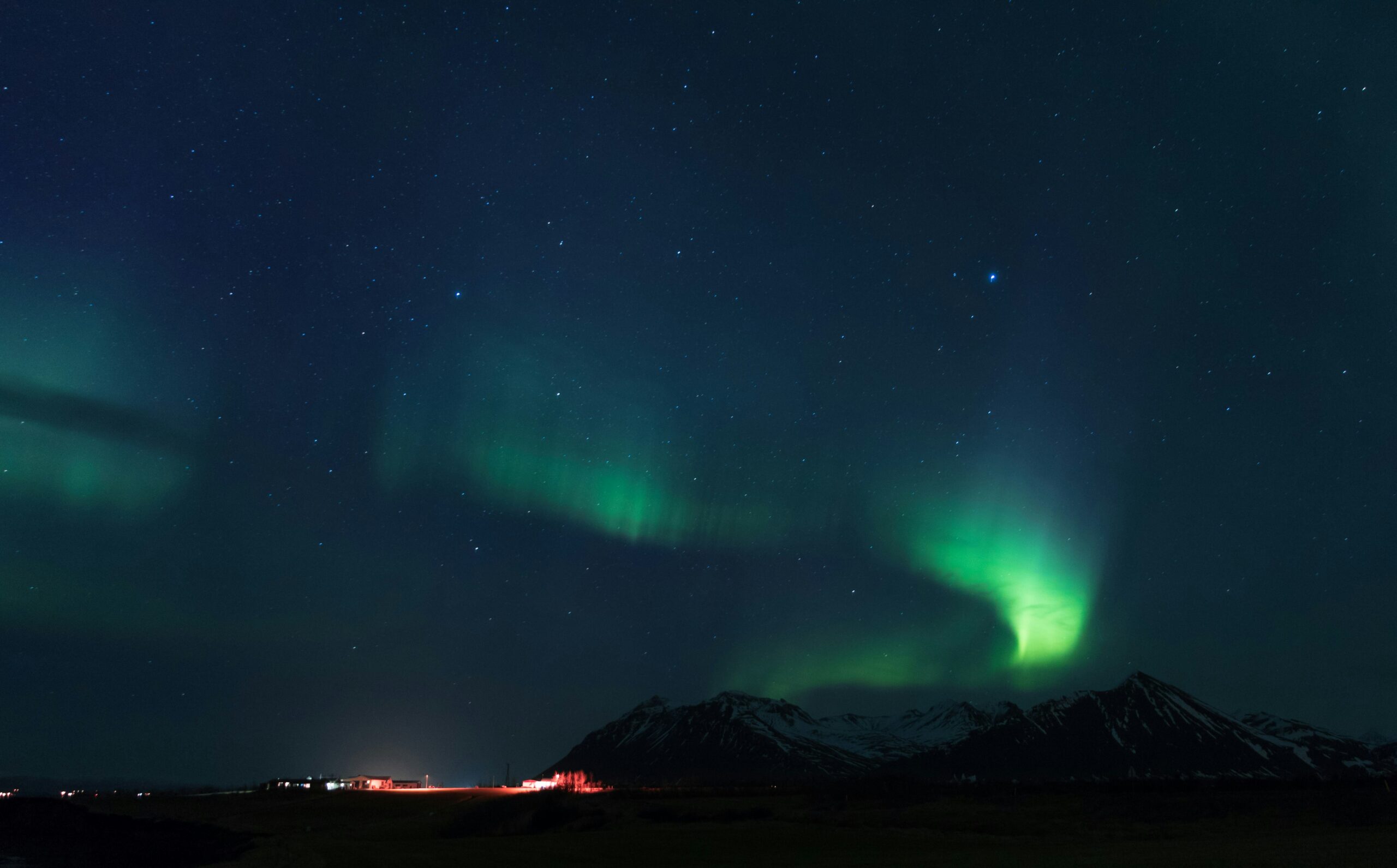
- Travelers determined to see the lights should visit in late August since the month is the start of viewing season. It is wise to book tours with experienced locals to reach the best viewing spots.
Hiking is a very popular activity in Iceland, particularly in August. The summer months are the best time to enjoy outdoor activities, so it is no surprise that August is attractive for this reason. The weather conditions of August are ideal for safe hiking. It is also one of the least stormy months and with warmer temperatures, which makes the terrain drier. The non-slippery rocks and midnight sun make for maximum visibility and comfortability. The trails of Iceland are also open for hiking in August.

- Travelers hiking in August should wear thermal clothing and waterproof hiking boots to make sure they are exploring as safely as possible.
- One of the most popular places to hike in August is the Highlands, where the highest peak in Iceland can be found (Hvannadalshnukur Mountain in Vatnajokull National Park).
Puffin & Whale Watching Tours
Travelers who visit Iceland in August are in for a treat since there are dedicated puffin and whale tours. Combo sightseeing tours which provide great views to both creatures are available as well. Puffins are adorable, mild-mannered birds that live at sea but nest on rocky cliffs. They lay their eggs in early summer and are very active then so August is the best time to have this Icelandic experience. Tourists commonly spot humpback whales during visits in August but boat tours offer intimate viewings of the majestic creatures. Whale watchers will enjoy a visit during August since this is when they are the most lively.
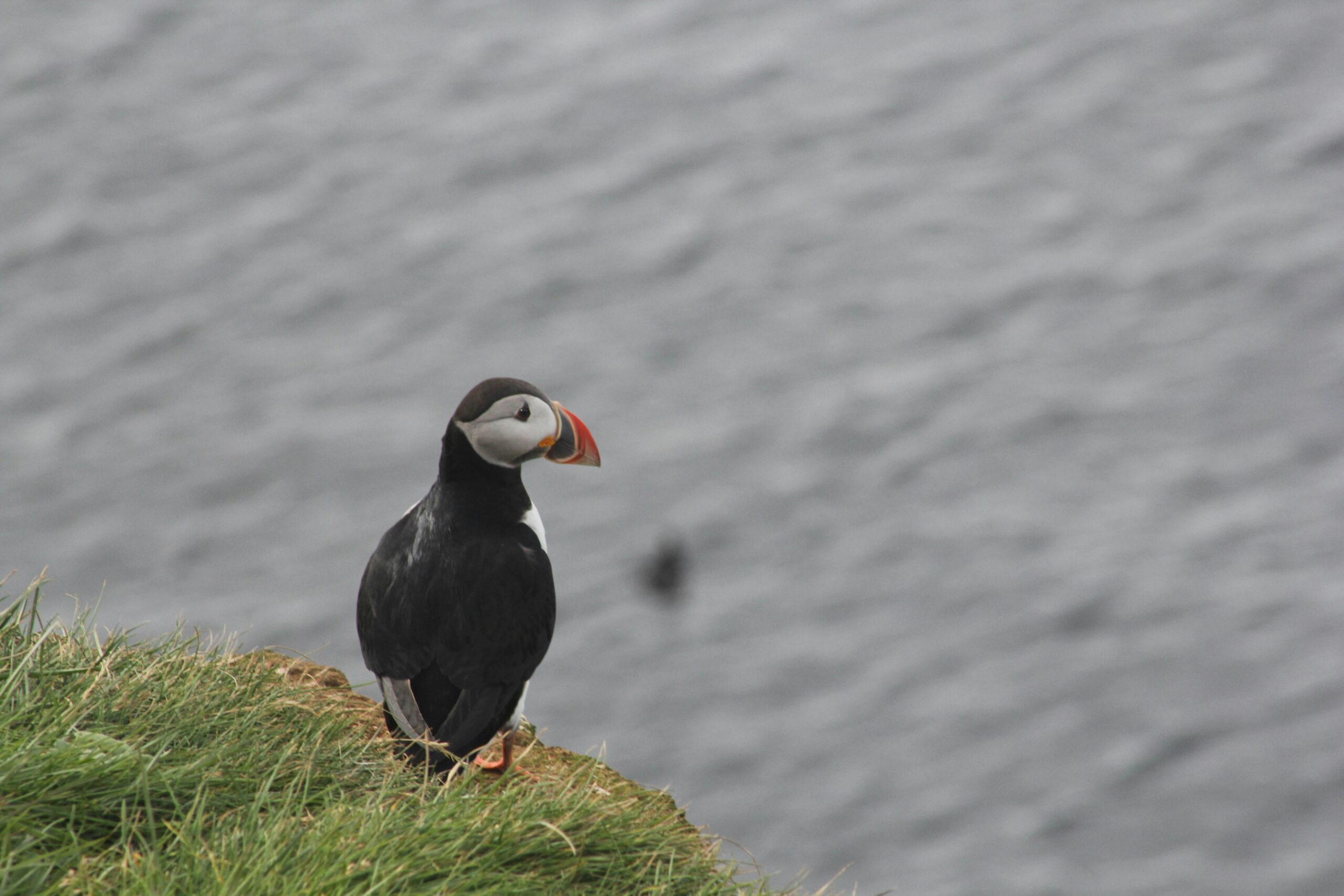
- Puffins are found exclusively in the North Atlantic Ocean, so Iceland is a top destination for viewing them apart from the very few other coastal areas. Travelers are encouraged to see puffins in Iceland since it is home to at least 60% of the world’s Atlantic puffins.
The Blue Lagoon
The Blue Lagoon is one of the most popular tourist sites in Iceland. It is a geothermal lagoon with healing waters that are found nowhere else in the world. It is a resource for silica, algae, and minerals that are said to have restorative powers. The Blue Lagoon is open every day of the year and has many impressive features for visitors to enjoy. There is a retreat spa, and several restaurants and hotels on the grounds. Travelers from all over the world come to Iceland to experience the skin-nourishing seawater. Visiting during the midnight sun season may be the best time to visit Iceland since there is more visibility.

- Until around mid-August, the Blue Lagoon is open until midnight. The most popular time to visit is between 9 a.m. to 1 p.m. To avoid crowds travelers can visit during the early morning or late afternoon.
- Entrance to the Blue Lagoon requires tickets that depend on daily availability. So travelers should get their tickets ahead of time.
Merchant’s Weekend
Merchant’s Weekend, or Verslunarmannahelgi (in Icelandic), is a popular event in Iceland. The weekend is near Commerce Day which is a public holiday in Iceland, celebrated by locals since 1894. It typically occurs during the first week of August and is comparable to Labor Day weekend which Canada and the United States observe. Many people choose to relax, go to festivals, or go camping during the weekend. This event and some others are during August so it is clear that this month is the best time to visit Iceland for activities.
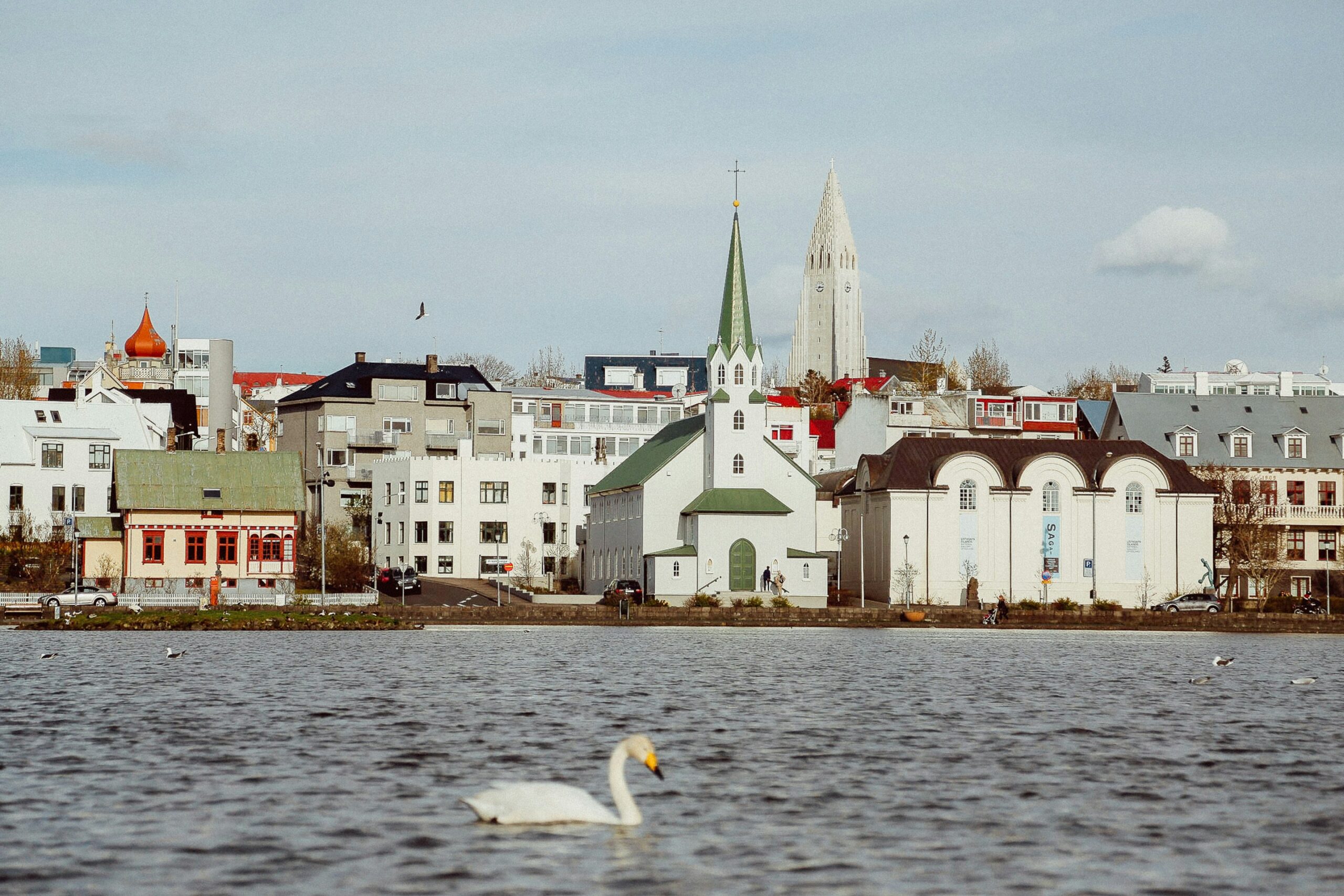
- One of the most popular festivals to attend is the Þjóðhátíð í Eyjum (Festival of the Nation) in Vestmannaeyjar (the Westman Islands), which takes place on Aug. 24-25 this year.
Overall, Iceland is a scenic and enjoyable place to visit. Travelers trying to optimize their time abroad should plan a trip to Iceland during August. They will experience some of the country’s best weather, awe-inspiring sights, and most exciting events. August is the best time to visit Iceland for many reasons but travelers should note that the country is truly incomparable during this time of year.
Subscribe to travel noire
Get more travel content
Subscribe to Travel Noire, a free daily newsletter that features the best of travel, destinations, and guides to the cities you love from a new point of view — yours.
By subscribing to this newsletter, you agree to our terms of service and privacy policy.
Popular posts
Trending stories in world travel
Best time to visit Iceland

The best time to visit Iceland is between September and March to see the Northern Lights, or between June and August for summer activities. While travel to Iceland may depend on your desired itinerary, generally, the best time to visit is during the summer. During this time, you’ll experience warmer temperatures and long days of sunlight, known as the spectacular midnight sun. While the summer boasts green countryside and animal spotting, the winter is the best time for the Northern lights and the country’s famous geothermal spas when they may not be as busy!
However, if you’re planning a trip to see something specific, such as the puffin or whale migrations, you’ll need to visit during a specific time of year. We've broken down some main factors to consider before choosing when to travel to Iceland.
The phenomenal cosmic light show, known as the aurora borealis or the northern lights, is a natural event that occurs from late September to late March. The long and dark winter nights make it an ideal time to visit, however, because it is a sporadic event, a definite sighting can't always be guaranteed. You may be more likely to see the lights during the equinoxes that occur around the 21st/22nd of March and September.
Iceland’s famous Blue Lagoon is a year-round natural geothermal pool that is said to have healing properties and is situated among a scenic Icelandic landscape. This mineral-rich seawater contains a mix of silica, algae and other bioactive elements that can be particularly beneficial for certain skin conditions.
While the lagoon is open all year, if you’re hoping to visit with slightly warmer weather, you may want to visit in the summer months (May to August). That said, many travellers love to visit the springs in the winter months to be surrounded by the beautiful snowy hills of the region while they relax in the outdoor lagoon.
The Icelandic coastline is famous for its whale activity due to the cold waters and favoured feeding grounds of the local marine life. Between April to September is the best time to visit Iceland for whale watching as this is when the whales migrate north for the summer months. Keep a look out for humpback, minke, fin, sperm or even blue whales! You might even see other marine species such as orcas, dolphins, seals or harbour porpoises.
Best for: Þorrablót Mid-winter Festival and ice caves
While mid-winter weather and short days may deter some travellers, the colder months are also perfect for ice cave exploration and catching a glimpse of the Northern Lights. However, if you’d like to stay out of the weather, why not partake in the honouring of the Icelandic ancestors during the Thorrablot festival? While visiting in January, join locals on a historical Icelandic food tour that includes foods such as hangikjot (flavoured smoked lamb) or brennivin (a local distilled beverage).
Best for: Winter Lights Festival and Northern Lights
February is one of the best times to visit Iceland for some exciting food and cultural events. The two festivals, Winter Lights and Food & Fun are hosted annually by the capital Reykjavik and can add spark some joy in the coldest and wettest months of the year! But keep a watchful eye out for the Northern Lights.
Best for: Northern Lights, winter sports, Iceland Winter Games and the Annual Beer Festival
The longer and brighter winter days of March make it an advantageous time for winter sports. If you’re looking to downhill or cross-country ski, snowboard, snowshoe or hike the terrain, the nearest mountain is only a 20-minute drive away from Reykjavik.
Best for: puffins and golden plover migration, The Golden Circle and smaller crowds
April marks the start of the spring season in Iceland and the breathtaking return of several local bird species, including the world-renowned puffins and golden plovers. While the locals celebrate the first day of summer shortly after April 18th, this month is a perfect time to visit for lower off-season prices and fewer tourists. Remember that there may still be an assortment of rain, snow, hail or shine, so pack accordingly.
Best for: whale watching, nature adventures and long days
May in Iceland sees the end of the cold winter months, however, temperatures still sit between 1-11 degrees Celsius although there is less chance of snow. Towards the end of May, there can be up to 20 daylight hours which makes it a great time to do some fun outdoor adventures. Why not take a tour through the lava caves, hike your way across a glacier, snorkel or scuba dive in Icelan's pristine waters or even horseback ride along the countryside?
Best for: midnight sun, Hafnarfjörður Viking Festival, National Holiday of Iceland, Fisherman’s Day and the opening of some highland roads
Summer has arrived! With summer comes longer days and the peak travel season so prices are higher and attractions are busier. June is one of the best times to explore the natural wonders of the Icelandic countryside. However, with a great array of cultural, music and environmental festivals, there’s something for every interest. The end of May to the start of June is also the best time to see the famed midnight sun phenomenon in Iceland so make sure you bring a good sleeping mask!
Best for: Braðslan, nature photography and long days
July is the busiest tourist month of the year for Iceland. With sunshine, greenery and longer days, it’s a perfect time to engage in the bustling city life or explore the vibrant natural scenery. If you’re looking for a slightly less crowded time, try to book in for the start of the month before the local schools are on break.
Best for: Reykjavik Pride, Reykjavik Culture Night, National Festival, Verslunarmannahelgi, Þjóðhátíð and wilderness exploration
Visiting Iceland in August usually ensures full access to the country’s wilderness as inaccessible areas in winter are now fully open. As one of the hottest months, the weather in August - while still unpredictable at times – is best for exploring the rugged and idyllic terrain of the glaciers, volcanoes, hot springs and waterfalls of the Icelandic wild. If nature isn’t your thing, the local scene has plenty of events and attractions to fill your itinerary.
Best for: fewer crowds and mild weather
September marks the end of the busy summer months but temperatures can still fall between 5-10 degrees Celsius. With the bulk of tourists on their way home, you’ll find lower prices and smaller lines for attractions. This is a great time to go if you’re looking to surround yourself with great music or film. Note that some highland roads will be closed by the end of the month for winter.
Best for: Northern Lights and berry picking
See the vibrant autumnal colours that blanket Iceland during October as the temperatures lower and leaves drop. As the colder months set in, plan for the Northern Lights as they can easily be seen at this time of year, especially when away from city areas without cloud cover.
Best for: hot springs, ice caves and Northern Lights
November brings winter into full steam with a drop in temperatures and daylight hours. Winter is often the most scenic time to visit one of Iceland’s many hot springs and relax in the white-blanketed scenery. With the drop in temperatures comes the reformation of the ice caves making November a perfect time to transverse the chilly blue caves and stunning glaciers.
Best for: New Year’s Eve, frozen waterfalls, glacier exploration, Christmas villages and festive lights
Looking to party into the new year? Iceland’s eclectic music scene and picture-perfect Christmas villages can provide you with day-to-night entertainment. While December is known as one of the coldest and windiest months, the Northern Lights are often viewable during this time. Just note that some hotels, services and attractions are closed during the winter.
Let's create an exclusive trip for your group.
Why 2024 is the best year to see the northern lights
How the Icelandic hot dog became an international icon
Iceland’s Folklore: 4 mythical creatures that make the scenery come alive
Top 12 things to do in Iceland
6 of the best hikes in Iceland
10 ways to get closer to nature with Intrepid
In sickness and in health: How I ended up getting married on an Intrepid Iceland trip
Iceland or Greenland? Which country should be next on your travel list?

8 Reasons Why March Is the Best Time to Visit New Orleans
N ew Orleans, Louisiana is a popular American city with a deep history and international impact. While the city is known for its celebratory culture and unmistakable cityscape, it offers much more. There are many ways to appreciate the city throughout the year, but travelers will be pleasantly surprised to know more about the best time to visit New Orleans.
The spring time month of March is when travelers can enjoy some of the coolest events, enjoy a laid back atmosphere and immerse themselves in the local culture while they stay there .
March in New Orleans is warmly referred to as Festival Central since there is plenty to do. Learn more about why March is the best time to visit New Orleans and ways travelers can optimize their vacation time there.
March Weather in New Orleans
Springtime weather is a major factor in March being one of the best times to visit New Orleans. The weather is mild, so it is a great time to leisurely enjoy outdoor activities around the city. The real feel during this month depends on the time of the month. However, in general, March is a sunny and pleasant time to visit New Orleans.
Not having to endure rain to enjoy some of the most popular events of the season is another selling point for a March visit to the Big Easy. There is not a significant amount of rainfall, so most travelers should expect light and spotty showers. Since certain areas of New Orleans are very walkable, this is convenient and something to consider before visiting. A few popular outdoor activities include meeting up in public areas and walking with the local community.
Travel Tip :
- Average Temperature This Time of Year: 50-75 Degrees Fahrenheit.
- Travelers should carry a light jacket or mini umbrella in case sporadic, light showers fall.
Let the Good Times Roll at Mardi Gras
Mardi Gras is a time of celebration that occurs before Christian Lent. The celebration lasts until Fat Tuesday. Mardi Gras means “Fat Tuesday” in French. This is significant due to the cultural and historical significance of the French in New Orleans. The holiday even derives from France since it has been celebrated there since the Middle Ages.
There are plenty of things to do at Mardi Gras. Attending parades and exploring the famous Bourbon Street are popular things to do in New Orleans during Mardi Gras. These activities are ideally enjoyed in March when the weather and fun both align. Especially since there is plenty of physical activity to consider.
While the famous celebration attracts a lot of attention, travelers may have to research before they travel to New Orleans in March. Technically, Mardi Gras only happens during March sometimes. The celebrations can occur between February 3rd and March 9th.
Although the celebration is more like a season of celebration as opposed to a single day, travelers should not miss out on the fun of visiting in March. However, for 2025, the carnival celebration happens in March while 2024’s celebration was during February. Travelers can reference the Mardi Gras schedule which is available online and provides accurate celebration days at least 36 years out.
- Travelers visiting New Orleans in March for Mardi Gras should bring comfortable walking shoes since many central areas are mostly walked. This is especially true during the celebratory season where it might be harder to get around via car.
Delicious Southern Cuisine
New Orleans is famous for a few culinary staples and even southern comfort food. Some top foods from New Orleans are beignets, gumbo, jambalaya, crawfish boils, and shrimp etouffee. There are many different popular restaurants in the city that travelers will enjoy. During this spring month, most travelers can enjoy outdoor seating at some of the most popular restaurants.
The city has such diverse culinary influences since many communities from the diaspora live there. Creole, Ethiopian, French, Caribbean, and Haitian restaurants are great options that travelers enjoy after a day of exploring the expansive city. Some Black-owned restaurants in the area that travelers can enjoy during their March visit include Lil Dizzy’s, Jewel of the South, and Vyonne’s.
- Some classic Mardi Gras foods that travelers should try during their March visit include jambalaya, shrimp etouffee, and red beans and rice.
Endless Music in the Birthplace of Jazz
New Orleans is the birthplace of jazz and a destination that is commonly considered a music hub. During March festivities, there is plenty of music and jubilation involved. Jazz is commonly played at popular events throughout the city. From background music in venues to full-out music events, travelers visiting New Orleans during March will enjoy the musical stylings of the city.
A popular March music event in New Orleans is the Mardi Gras Parade & Festival. This event is scheduled to happen on March 8th, 2025 but the date varies. At the event, travelers can enjoy some culturally significant music and dance their worries away. Also, the most popular jazz club in New Orleans is the Preservation Hall.
- There is rarely a lack of music events in New Orleans, especially around March and Mardi Gras. Whether travelers prefer the musical styles of street performers or want to frequent a sultry jazz club, there are options.
Celebrate Women’s History Month
Women’s History Month is in March. While a girl’s trip to New Orleans is often associated with partying, there are plenty of other ways to celebrate the significance of this holiday. Of course, there are still great spots for women who want to celebrate the liberation and accomplishments of their ancestors (and women in their own lives). A popular Black woman-owned spot in New Orleans that travelers can stop by to celebrate is the Nola Sips Snobar and Bistro.
For historic enlightenment, travelers can visit The Historic New Orleans Collection Museum. The museum has a special collection of historic women in New Orleans that travelers can tour during March. There are also historic walking tours that highlight influential women in New Orleans’ history. Travelers looking to do a deep dive into the local history and culture can even access Women’s History Month archives.
- There are many special exhibits, conferences, and webinars in New Orleans that travelers can enjoy during March for Women’s History Month.
New Orleans Museum of Art
The thriving creative industries in New Orleans go beyond music and food. Art is also a great reason to come to the city during March. The New Orleans Museum of Art is an incredibly popular site of remembrance for the artistic contributions of New Orleans natives.
There are widely anticipated showcases every spring, so March is a great time to catch the most interesting installations. For example, “Art in Bloom” was the name of a March 2024 event at the museum. The installation had exquisite floral designs, a luncheon, and a fashion show. There is no telling what types of exhibits will be present in future years, but the reflection of the surrounding nature is an exciting aspect of shows at NOMA.
- There are many renowned museums in New Orleans that travelers can visit and explore during March. The New Orleans Museum of Art is the oldest fine art museum in New Orleans, so travelers should be sure to get tickets ahead of time to get to know the local culture.
St. Patrick’s Day Celebration
New Orleans has a deep Irish heritage, so it is no surprise that the St. Patrick’s Day celebrations are top-rated. Although the holiday technically started as a religious holiday, it is now a grand celebration of Irish culture.
During the weekend of the holiday, March 17, travelers can observe one of the biggest parades in the city. The exciting city-wide celebration of the holiday makes March one of the best times to visit New Orleans. The Irish Channel Parade is one of the biggest events to celebrate St. Patrick’s Day in the Big Easy. It attracts big crowds to the downtown area, so travelers can immerse themselves in New Orleans’ local culture.
- Pat O’Brien’s and Tracey’s on Magazine are two of the most popular places to celebrate St. Patrick’s Day in the city. The ample places to celebrate the holiday make March the best time to visit New Orleans.
New Orleans Entrepreneur Week
New Orleans Entrepreneur Week is a relatively new event that occurs in March. The annual event highlights the thriving entrepreneurial spirit of New Orleans. The event is not a conference but it has been referred to as the Mardi Gras of entrepreneurship.
NOEW is a festival that promotes entrepreneurship and brings together local businesses. The event aims to connect, educate, and inspire attendees. For business-minded travelers, this March event may help advance their organization or introduce them to other innovators.
- This event is held in Gallier Hall so travelers should stay in downtown New Orleans to be close to the venue.
There is so much to see and do in New Orleans during spring. However, for ideal weather, an exciting selection of events, and authentic Louisiana cooking, March offers the best time to visit New Orleans. This time of year is great for travelers who are hoping to experience the city’s top festivities.
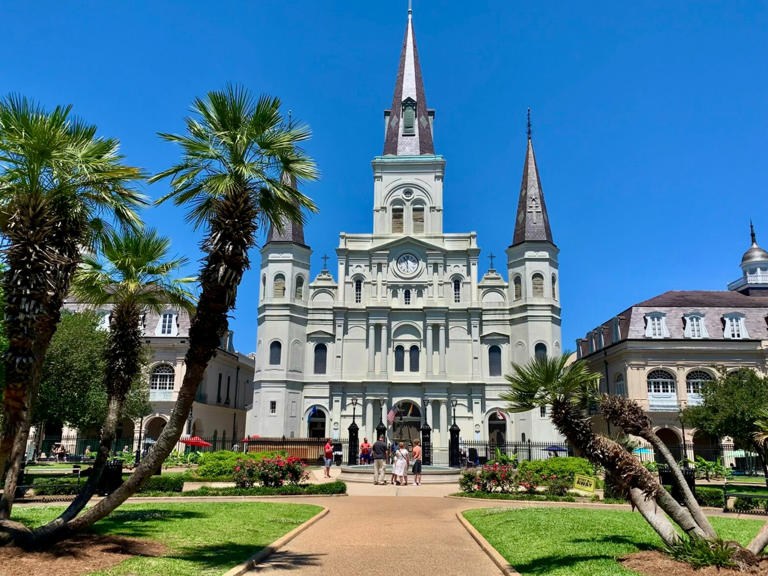

IMAGES
VIDEO
COMMENTS
While the beginning of the month is still as warm as July, temperatures start to go down by the end of the month. August is the best time to go to Iceland if you do not mind the crowds due to the fairly standard daylight hours. The sun sets around 9 PM and rises around 5 AM. August has the least cloudy days as well.
The average low temperature is 28 F (-2.2 C), and the average high temperature is 38 F (3.3 C), making it relatively frosty. The weather in Reykjavik in March tends to be warmer, but even the warmest recorded temperature over the past two decades was only 54 F (12.4 C). And the coldest was 9.5 F (-12.5 C).
Average Rainfall: Around 82 mm, though this can vary depending on the region. Reykjavík Weather in March: Temperature: In Reykjavík, temperatures in March are slightly milder, averaging 0°C to 4°C (32°F to 39°F). Precipitation: A mix of rain and snow, with more rainy days as spring approaches.
ICELAND IN MARCH QUICK FACTS: March in Iceland is packed full of events for visitors to experience. It's the time of year when improving weather conditions make exploring the country an incredible experience and is technically still in low season - meaning you might have better luck with finding cheap(er) accommodation, flights and tour bookings.
June to August is the best time for outdoor recreation. While there's no good weather guarantee, this is your best chance of sun and warmish temperatures. Late June to early August is when most Icelanders go on vacation, filling up campgrounds wherever the best weather is forecast. This is the height of the tourist season - and height of ...
For camping enthusiasts, the best time to visit Iceland is during the summer months, particularly from June through August. This period offers milder weather conditions and extended daylight hours. All the camping sites around the country, including those in more remote highland locations, are generally open and accessible during this period.
March has the most daylight hours of all the winter months, with sunrise in Reykjavík on March 1st at 8:36 AM and sunset at 6:46 PM. That's a whopping 10 hours and 10 minutes of daylight. By the end of March, daylight increases to 13 hours and 26 minutes - a gain of 3 hours and 16 minutes in one month!
August is one of the best times to visit Iceland. It is the warmest time of the year to travel the Arctic Circle, and summer temperatures average around 15°C. Days are similar to most of the Northern Hemisphere, with the sun rising between 5 a.m. and 6 a.m. and setting between 9 and 10 a.m.
The best weather in Iceland occurs in the summer, however, it can still be unpredictable. Iceland's temperatures in summer can be as low as 41 F (5 C) but as warm as 77 F (25 C) during this time of year. On average, Iceland's weather in summer is between 50-59 F (10 to 15 C).
The weather in Iceland in March is most commonly somewhere around 0°c. The average low being -2.2 degrees Celsius (28 F) and the average high 3.3 degrees Celsius (38 F). March can be a bit rainy so prepare by bringing a waterproof jacket. The farther North you go the rain might switch out for snow.
The best time to visit Iceland is between September and March to see the northern lights, or between June and August for summer activities. While travel to Iceland may depend on your desired itinerary, generally, the best time to visit is during the summer. During this time, you'll experience warmer temperatures and long days of sunlight ...
Best Times to Visit Iceland for Good Weather. During the summer months — July and August — the temperature in Iceland hovers around 50 to 55 degrees Fahrenheit, making it a popular time to ...
Best time to visit ice caves in Iceland. The best time to visit ice caves in Iceland is in the winter since the caves require low temperatures to form large masses of ice. The summer temperatures in Iceland are too warm to sustain the caves, so if you want to see these unique formations, plan your trip between mid-November and mid-March.
Best Time to Go to Reykjavik. Reykjavik, Iceland's vibrant capital city, is great to visit at any time of year. In the summer, the city gets around 21 hours of daylight and experiences the best weather. Maximum daytime highs reach into the high teens with precipitation at its lowest. While summer offers great weather, it comes at a price.
Discover when is the best time to visit Iceland in this month-by-month guide to one of the world's top travel destinations. It's not when you think. ... However, the average temperatures remain cold, but warming ever so slightly to 0.3° C (33° F). During March, about half of the days involve precipitation, which could be rain or snow ...
For most visitors, the best time of year to visit Iceland is undoubtedly summer, since the daylight stretches to 20-plus hours, and even the most remote regions become accessible. But the shoulder seasons in May and September are a chance to avoid the heavy crowds, and winter to spring, spanning from October to April, shows a completely ...
2. Summer under the midnight sun | June, July & August. In summer, you are treated to the warmest time of year and up to 24 hours of daylight. The average temperature sits around 14 Celsius (57 Fahrenheit) so you'll never be retreating for the shade after a long glacier hike or nature walk.
Here are some ideas for things to do in Iceland in March: Take a whale watching tour from Reykjavík or Húsavík. Go glacier hiking and snowmobiling on Langjökull. Relax and unwind in the Blue Lagoon geothermal spa. Join ice cave tours in Vatnajökull National Park. While away the evenings chasing the Northern Lights.
Outdoor lovers and hikers consider the best time to visit Iceland is July and August where temperatures are moderate and there are plenty of activities on offer. And February, March, September and October (spring and fall in Iceland) are considered the best months to visit Iceland by those seeking to see the Aurora Borealis.
You may even be treated to the northern lights, which can generally be seen, when conditions are right, from about late September through late March. (Average Max Temperature: 9°C. Average Precipitation: 40mm.) Iceland Weather in October: By the end of October, it starts to feel like winter in Iceland.
The best time of the year to see the northern lights in Iceland is undoubtedly the winter months. However, throughout these months, Iceland endures its worst weather. Clouds can block the sky, and therefore the aurora borealis, for weeks at a time. Storms are also more common this season, occasionally leading to the cancellation of tours or the ...
By now, you should have a pretty good idea of Iceland northern lights month and time of year options for your aurora vacation. To summarize quickly, the best month to see northern lights Iceland is September to April. To fine-tune that time period, you may like to consider September-October or February-March for your trip.
Visiting during the midnight sun season may be the best time to visit Iceland since there is more visibility. Photo credit: Daniel Schoibl. Travel Tips: Until around mid-August, the Blue Lagoon is open until midnight. The most popular time to visit is between 9 a.m. to 1 p.m. To avoid crowds travelers can visit during the early morning or late ...
The best time to visit Iceland is between September and March to see the Northern Lights, or between June and August for summer activities. While travel to Iceland may depend on your desired itinerary, generally, the best time to visit is during the summer. During this time, you'll experience warmer temperatures and long days of sunlight ...
Springtime weather is a major factor in March being one of the best times to visit New Orleans. The weather is mild, so it is a great time to leisurely enjoy outdoor activities around the city.